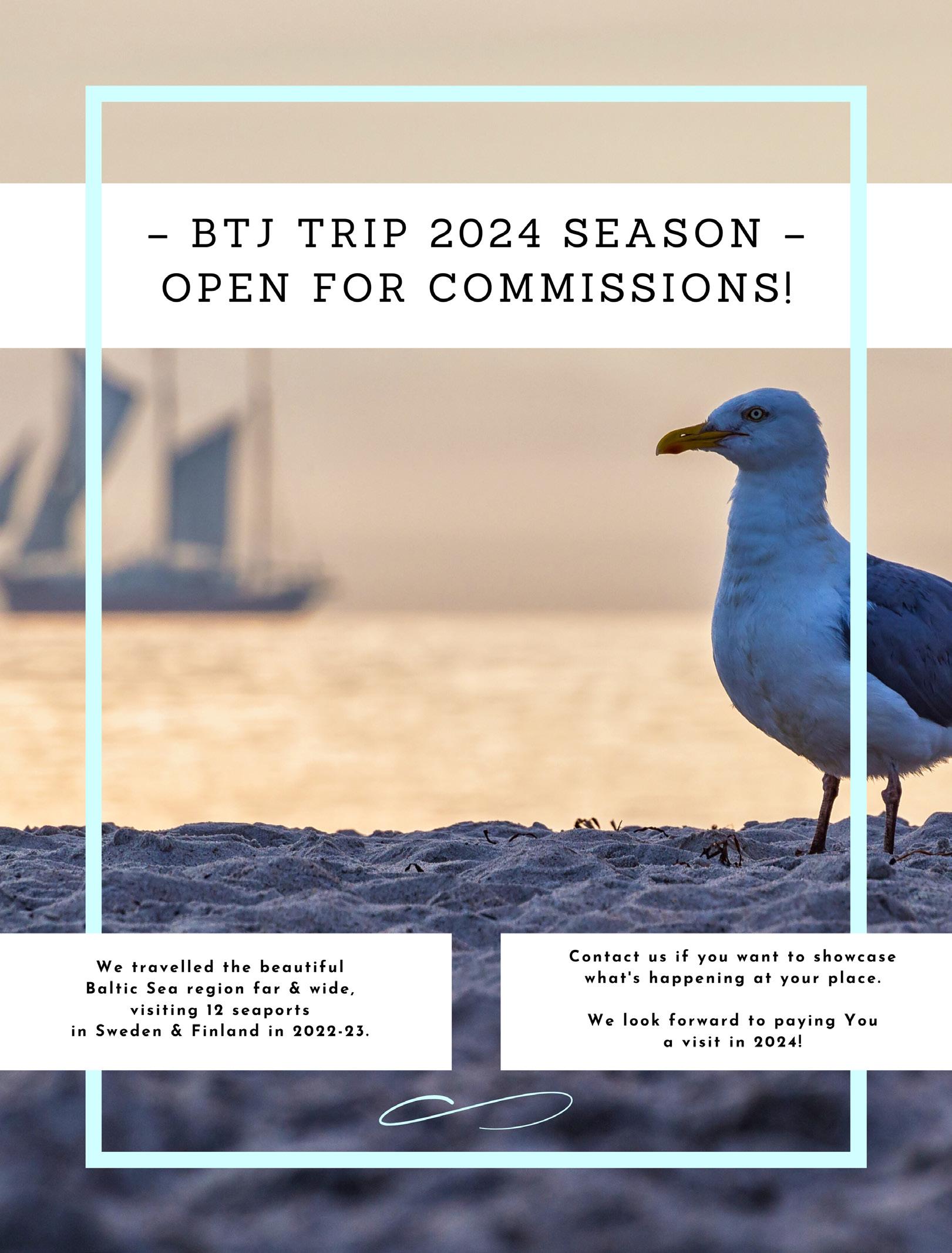Baltic Transport Journal
REPORT
Baltic transport 2023 highlights
SUSTAINABILITY Collecting solar power – offshore
TECHNOLOGY
Can a single maritime AI research project cut 1% of total global emissions?
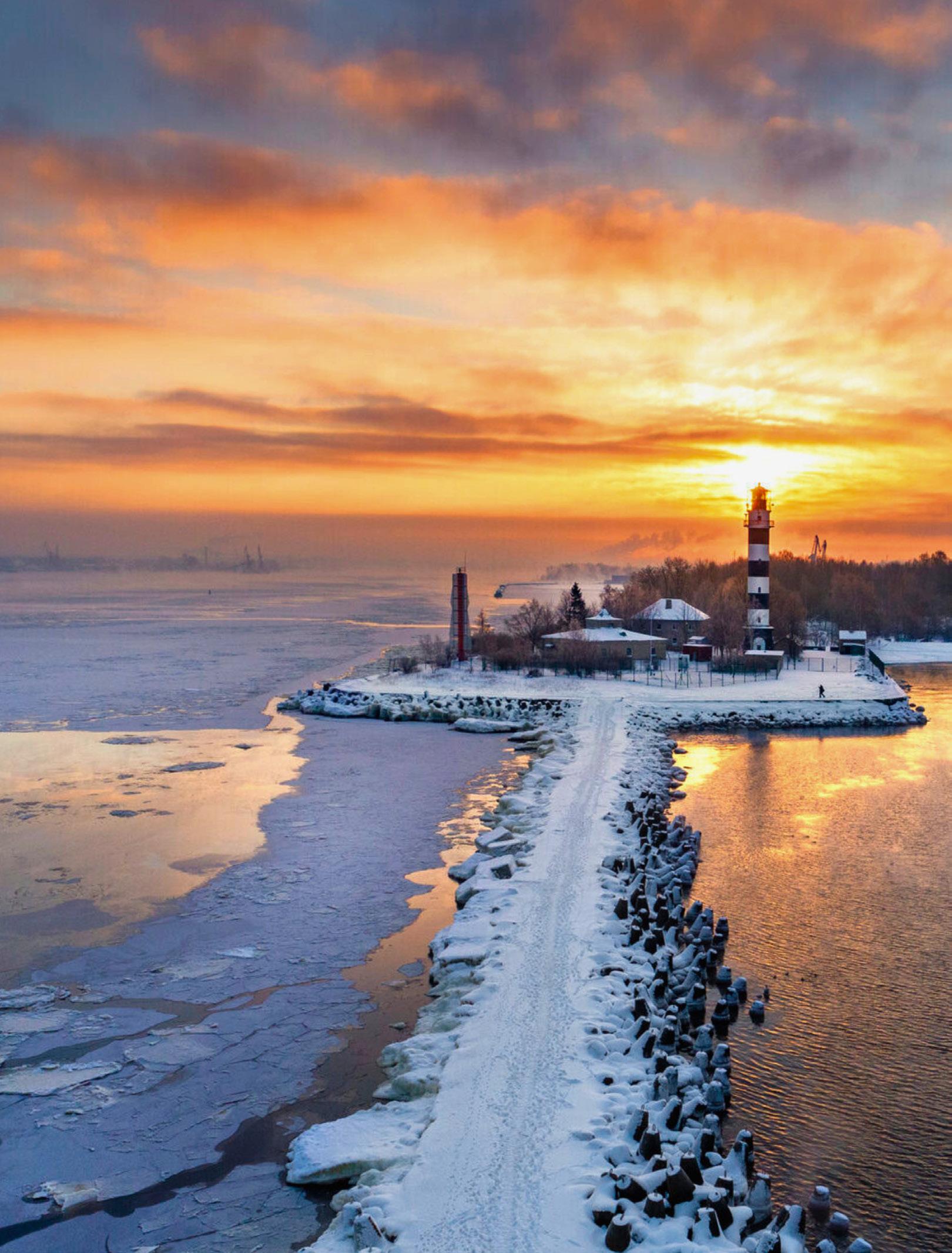
MARITIME
How a Baltic cruise ferry rescued a Finnish sailor in the middle of the Indian Ocean
OFFICIAL MEDIA PARTNER OF: ISSN 1733-6732
bimonthly-daily companion
LEGAL Advances in technology aiding
№ 1/2024 (117), JANUARY/FEBRUARY
seaport and terminal security
The Port of Opportunities
The Port of HaminaKotka is a versatile Finnish seaport serving trade and industry. The biggest universal port in Finland is an important hub in Europe and in the Baltic Sea region.
Welcome to the Port of HaminaKotka!

haminakotka.com
Dear Readers,

Isincerely hope you had a fantastic end of 2023, a much-needed & deserved break in between the years, and a smooth start to the rolling 12 months.
The first issue of 2024 may seem a bit husky, but that’s because the latest round-up of Baltic transport highlights is probably the biggest we have produced thus far: 25 pages! That is a looong read if I ever saw one! The summary brings, first & foremost, a heavy chunk of all things green as the Baltic Sea region continues to pep its sustainability game.
The digest goes hand-in-hand with the Baltic Green Map we’re working on, a snapshot of the various green developments already in place, ‘under construction,’ or in the pipeline throughout our beautiful & pioneering corner of the world. We have prepared a video that details what you can expect from our newest map. It also introduces the accompanying Baltic Green Map Catalogue , a publication that further specifies what can be found on the map under the various icons. And there’s the other side of the Baltic Green Map: the Baltic Offshore Wind Energy Map that’s peppered with the existing & planned wind power harvesting farms in the region.
Other than that, the 1/24 edition is, as always, packed with topical reads. ‘Talking green,’ the Sustainability column brings forth a project tasked with making the Port of Hirtshals not only a carbon capture & storage hub – but the biggest one in Europe! There are also pieces on collecting solar energy – but out there in the open sea! As well as articles on storing methanol on board vessels, the challenging particulars of decarbonising dry bulk carriers, and the Sustainable First Movers Initiative and its toolbox, which, I believe, can come in handy in the Baltic, too.
The Legal section goes in depth & breadth about port security, likewise analyses stern tube damages and unpacks the concerns with shipping lithium-rich minerals for the increasingly battery-hungrier global market. The Maritime column is very, very Baltic in its nature, though not without a twist here & there. While the article on the most recent developments in HaminaKotka keeps us within the region, Finnlines’ other Superstar ferry will take you to the Indian Ocean, while Elomatic’s piece to Canada.
And, naturally, I just couldn’t end without mentioning what we cooked up for you in the Technology section. Starting with how artificial intelligence (AI) in shipping can decrease global emissions by 1% (yup, you read that right); through how AI, green shipping corridors, and digitalisation are redefining maritime operations; what are the dual benefits of digitalising the shipping business; ways of tackling the data scrapping menace; to how port operations can change thanks to digital identity verification.
With this, I wish you nothing but the most splendid reads and all the best in 2024 (these two go together, as I’m sure you already know perfectly)!
Oh, and don’t forget that the BTJ Trip season is open – we’ll be more than happy to visit your port to share what fascinating things are happening at your place with the other readers!
Przemysław Myszka
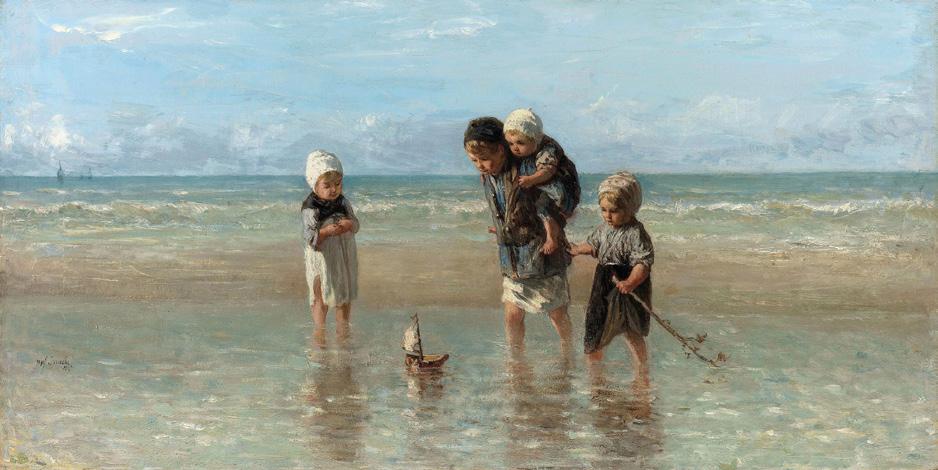
Baltic Transport Journal
Publisher
BALTIC PRESS SP. Z O.O.
Address: ul. Pułaskiego 8
81-368 Gdynia, Poland office@baltictransportjournal.com
www.baltictransportjournal.com
www.europeantransportmaps.com
Board Member BEATA MIŁOWSKA
Managing Director
PRZEMYSŁAW OPŁOCKI
Editor-in-Chief
PRZEMYSŁAW MYSZKA przemek@baltictransportjournal.com
Roving Editor MAREK BŁUŚ marek@baltictransportjournal.com
Proofreading Editor EWA KOCHAŃSKA
Contributing Writers
JOHN BALAOURAS, NIRAJ BHATT, NEIL DALUS, KOSTAS GKONIS, KADRI HAUFE, RAMI HIRSIMÄKI, GRANT INGRAM, ALEXA IVY, CASPER JENSEN, SVEND LEO LARSEN, JAANA NIEMI, ANISA RIZVANOLLI, MONIKA ROGO, FITZWILLIAM SCOTT, JOHN SOUTHAM, LEE STENHOUSE, EMMANUEL VERGETIS
Art Director/DTP DANUTA SAWICKA
Head of Marketing & Sales
PRZEMYSŁAW OPŁOCKI po@baltictransportjournal.com
If you wish to share your feedback or have information for us, do not hesitate to contact us at: editorial@baltictransportjournal.com
Contact us:
PRZEMYSŁAW OPŁOCKI tel.: +48 603 520 020
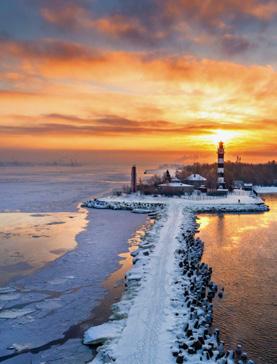

EDITORIAL 1/2024 | Baltic Transport Journal | 3
Children of the Sea by Jozef Israëls, photo: Artvee
Cover Port of Riga Subscriptions Go to www.baltictransportjournal.com and click: SUBSCRIPTION or contact us at subscription@baltictransportjournal.com ISSN 1733-6732 REPORT Baltic transport 2023 highlights Baltic Transport Journal bimonthly-daily companion SUSTAINABILITY Collecting solar power – offshore LEGAL Advances in technology aiding seaport and terminal security № 1/2024 (117), JANUARY/FEBRUARY TECHNOLOGY Can a single maritime AI research project cut 1% of total global emissions? MARITIME How a Baltic cruise ferry rescued a Finnish sailor in the middle of the Indian Ocean
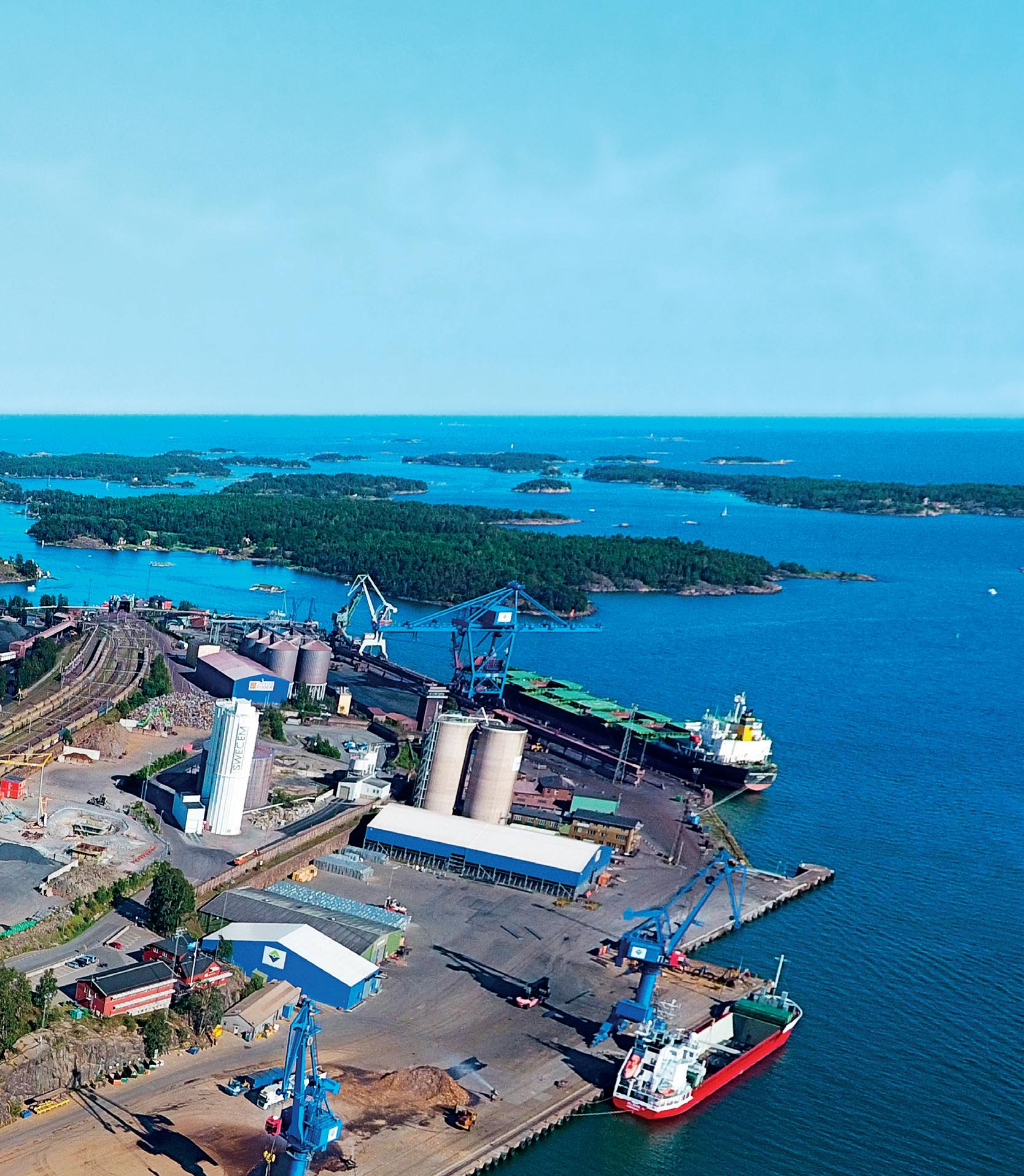


3 REGULAR COLU MNS
3 Editorial
8 BTJ calendar of events
9 Safety news by TT Club
10 Market SMS
12 What’s new?
14 Map news
16 Venture forth
18 Chart of the issue: Global Maritime Trends 2050. What does the future of the maritime industry look like?
22 What’s in the Cabinet
90 Transport miscellany
92 Who is who

24 As safe as ports?
– Advances in technology aiding seaport and terminal security by Neil Dalus
26 A concerning new trend?
– Increase in stern tube damages by John Balaouras and Svend Leo Larsen
28 Rock-solid shipping
– A surge in lithium demand raises stability concerns over transporting its minerals by John Southam and Lee Stenhouse
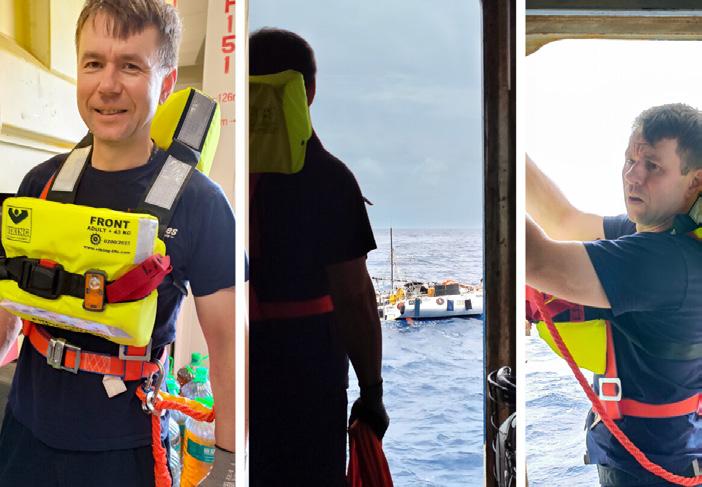
30 MARITIME
30 Keeping an upright position while on a bumpy road
– An eventful year for the Port of HaminaKotka by Jaana Niemi
32 Assistance at sea
– How a Baltic cruise ferry rescued a Finnish sailor in the middle of the Indian Ocean
34 Designed in the Baltic
– Working on Canada’s largest & most powerful Polar icebreaker by Rami Hirsimäki
36 SUSTAINABILITY

36 Leap forward for an ambitious carbon capture & storage project
– The Port of Hirtshals to become Northern Europe’s largest CO2 hub by Fitzwilliam Scott
38 ‘Adversity is the mother of progress’
– The Sustainable First Movers Initiative by Ewa Kochańska
44 Know the differences to make a difference
– The challenges with decarbonising bulk carriers by Kostas Gkonis and Emmanuel Vergetis
46 The energy transition’s new duck in the pond
– Collecting solar power – offshore by Alexa Ivy
48 Turn up the volume!
– Addressing the storage challenge of methanol as a marine fuel by Fitzwilliam Scott

CONTENTS 1/2024 | Baltic Transport Journal | 5
24 LEGAL
Moves a lot. Changes everything.
With a maximum lifting capacity of 1,600 tons, our travelling cargo crane TCC 78000 will drive your heavy-duty projects to success. www.liebherr.com
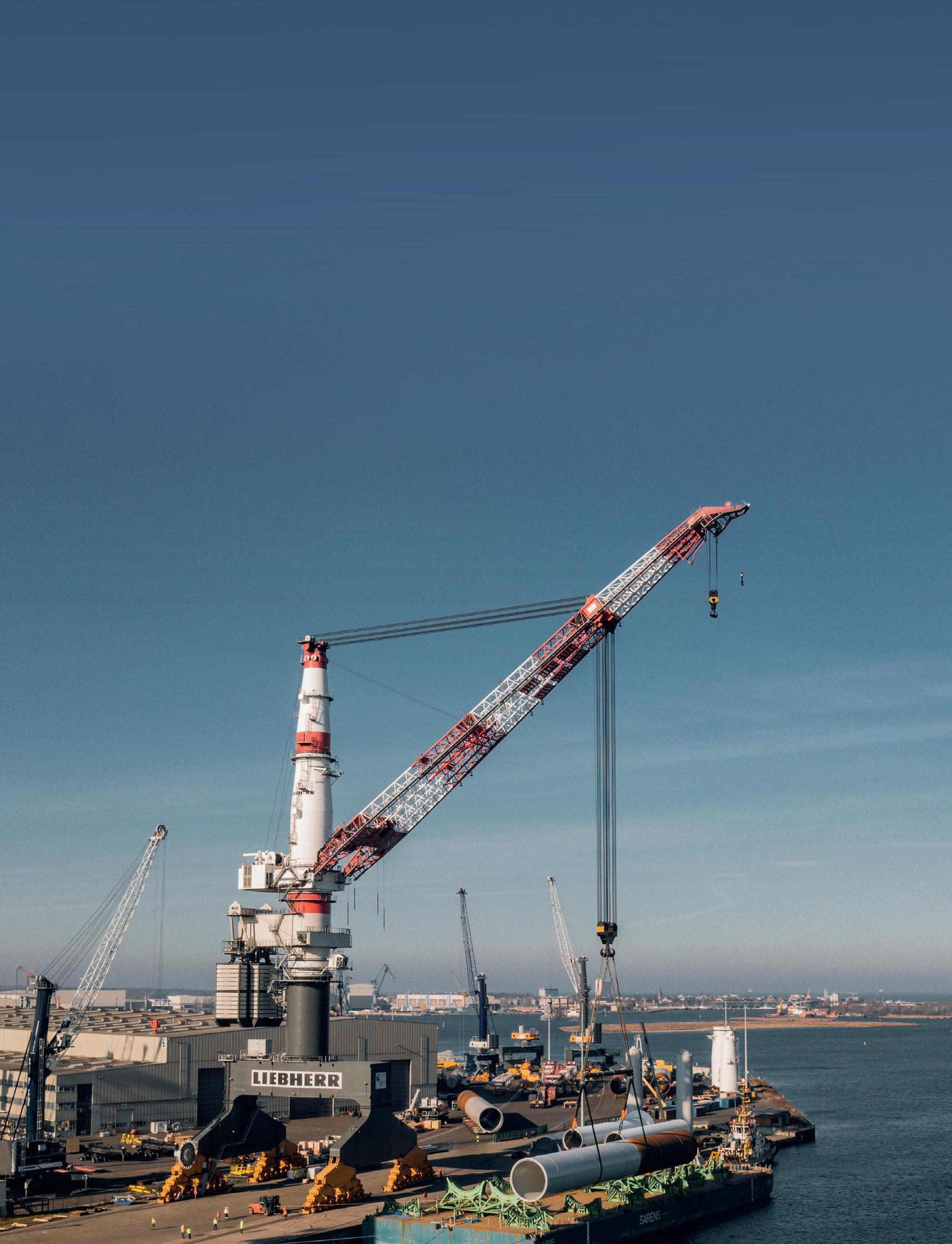
Maritime cranes




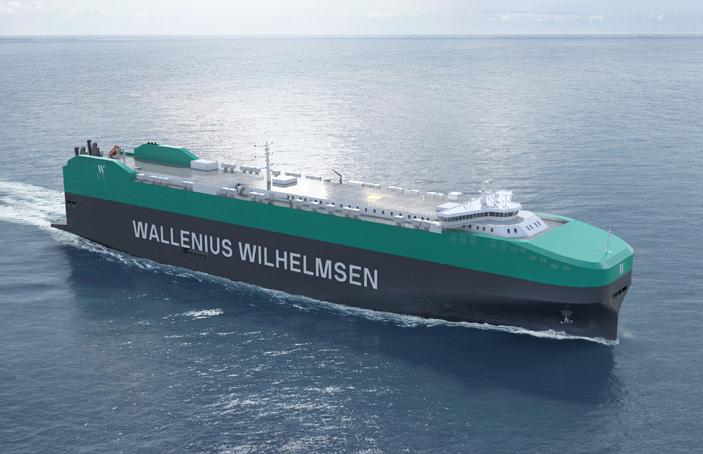
51 REPORT
51 Baltic transport 2023 highlights by Przemysław Myszka
76 NEWSLETTER BPO
76
7


78 TECHNOLOGY
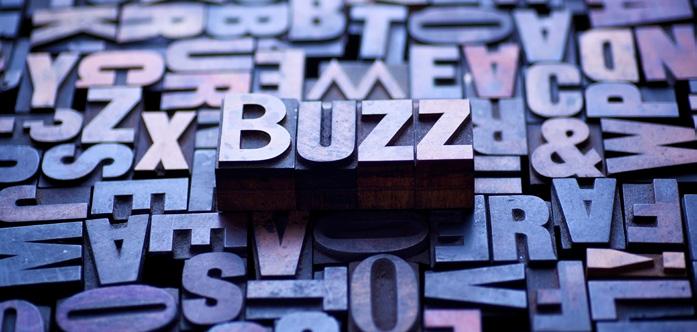
78 Well, duh!
– Can a single maritime artificial intelligence (AI) research project cut 1% of total global emissions? by Alexa Ivy
80 SPEARheading the right approach
– Five steps to tackle the data scraping menace by Niraj Bhatt
82 From news buzz to buzzing with activity – How AI, green shipping corridors, and digitalisation are redefining maritime operations by Grant Ingram
84 Identify as smart
– Digital identity verification in port operations by Kadri Haufe
86 The power of partnership
– Dual benefits of digitalisation steer shipping towards environmental and economic sustainability by Casper Jensen
98 The first step before a quantum leap
– Investigating the benefits of quantum computing in maritime logistics by Anisa Rizvanolli

CONTENTS 1/2024 | Baltic Transport Journal | 7
the
on the horizon
Wind turbines at sea –
BPO Offshore Wind Conference
7 Destination: climate issues by Monika Rogo






Transport Week 2024 , 12-13/03/24, PL/Gdynia, transportweek.eu
The next edition of the Transport Week conference will be held on 12-13 March 2024 in Gdynia, Poland. Expert speakers and a fantastic audience will once again tackle topics that shape the current face of the transport sector, from geopolitics, through market analysis to infrastructure development.
WindEurope Annual Event 2024 , 20-22/03/24, ES/Bilbao, windeurope.org/annual2024
The organisation’s annual on- and offshore wind energy event will be heading to Bilbao for a three-day conference and exhibition. You can expect 12,000+ attendees to join us for a look at the shape of European wind energy today. There will be dozens of conference sessions, hundreds of speakers, and 400+ exhibitors from the whole value chain looking to showcase their innovations and seal new deals.
ESPO 2024 , 25-26/04/24, FR/Paris, espo-conference.com/en
This year’s anniversary 20 th edition of the European Sea Ports Organisation’s annual conference will go under the ‘net-zero, resilient and competitive ports: acting now to deliver tomorrow’ theme. In 2024, the new normal will most likely be defined by disruption, geo-economic and geopolitical tensions leading to more frequent disruptions to supply chains, greater volatility on the energy markets and a fiercer international competition. Adding to this, the need to act and progress on the ambitions and concrete policies that Europe has put in place over the last five years, it is clear there is a lot to discuss.
Scandinavian Maritime Fair, 14-15/05/24, DK/Copenhagen, www.scandinavianmaritimefair.com
Scandinavian Maritime Fair recognizes the need of bringing together the Scandinavian maritime community. The aim is to unify and leave a lasting imprint on the world. Whether designers, manufacturers, suppliers, operators, shipowners, or service providers – both onshore and offshore – this is where industry leaders, young innovative companies and decision makers meet.
TOC Europe 2024 , 11-13/06/24, NL / Rotterdam, tocevents-europe.com
With an unrivalled 40+ year heritage, TOC Europe is the place to learn from and network underneath one roof with the world’s leading port decision-makers, policy experts, solution-providers, and more, enabling you to both supercharge your strategies and make your port operation visions a reality. Whether your focus is on adapting to the unpredictable economic climate or simply embracing the exciting new technologies revolutionising the sector, join us on the road back towards growth at the essential container supply chain event.
World Ports Conference 2024 , 8-10/10/24, DE/Hamburg, worldportsconference.com
2024 will be a pivotal year for ports and their communities. Geopolitical instability is on the rise. Physical and digital security is under threat, at sea and on shore. Shipowners, supply chain providers, and cargo owners must adapt rapidly. The energy transition towards low- and zero-carbon fuels must be balanced against national energy security concerns. #IAPH2024 will offer attendees insights on these topics, revealing how ports – from developing and developed nations – are building secure and sustainable solutions to these shared challenges, in a deeply interconnected world.
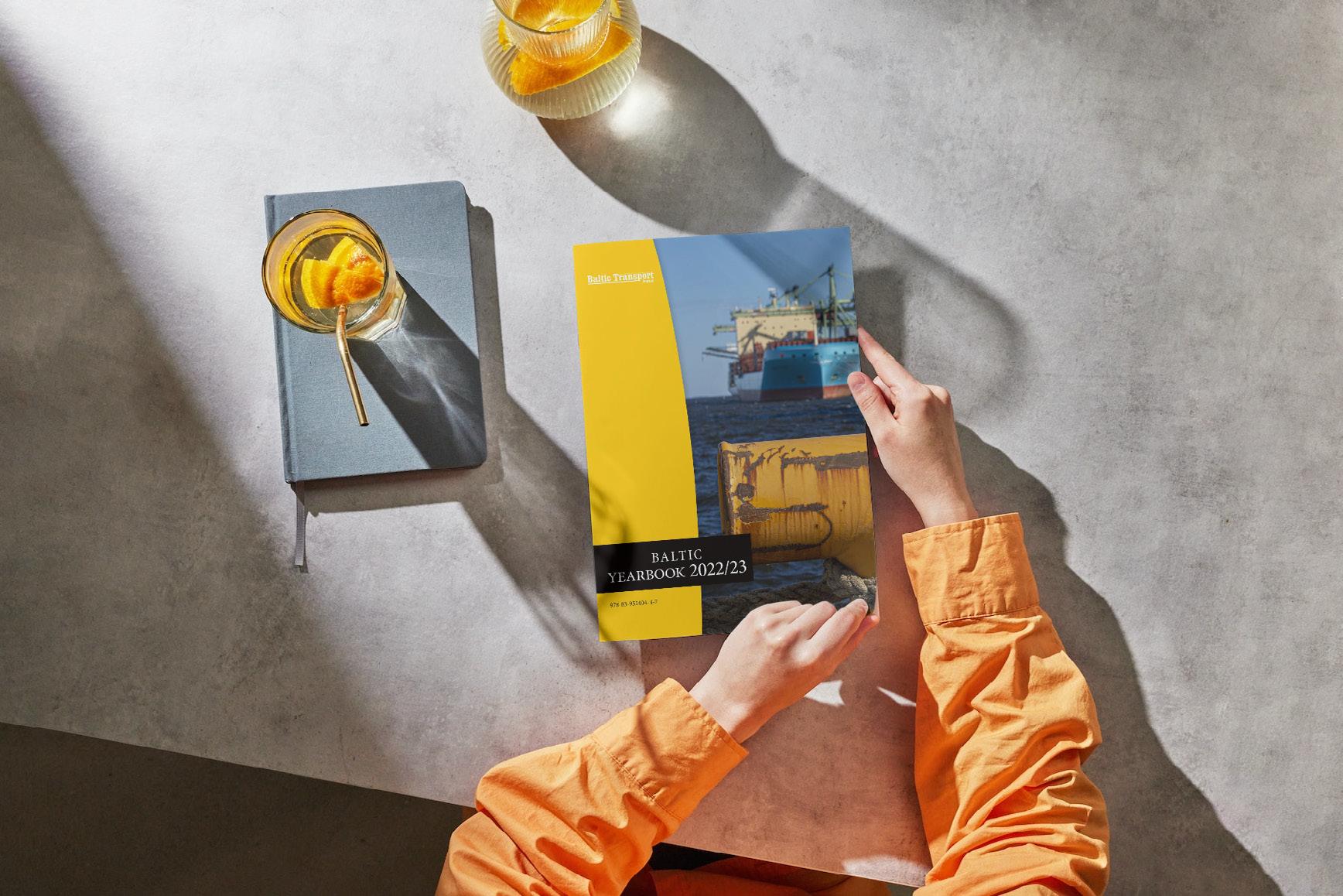

BTJ CALENDAR OF EVENTS i
! i
! preview
t ’ s o u t
t ’ s o u t
A YEAR IN FOCUS – A FOCUS ON SAFETY CULTURE FOR THE YEARS TO COME
TT Club released its latest review of current and ongoing risk trends. The publication includes a variety of studies and reports, including, among others, an analysis of the insurer’s own claims data, as well as detailed research into and advice on mitigating invasive pests in containers, increased cybersecurity risk as ports automate, increasing customs documentation errors; clandestine immigration threats; dangers of plastic micro pellet spillages; and what safety & security aid can drone technology provide. “TT has recently witnessed a renewed focus and commitment towards loss prevention activities, with additional emphasis placed on the Club’s mission statement to make the industry safer, more secure and more sustainable,” comments Mike Yarwood , TT Club’s Loss
Prevention Managing Director. He furthered, “Greater safety goes hand-in-hand with enhanced security and consequently sustainability. TT’s mutual ethos demands that we guide those we insure – and indeed the wider industry – in all aspects of risk through the container transport and global logistics supply chain. Via our latest Year in Focus , we aim to add to the large cannon of knowledge and guidance.” Josh Finch , TT Club’s Logistics Risk Manager, also underscores, “The importance of culture within an organisation, particularly where safety is concerned, cannot be underestimated. Safety is everybody’s responsibility, and everyone has a voice in safety matters. A strong safety culture will positively impact safety performance.”
THE EUROPEAN PORTS ALLIANCE PUBLIC PRIVATE PARTNERSHIP
The cooperative has been launched to fight organised crime and drug trafficking by leveraging the collective resources and expertise of multiple stakeholders to enhance security measures and enforce stringent controls within port facilities. Praising the initiative, the Federation of European Private Port Companies and Terminals (FEPORT) warned that “[…] we are reaching a situation where criminal networks are using extreme violence, corruption and intimidation that require exceptional mobilisation from public and private stakeholders in ports, national authorities, and law enforcement agencies. Seizures of cocaine in the EU have reached record levels, with more than 300 tonnes seized on an annual basis in recent years.” The Federation also notes that many effective solutions
are already in place, such as screening, intelligent cameras, virtual fences, port worker identity checks, and others. Still, closer international cooperation will be needed as we “[...] should also be aware that the creativity on the side of drug traffickers is huge and that it is going to be a race, a long marathon.” Ylva Johansson , European Commissioner for Home Affairs, stresses, “The vast majority of illicit drugs into the EU are trafficked along maritime routes. 70% of drug seizures are in EU ports. That is why cooperation between national & EU authorities and EU ports is vital. Organised crime is adept at moving from one port to another as opportunities rise and fall. To challenge this network, we must build a network. The violent consequences of drug trafficking are as big as the threat of terrorism.”
MARITIME SECURITY – A PRACTICAL GUIDE FOR MARINERS
The Nautical Institute has published its new compendium of essential maritime security advice, guidance and insights. The publication includes a broad range of topics, among many, a detailed examination of the ISPS Code and its implications. Author and global security expert Steven Jones AFNI FRSA, adds to the list, “The book tackles many of the issues that we have previously focused on within Maritime Security, such as coping with piracy, stowaways at sea and migrants. It also covers other challenges faced by officers, such as
cybersecurity and criminality at sea, in ports and across the entire supply chain. This has made it a real focal point, a book that can be relied upon to illuminate some of those darker issues within the industry.” Master Mariner and Maritime Consultant Dariusz Godźik MNI shares, “ I have learned a great deal from reading this updated and extended edition of Maritime Security. The book is written in an engaging and accessible way that makes it an essential reading for mariners everywhere.”
TRAINING SEAFARERS FOR A DECARBONISED FUTURE
The Maritime Just Transition Task Force has launched a collaborative project tasked with creating a framework to equip seafarers with skills as shipping transitions to zero-emission operations. Research commissioned by the organisation identified that 800 thousand of seafarers may require additional training by the mid-2030s in order to operate vessels running on zero- or near-zero emission fuels. The project will be run by the International Maritime Organization (IMO) and the Maritime Just Transition Task Force Secretariat. Lloyd’s Register (whose Foundation will fund the framework alongside IMO) will develop the training framework for seafarers and officers, as well as an instructor handbook for maritime training institutions. The World Maritime University will provide academic expertise, while a large number of organisations will be involved through a global industry peer learning group to provide knowledge-sharing. “Moving towards a low-emission future will require new green jobs and re-skilling, and the global maritime industry is no different.
Future alternative fuel technologies, such as hydrogen, ammonia and methanol, means there is a vital need to up-skill all seafarers,” highlights Ruth Boumphrey, CEO of Lloyd’s Register Foundation. Sturla Henriksen, Special Advisor Ocean of the United Nations Global Compact , adds, “Decarbonising shipping is essential to combat the climate crisis. The global nature of this transition means that no one is alone in tackling this issue, and the Maritime Just Transition Task Force is committed to providing resources to support stakeholders making this journey.” Stephen Cotton , General Secretary of the International Transport Workers’ Federation , shares, “We have heard the message loud and clear from seafarers around the world: they are ready to lead, they are ready to shape the training frameworks for the zero carbon fuels of the future.” In light of these future demands, IMO is reviewing and revising the International Convention on Standards of Training, Certification and Watchkeeping for Seafarers , with input from the industry and seafarer unions.

1/2024 | Baltic Transport Journal | 9 SAFETY NEWS BY WORKING TOWARDS SAFER PRACTICES TT Club is the leading provider of mutual insurance and related risk managment services to the international transport and logistics industry. Its core mission is to make the industry safer and more secure. To find out more visit ttclub.com
The Port of HaminaKotka:
617,181 TEUs handled in 2023 (-1.9% yoy)
The Finnish seaports took care of 14.12 million tonnes in international traffic last year (-13.2% year-on-year), plus 196.4kt in cabotage (-73.2% yoy). At the same time, the Port of HaminaKotka welcomed 13 cruise calls with 20k guests, twice as many as in 2022.

The Port of Helsinki:
8.92 million ferry passengers served in 2023 (+12.2% yoy)
There were also 1.48m private vehicles that went through Helsinki’s ferry berths last year (+5% year-on-year). With 162,813 travellers, Helsinki’s 2023 cruise season was on par with that of 2022. On the cargo front, the Port of Helsinki took care of 13.94 million tonnes (-8.2% yoy), including 13.39mt made in international (-11.3% yoy) and 553kt in cabotage traffic (+508% yoy). With 11.51mt (-8.7% yoy), unitised freight traffic continues to be the Finnish seaport’s prime trade. Wheeled (ro-ro & ferry cargo) accounted for 8.1mt (-7.9% yoy), while containerised for 3.42mt (-10.2% yoy). Helsinki also took care of 1.52mt of dry bulk (-2.1% yoy) and 765.3kt of break-bulk (-13% yoy). A total of 643,629 ro-ro cargo units went through Helsinki’s harbours (-8.3% yoy). At the same time, container traffic totted up to 451,760 TEUs (-8.1% yoy).
The Port of Riga:
465,391 TEUs handled in 2023 (+1% yoy)
The Latvian seaport took care of 7.73 million tonnes of general cargo, an advance of 2.4% on the 2022 result, including 5.11mt of containerised freight (+9.8% year-on-year). Although the handling of grains rose by 23.1% yoy, becoming Riga’s leading dry bulk trade, the entire category lost 29.5% yoy down to 10.22mt (chiefly because of the 73.2% yoy drop in coal & coke turnover). Liquid cargo contracted as well – by 42.4% yoy to 846.2kt. The Port of Riga overall handled 18.79mt (-20.1% yoy). A total of 81,681 cruise travellers went through Riga’s quays, a year-on-year increase of 7.9%.
The Port of Gdańsk:
81 million tonnes handled in 2023 (+19% yoy)
The handling of liquid bulk propelled the seaport’s growth the most, up 47.5% year-on-year to 37.6mt. With 22.9mt, general cargo came in second, including 20.5mt of containerised freight (+2.5% yoy). Coal turnover totted up to 13.3mt (+1.1% yoy), of which 12.5mt were imported. Other dry bulk goods contracted by 0.9% yoy to 3.5mt. Then again, grains advanced by 60% to 3.1mt.
Hupac: 975 thousand road consignments carried by rail in 2023 (-11.7% yoy)
“This negative development is mainly due to the declining demand for transport in Europe,” the Swiss combined rail transport company said in a press release. The brief further read, “The recessionary trend started in the autumn of 2022 in connection with the [war in] Ukraine and the energy crisis and affected large parts of the world economy in the course of 2023. To make matters worse, a number of factors are putting increasing pressure on the rail system. First and foremost is the poor quality of the rail network, especially in Germany, due to neglected maintenance and inadequate national and international construction planning. Capacity bottlenecks, delays and cancellations are the order of the day on many corridors. The massive double-digit cost increases in the rail system are also counterproductive.”
The Port of Gothenburg:
914 thousand TEUs handled in 2023 (+3.3% yoy)
As such, the Swedish seaport noted a new all-time high for containers going over its quays (16k more boxes than the port’s previous record result from 2012). At the same time, Gothenburg’s rail container traffic contracted 8.7% year-on-year to 473k TEUs (though it was still the second-best year in this area for the seaport). Fewer ro-ro cargo units were taken care of, too, down 3.7% yoy to 540k trucks & trailers. On the other hand, more new vehicles were handled, up 12.2% yoy to 267k. Whereas less liquid bulk was handled (-17.5% yoy to 18.4 million tonnes), the Port of Gothenburg saw more dry and break-bulk (+17.1% yoy to 439kt). The Swedish seaport welcomed 1.4 million ferry passengers (+7% yoy) and 118k cruise travellers (+45% yoy).
The Port of Tallinn:
7.92 million passengers served in 2023 (+12.7% yoy)
The Tallinn-Helsinki crossing welcomed 7.0m travellers last year (+13.7% year-on-year), followed by 537k between Tallinn and Stockholm (+18.3% yoy), and 170k on the Muuga-Vuosaari service (+7.8% yoy). On the other hand, fewer cruise guests came to visit the Estonian capital (-4.3% yoy to 165k). Passengers categorised as ‘others’ totalled 45k (-47.8% yoy). In addition, the port’s domestic passenger company, TS Laevad, carried 2.41m passengers (+4.9% yoy) and 1.13m private vehicles (+3.3% yoy). On the cargo front, the Port of Tallinn handled 12.59mt (-29.1% yoy), including 6.41mt of wheeled (ro-ro & ferry) cargo (-7% yoy), 2.16mt of dry bulk (-26.7% yoy), 1.88mt of containerised freight (-11.4% yoy), 1.7mt of liquid bulk (-67.1% yoy), 418kt of break-bulk (-31.6% yoy), and 24kt of non-marine cargo (-23.5% yoy). Tallinn’s container traffic amounted to 221,405 TEUs (-17.3% yoy).
Viking Line:
125,269 ro-ro cargo units carried in 2023 (+6.4% yoy)
The ferry company from the Åland Islands also served 4,897,494 passengers (-1% year-on-year) and transported 563,081 private vehicles (-10.7% yoy). The Turku-Åland-Stockholm, the prime crossing in the company’s network, saw 2,123,647 passengers last year (+8.6% yoy). Helsinki-Tallinn added 1,655,548 (+18% yoy), Stockholm-Mariehamn – 534,149 (+3.2% yoy), and Helsinki-Åland-Stockholm – 496,844 (-3.6% yoy). A total of 71,116 guests were hosted during Viking Line’s special cruises. Additionally, Rosella managed to serve 16,190 in January 2023 before being sold.

For more Market Statistics Made Simple please visit: www.baltictransportjournal.com 10 | Baltic Transport Journal | 1/2024
Photo: Harri Tarvainen/VisitHaminaKotka
Wasaline:
279,590 passengers served in 2023 (+4.4% yoy)
The company’s Aurora Botnia ferry also carried 63,647 private vehicles between the ports of Umeå and Vaasa, up 14.3% on the 2022 result. On the other hand, the Finnish-Swedish ferry line transported fewer ro-ro cargo units, down 5.9% year-on-year to 20,886.

The Port of Rauma:
4.72 million tonnes handled in 2023 (+4.7% yoy)
The Finnish seaport took care of nearly 4.51mt in international traffic (+3.2% year-on-year), of which exports totalled 3.05mt (+0.7% yoy) and imports – 1.46mt (+8.8% yoy). The remaining 214.5kt was made in cabotage traffic (+51.5% yoy). Rauma’s container traffic advanced 2.1% on the 2022 result, totting up to 213,644 TEUs. Of these, 209,875 (+0.5% yoy) were handled in international and 3,769 (+828%) in domestic traffic.
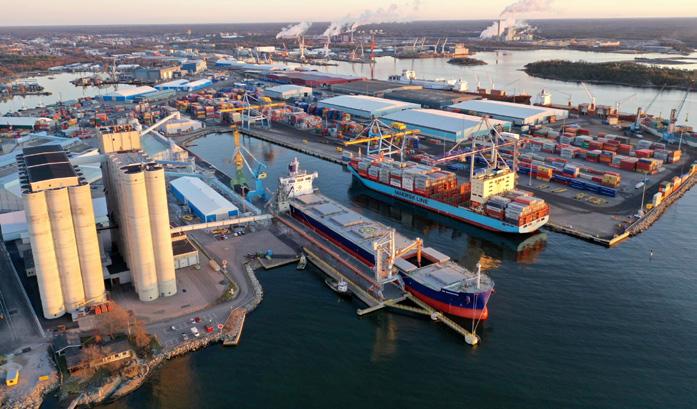
The Port of Szczecin-Świnoujście: 35.32 million tonnes handled in 2023 (-4% yoy)
General cargo, the Polish seaports’ leading trade, totalled 15.88mt (-10.4% year-on-year), of which freight brought on board ferries amounted to 12.94mt (-10.5% yoy). Liquid bulk, on the other hand, advanced by 14.4% yoy to 8.56mt, including 4.76mt of liquefied natural gas (+7.1% yoy). Goods classified as other dry bulk amounted to 3.99mt (+20.6% yoy), followed by coal – 2.94mt (-31.9% yoy), grains – 2.63mt (+59.5% yoy), iron ore – 1.14mt (-46.1% yoy), and timber – 182.2kt (-20.4% yoy). The Port of Szczecin-Świnoujście also handled 67.6k TEUs (-10.3% yoy).
BTJ’s on issuu.

MARKET SMS 1/2024 | Baltic Transport Journal | 11
C L I C K H E R E T O S T A R T F L I P P I N G T H E P A G E S Advertisement
Photo: Wasaline Photo: Port of Rauma
Oulu upgrades its TEN-T status
The Finnish seaport, until recently designated as a Comprehensive Port of the Trans-European Transport Network (TEN-T) of the European Union, is now a Core Port. The seaport shares that the new status will, among many, expand its EU funding possibilities as well as impose obligations regarding infrastructure development (with a focus on environmentally friendly transport solutions). Oulu’s status upgrade follows the revision of the TEN-T, according to which the Core Network will be completed by 2030, the Expanded Core Network ten years later, and the Comprehensive Network by mid-century. “This decision is particularly significant now, as the importance of the northern region in Finland’s security of supply and connections to the west is emphasized,” the port underlined in
Schwenk’s new Swedish terminal
The German family-owned cement specialist began operating its new facility in the Port of Gävle. After two years of planning and construction, the 90 thousand tonnes of yearly handling capacity terminal was commissioned in December 2023. The facility includes a 45-metre-tall silo that can store up to 8.0k m 3

Stena Oil moves into Frederikshavn
The company’s subsidiary, Stena Terminals, has signed a takeover agreement with the Danish seaport and will now run the 75 thousand m 3 facility. Stena will also deploy a bunker vessel in Q1 2024 to operate from the 14-metre-deep terminal, which will be able to handle various fuel types, including bio and methanol. Stena Line will be one of the customers served from Frederikshavn (the company runs a ferry service with Gothenburg from the Danish seaport).
Remontowa contracted by Torghatten Nord
The shipbuilder from Poland will construct a double-ended passenger-car hybrid vessel for the Norwegian ferry company. The 63.65 by 15.5-metre vessel, designed by the Norwegian Ship Design Company, will serve the Stornes-Bjørnerå crossing once delivered in Q1 2026. She will offer room for 149 passengers and space for 50 vehicles. The newbuild will be equipped with two azimuth thrusters powered by batteries (or a backup diesel generator), which will be loaded during port calls. It will be the ninth ferry delivered by Remontowa Shipbuilding to Torghatten Nord, including six electric ferries in 2018-2021. The Torghatten Nord order ups Remontowa’s order book to six turnkey vessels (the company also works on five units for the Polish Navy).
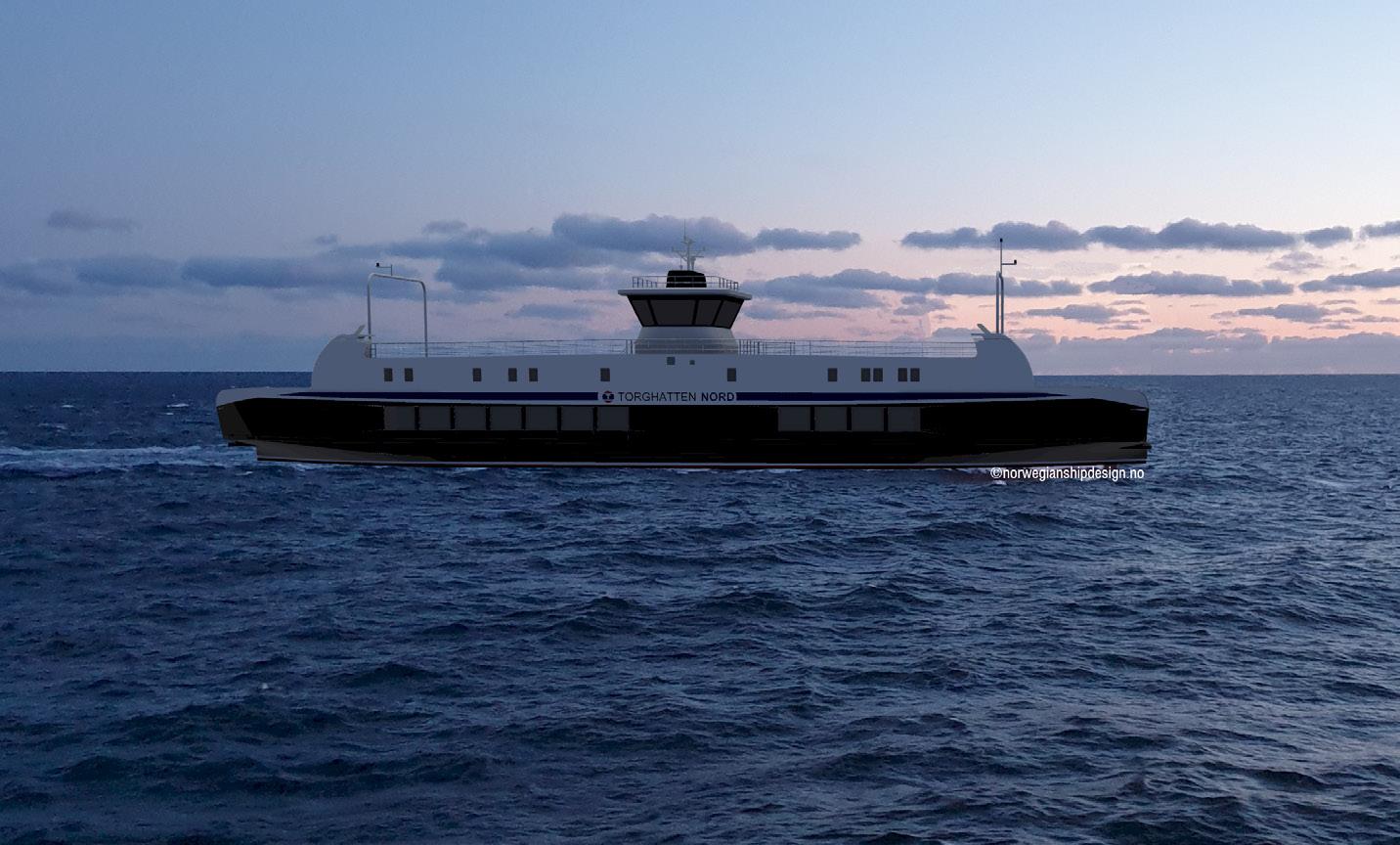

For more news items please visit: www.baltictransportjournal.com 12 | Baltic Transport Journal | 1/2024
Photo: The Norwegian Ship Design Company
a press release. Photo: Port of Oulu
Anker Christensen Eftf. grows its foothold in Aalborg
The Danish heavy-duty road haulage company from Hjørring has decided to expand its area of activity in the also Danish seaport by 14.4 thousand m2 to 25k m2 . The agreement follows the increased demand for disposal, sorting, and recycling of construction waste. The establishment of the new site is expected to be completed this summer. “We are pleased with the agreement, which helps us futureproof our business. The area will help meet the high demand for handling construction waste such as soil, sand and concrete that can all be recycled elsewhere,” commented Per Nielsen, Owner of Anker Christensen Eftf.

Helsingborg’s e-reachstacker – delivered
After around one year of delay, the Swedish seaport finally got hold of the Kalmar 587kWh battery-capacity machine. The cargo handling gear, rolling on Continental tyres, can stack containers up to five high. The loading capacity is 45, 32, and 16 tonnes for the first, second, and third row, respectively. The e-reachstacker joins the Port of Helsingborg’s four all-electric terminal tractors from Terberg. The deal with Kalmar also includes supporting the port’s mechanics with training. Bart Steijaert, the Port of Helsingborg’s CEO, highlighted, “An important part of our sustainability work is the development of climate-neutral, electrified port operations. We aim to have 75% of our work machines running on electricity by 2026, which is a demanding target within our ambition of being the most modern port in the Nordics.”
Thun Resource – delivered
The first in a series of eight coastal product tankers of Thun Tankers’ Resource Efficient Class was handed over by shipbuilders from the Dutch Ferus Smit. The vessel – Ice Class 1A, 114.95 by 15.87 metres, 7,999 deadweight – offers 9,540 m3 of carrying capacity (currently under long-term employment for Nynas). “Adaptive propulsion to minimize energy usage, readyfor-shore electricity connection, UPS battery pack, the latest hull design and the newest and most resource-efficient machinery are some examples of the vessel’s new features,” Thun Tankers underlined in a press brief.
Kalmar’s e-machinery goes to the US
Wallenius Wilhelmsen has ordered four heavy forklift trucks and two reachstackers, all of them electric, as well as three heavy terminal tractors for the company’s US operations. The deal also includes the Kalmar Insight fleet performance management tool. The order is part of Wallenius Wilhelmsen’s onshore emission reduction activities, in which the company switches to zero-emission equipment wherever practicable.


WHAT’S NEW? 1/2024 | Baltic Transport Journal | 13
Photo: Port of Aalborg
Photo: Kalmar
Finnlines’ second Superstar enters traffic
The cruise ferry Finncanopus arrived in the Port of Naantali, from which she, alongside her sister ship Finnsirius, sails to & from Kapellskär via the Åland Islands as of 16 February 2024. Both newbuilds offer room for 1,100 passengers and 5,200 lane metres for cargo. The 235.6 by 33.3 m Ice Class 1A Superstar ferries feature several emission-reduction technologies, such as air lubrication, batteries, scrubbers, and waste heat recovery. They also have ballast water treatment plants. Finnsirius and Finncanopus also take advantage of auto-mooring and draw power from the shore while berthed in Naantali and Kapellskär. You can read more about Finnsirius ’ launch in BTJ Trip 2023 \ Naantali. Compact but capacious & versatile
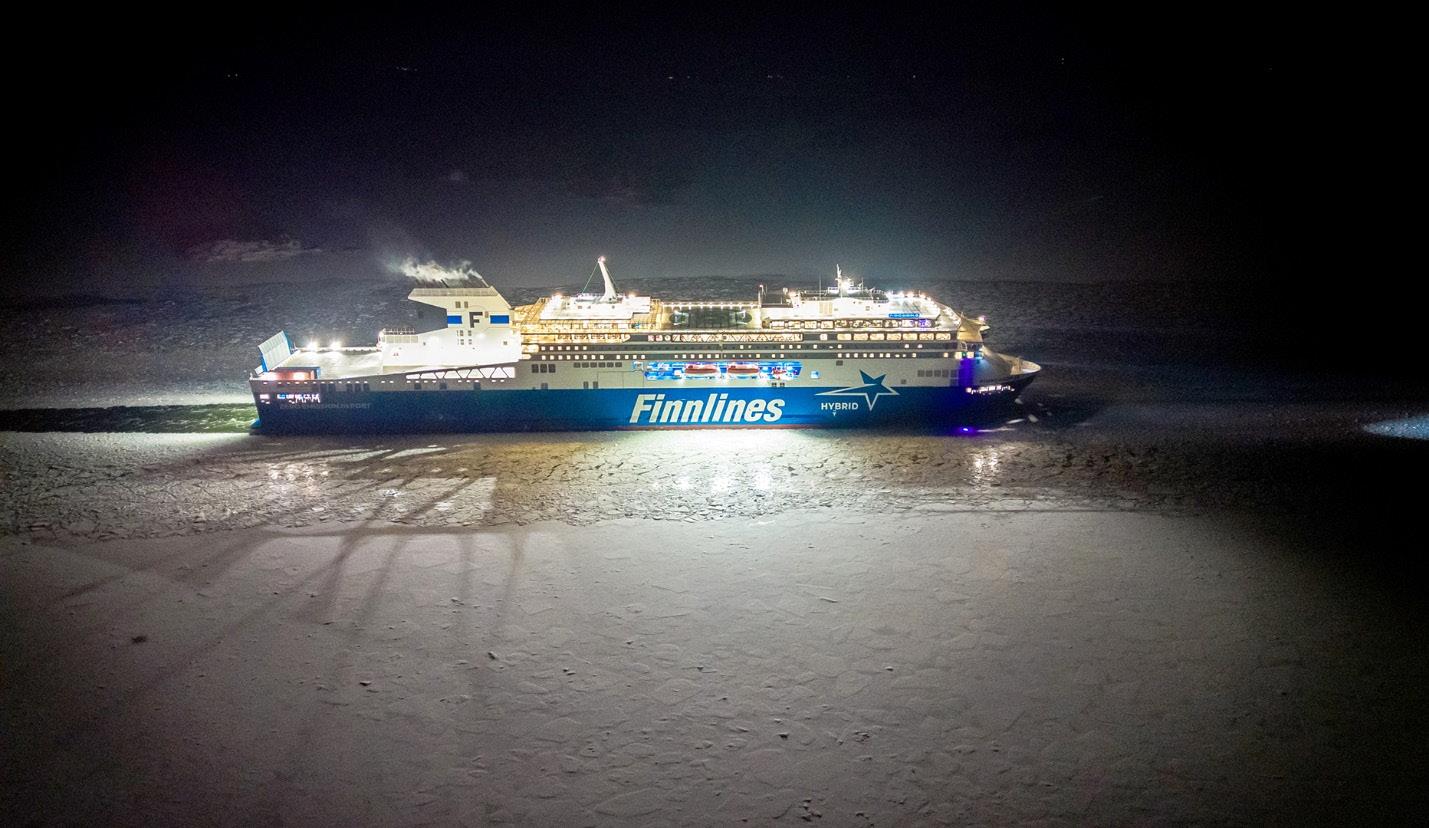
Two new Germany -Sweden rail links
Kombiverkehr, in co-op with DB Cargo Scandinavia, has put in motion two services between Lübeck Dänischburg Cargo-Terminal Lehmann and Arlanda North (near Stockholm). The first full-rail crossing (via Denmark) is up and running from 3 January 2024, including a stop in Hallsberg. The other one, using Finnlines’ ferry service from Lübeck to Malmö with a stopover in Norköpping, started running on 15 January 2024. Both services offer three weekly round trips and can take various cargo units, including P400 semitrailers (but excluding type 1 and 7 dangerous goods).
Unity Line takes hold of Epsilon
The Polish ferry line has deployed the 2011-built ro-pax on its Świnoujście-Trelleborg service. The 187 by 26 m ferry offers room for 299 passengers and 2,860 lane metres for wheeled cargo and other vehicles.
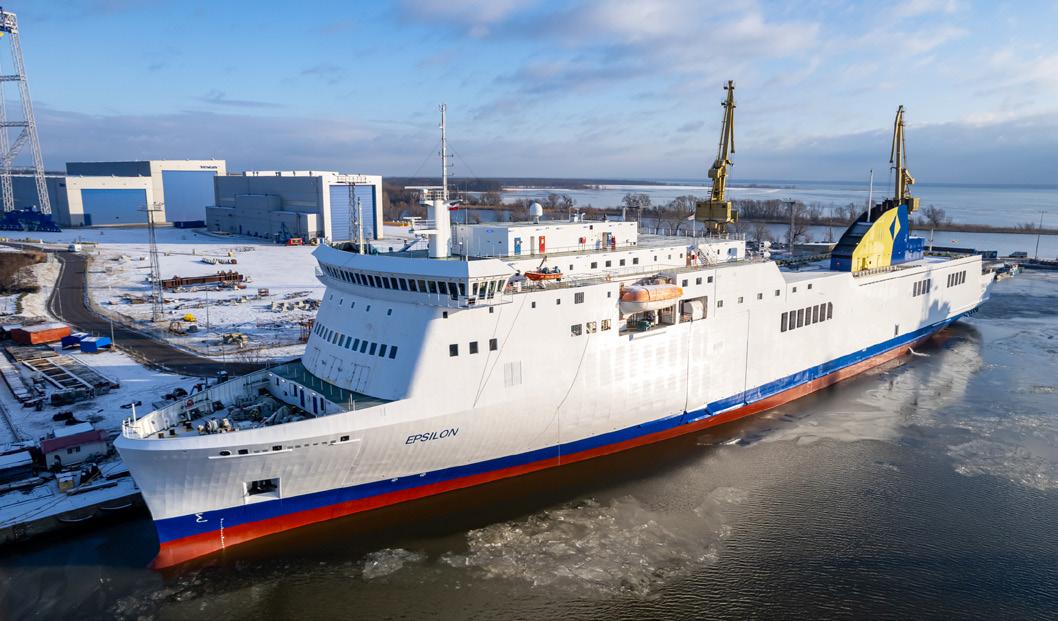

For Europe-wide maps news on ro-ro & ferry container intermodal please visit: www.europeantransportmaps.com 14 | Baltic Transport Journal | 1/2024
Photo: Finnlines
Photo: S. Wołosz/Unity Line
TX Logistik links Lübeck and Verona
The company has launched a twice-a-week rail service for trailers (incl. non-craneable) and containers (incl. tank) between Cargo-Terminal Lehmann in Germany and Interporto Quadrante Europa in Italy. The train set comprises up to 32 cargo transport units (CTU). Meanwhile, TX Logistik has increased the number of round trips from four to six per week on its Lübeck-Segrate intermodal 32-CTU service (trailer & container, also including non-craneable and tank). The terminal of call in Germany is BRG, while it’s the Italia Milano Segrate facility in Italy. TX Logistik takes care of the entire traction for both routes.

Smyril Line orders new ro-ros
The Faroese shipping company has contracted the Chinese CIMC Raffles to construct two 190-metrelong, 3,300 lane metres for wheeled cargo, e-methanol-ready freighters. The newbuilds, designed by KNUD E. HANSEN, will also feature battery systems and onshore power supply connectors. The duo is planned to start sailing in 2026, serving Smyril Line’s Europe-Faroe Islands-Iceland trade.
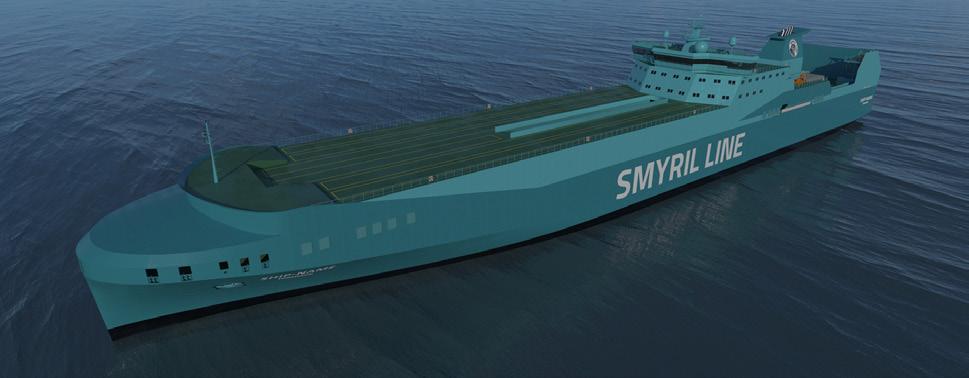
Visborg again in the Med
Gotland Company’s ferry has once more been chartered by the Spanish Baleària, putting her on the ValenciaPalma-Ibiza service. The 2003-built 196 by 25 m ro-pax offers room for 1,650 passengers and 1,500 lane metres for wheeled freight. Visborg’s recent employment was a short charter for DFDS on the KarlshamnKlaipėda route, before which she plied for Baleària between the Spanish Almería and
Isabelle – sold
New rail service crisscrossing Sweden
Träfraktkontoret and its subsidiary TFK Logistics have kicked off a twice-a-week container (incl. tank) service that links Gothenburg and Piteå. In the north of Sweden, the train set is handled by ShoreLink in the Port of Piteå and at the rail-connected terminal of Stenvalls Trä at Lövholmen. In Gothenburg, the rolling stock goes directly into the sea container facility operated by APM Terminals. As of March 2024, the service will also carry trailers (which will be handled by Gothenburg RoRo Terminal’s Arken Intermodal Terminal).
Gotland Alandia Cruises’ maiden voyage
The Gotland Company-Viking Line JV will see its Birka Gotland departing from Stockholm’s Stadsgårdskajen to the Port of Mariehamn on 20 March 2024. Subsequently, the cruiser (offering room for 1,800 passengers) will ply each evening between the two destinations, also visiting Visby from time to time (the first trip to the island of Gotland is scheduled for 30 March 2024). Gotland Alandia Cruises also shares that Birka Gotland will call the Baltic ports of Härnösand, Riga, Rønne, and Ystad throughout the year.
Lakeway Link takes hold of a vessel
The JV between Greencarrier and Wallenius has acquired the 1999-built ro-ro Miramar Express, to be re-named Lakeway Express ahead of her launch on the Gdynia-Södertälje service this April. The 1,624 lane metres of capacity freighter will initially offer three weekly departures. Lakeway Link intends to incorporate the Swedish Port of Västerås into the service by 2026 following the reconstruction of the Södertälje locks.
Bridgemans Floatel Limited Partnership’s subsidiary from Cyprus Notamare Shipping Company has taken over Tallink’s ferry. The purchase is an exercise of the option included in the multi-year charter from April 2023 between Tallink Grupp’s subsidiaries Tallink Latvia & Hansalink and Bridgemans. The ferry, operating the Riga-Stockholm crossing before COVID-19 and offering room for 2,200 passengers (plus 970 lane metres for wheeled cargo), left Tallinn for Canada in December 2023. Isabelle joined Bridgemans’ fleet of ‘floatels’ (floating hotels) the following month. “We are pleased that after nearly 11 years as part of the Tallink Grupp fleet and at the respectable age of 35, Isabelle will now continue to offer a valuable and much-needed service, like the one she was able to offer here in Tallinn to the Ukrainian war refugees – safe accommodation – albeit this time to workers of major global industrial and resource projects,” Paavo Nõgene, Tallink Grupp’s CEO, commented. He added, “Tallink Grupp has a long-standing history and cooperation with Bridgemans, dating back over a decade, so we are pleased Isabelle is in trustworthy hands and know that she will be looked after well by the new vessel owners.”

MAP NEWS 1/2024 | Baltic Transport Journal | 15
the Moroccan Nador.
Photo: TX Logistik
Photo: KNUD E. HANSEN
HIRTSHALS EYES MORE WIND ENERGY…
• The Danish seaport has initiated a dialogue-based tender to erect up to nine additional turbines at its premises. These could come online in 2027, joining the existing four turbines (4.2MW; Denmark’s first set up on commercial terms – in 2019). The new turbines will be from 150 to 180 or 200 metres tall (nine, six, and four pieces, respectively),
producing 169/174/135MWh/year. The energy from the existing and future wind turbines will be used for power-to-x purposes. “[…] Hirtshals is perhaps the first port in the world to require that the electricity generated by its wind turbines be used to produce the green fuels of the future,” the Danish seaport underlined in a press brief. •
… AND BECOMING A CCUS HUB
• The EU Just Transition Fund has supported the establishment of a CO2 storage and shipment hub in the Port of Hirtshals with 109 million Danish crowns (€14.6m). The facility can be up and running in 2025/2026, with an initial capacity for handling 0.5 million tonnes per year for permanent storage in empty oil & gas fields in the Greensand area of the Danish
part of the North Sea. If provided with a pipeline for transporting CO2 to the Port of Hirtshals, the carbon capture, utilisation and storage (CCUS) project of Greenport Scandinavia would be able to take care of 3.0mt/year of CO2 in 2029, up to beyond 15mt/year in the early 2030s should the Danish and European infrastructures be integrated. •
NORSEPOWER SCORES TWICE
• First, the Lübeck-headquartered Oldendorff Carriers chose Norsepower to retrofit the company’s post-Panamax bulk carrier Dietrich Oldendorff with three 24 m tall and 4.0 m in diameter Rotor Sails. The installation will be carried out in Q2 2024 and finished by mid-year. Next, Louis Dreyfus Armateurs (LDA), a French shipowner who works on a fleet to be chartered by Airbus, will see these con-ros equipped with Rotor Sails. Each of the three dual-fuel (e-methanol) freighters will be outfitted with six 35-metre-tall sails. LDA’s Rotor Sails
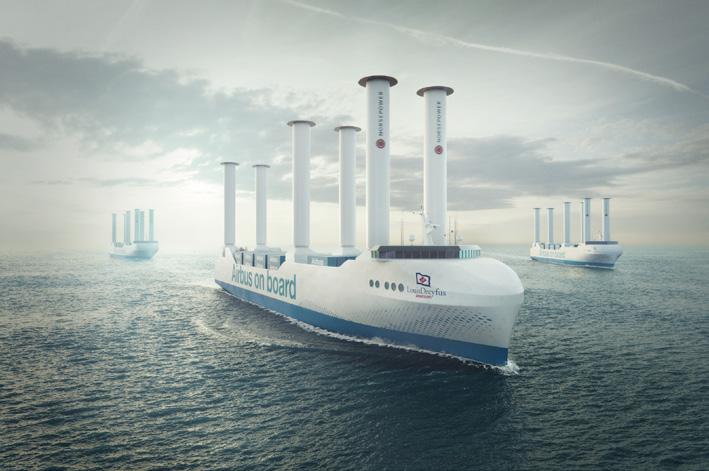
will feature the brand-new patented Norsepower Sentient Control™, a real-time force measurement, control, and savings reporting system that will allow controlling the rotors individually. In addition, routing software will optimise the vessels’ journey across the Atlantic, maximising wind propulsion and avoiding drag caused by adverse ocean conditions. Estimations say that the new con-ros, expected to set sail in 2026, will halve the carbon footprint of LDA-Airbus’ Transatlantic voyages by 2030 vs 2023 levels (from 68kt to 33kt/year). •

LAND RECLAMATION FOR TALLINN’S
• Van Oord’s trailing suction hopper dredger Vox Amalia has arrived at the Paldiski South Harbour, where the Port of Tallinn will erect a dock to serve the offshore wind energy (OWE) industry. Vox Amalia will supply approximately
OWE QUAY – STARTED
830 thousand m3 of sand to create ten hectares of land for the quay (expected to become operational in 2025), with the sand dredged from a borrow area on the northern coast of Hiiumaa (about 125 km from the port).
•
THE STOCKHOLM-TURKU GREEN CORRIDOR
• The ports of Stockholm and Turku, alongside Viking Line, have signed an agreement to make the crossing between them fossil-free by 2035 at the latest. The partnership will act as an innovative platform to develop scalable solutions for phasing out fossil fuels. The initiative will also leverage the advances and solutions from the Decatrip project, a collaboration
between Rauma Marine Constructions, Viking Line, Åbo Akademi University, and Kempower. The Stockholm-Turku Green Corridor – ‘green’ as per the Clydebank Declaration, of which Finland and Sweden are signatories – is open to onboarding other stakeholders from the shipping and port industries, as well as cargo owners, freight forwarders, and others.
•
FINLAND’S FIRST OWE FARM TO GET STRONGER
• Suomen Hyötytuuli has obtained the building and water permits for adding new turbines to the 42MW Tahkoluoto offshore wind energy (OWE) farm off the coast of Pori. The so-called demonstration project, supported by NextGenerationEU funding, will see the addition of two at least 15MW-strong turbines (the current ones, 11, have a capacity of
2.3-4.2MW). The project aims to demonstrate the construction of new-scale offshore wind turbines, likewise testing foundations capable of withstanding harsh sea conditions (Tahkoluoto is the world’s first OWE farm erected in freezing waters). The entire expansion project assumes placing 40 new turbines, thus increasing the farm’s capacity by 600-800MW by 2027-2029. •

VENTURE FORTH 16 | Baltic Transport Journal | 1/2024
Photos: Norsepower
VENTURE FORTH
TAILWIND FOR SZCZECIN-ŚWINOUJCIE
• First, Vestas announced it plans to invest in a new plant producing blades for the V236.15.0MW wind energy turbine model. The facility, which could come online in 2026, will be located on a site acquired by the company in February 2023 and situated near an island where Vestas will have its nacelle assembly factory (expected to start operating in 2025). Second, the Spanish Windar Renovables and the Port of Szczecin-Świnoujście ratified the October 2023-signed preliminary land concession agreement. The company will now establish an offshore wind energy tower production centre in the Port of Szczecin. The factory and its storage area will occupy 17 ha. The towers produced by Windar Renovables in Szczecin will be designed to support the new generation turbines with 20MW of installed capacity. Third, the Port of Szczecin-Świnoujście joined the
Offshore Wind Port Alliance. The Polish duo has become the seventh member of an organisation that aims to cooperate to provide sufficient handling & storage capacity for Europe’s offshore wind energy industry. “Specifically, the collaboration between the seven ports consists of ongoing coordination and knowledge sharing, which enables them to optimise capacity utilisation between the ports to build wind farms more efficiently. Wind turbines require a lot of space at the ports, so lack of space is a specific challenge the ports are working to solve together. If one port only has space for half a project, another port may have space for the other half. In this way, the offshore wind farm can be built as scheduled, and the client will not have to wait for space at one specific port,” the Offshore Wind Port Alliance underscored in a press release. •
BWB TO BUILD A HYBRID BIOMETHANE VESSEL
• The Estonian State Fleet has entrusted the also coming from Estonia Baltic Workboats (BWB) with designing and constructing a new multi-purpose ship. The €22 million contract, supported by NextGenerationEU, will see BWB delivering the 40 by 10 metres, max speed of 12 knots vessel in 2026 (exact parameters of the workboat will be determined during the detail design process). “The new workboat will enhance the capacity for regular buoy tender works, maintenance of waterways, scientific research, pollution
monitoring and response and search and rescue missions in Estonian waters,” BWB detailed in a press announcement. The company also underlined, “The multi-purpose vessel will be Estonia’s first 100% alternatively fuelled workboat that will use sustainable biomethane as the main fuel, thanks to which it will be possible to minimize the ship’s CO2 emissions. In addition, the ship will be equipped with a battery bank that allows the operation of the vessel also in 100% electric mode with zero emissions.” •
ESL SHIPPING JOINS SBTI
• The Finnish dry bulk carrier became part of the Science Based Targets initiative (SBTi), having committed itself to reducing its footprint in line with the global warming limit of 1.5°C. In 2021, the company shared that it intends to reduce its emission intensity per tonne-mile by 50% by 2023 as a step towards net-zero operations by mid-century. By joining SBTi, ESL Shipping wants to reach climate neutrality already in 2040. The shipping line’s efforts include, among others, sailing their gas-run
vessels on bioLNG and ordering hybrid coastal ships (via the AtoB@C Shipping subsidiary). ESL Shipping has also recently upgraded its EcoVadis sustainability assessment from silver to gold. “For years, we have worked hard to find solutions to reduce our carbon footprint, and by committing to the Science Based Targets initiative, our clients and stakeholders can be convinced that we have a robust plan to achieve net zero by 2040,” underlined Mikki Koskinen, ESL Shipping’s Managing Director. •
GASUM-NORDIC REN-GAS E-METHANE DEAL
• The two have signed an offtake agreement, according to which Gasum will buy the entire output of Nordic Ren-Gas’ Tampere Power-to-Gas plant, set for launch in 2026. The facility (developed, built, and operated by Nordic Ren-Gas) will produce 160GWh/year of e-methane (35 thousand tonnes) by using renewable electricity from Finnish wind energy farms and biogenic CO2 captured from existing power plants (110kt). The Tampere plant will be located next to the existing Tammervoima waste incineration plant, from which CO2 will be captured from the flue gas.
In addition, excess process heat from production will be provided to the Tampere district heating network (600GWh/y). “In the power-to-gas process, hydrogen is first produced [18kt/y in case of the Tampere facility] using renewable electricity and water. The hydrogen is then further processed into e-methane by combining the hydrogen with biogenic carbon dioxide. E-methane produced in this way is fully renewable and will replace fossil fuel usage in transportation, maritime and industrial sectors,” Gasum detailed in a press release. •
WISMAR INVESTS IN HYBRID MACHINERY
• The German Baltic seaport took hold of a rubber-tyred Mantsinen 120 Hybrilift crane, said to be 35% more energy efficient than
a corresponding fossil fuel-only gear. According to the owners, it’s the first such Mantsinen deployed in a German seaport. •
HALLAND-HIGHFIVE AI CO-OP
• The Swedish port authority (managing Halmstad and Varberg) has teamed up with the tech company which wants to use artificial intelligence (AI) to foster sustainable and innovative growth. Over Q1 2024, the two will work on identifying the areas in which AI can be implemented to boost productivity and create new customer offerings. “We focus on the interplay between AI and humans,
where the former helps us make better decisions. With our team of researchers in design and AI, we strive to match technological expertise with practical applications to create solutions that are both innovative and user-friendly. We want to inspire locally and regionally as well as pitch in so that Sweden doesn’t lag on digitalisation,” underlined Sandra Johannesson, CEO of Highfive. •

1/2024 | Baltic Transport Journal | 17
Global Maritime Trends 2050
What does the future of the maritime industry look like?
Commissioned by
The maritime industry will transform over the coming decades, driven by technology adoption, the climate agenda, and intensifying geopolitical and macroeconomic shifts.
More than ever, maritime leaders and policymakers need robust insights to support critical decisions shaping the future of the industry.
80%
3%
Defining impacts
Global Maritime Trends 2050 analyses the leading drivers of transformation over the next 30 years, and how they impact five key components of the maritime industry.
“The renewed focus on energy security, particularly in light of heightened tensions and conflicts, is accelerating the global energy transition. ”
2050
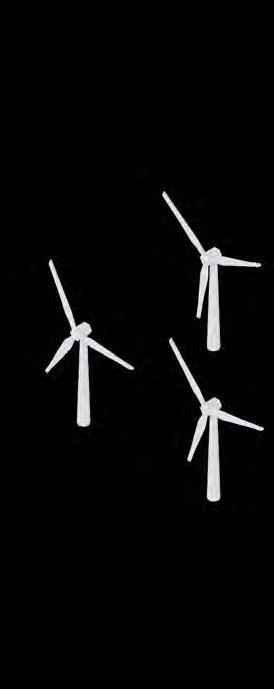




CHART OF THE ISSUE
Maritime trade Commercial shipping, energy transport, fishing Vessels Design, fuels, technologies Energy Green energy supply, o shore energy Ports Port infrastructure and logistics People Skills, training programmes Maritime economy
Global Maritime Trends
of global emissions are produced by shipping
of the world’s trade
The research led us to four insightful futures that depict Revealing
is delivered by ships



Revealing futures
The research led us to four insightful futures that depict what the maritime industry of 2050 could look like.
Most notably, the outlooks consider various scenarios around speed of technology uptake and the nature of global co-operation on climate change.
Co-operation

Gradual
Just, gradual transition
High global co-operation combined with a gradual uptake of novel and/or advanced technology
Global co-operation on climate change

Delayed transition
High global fragmentation combined with a slow uptake of novel and/or advanced technology

Rapid tech-driven transition
High global co-operation combined with a rapid uptake of novel and/or advanced technology
Speed of technology uptake

Fragmentation
Regionalised and fragmented transition
High global fragmentation combined with a rapid uptake of novel and/or advanced technology
Rapid


Towards 2050
different scenarios will impact the maritime

1/2024 | Baltic Transport Journal | 19 energy transport, fishing economy
Explore our four futures to discover how
Towards 2050
Explore our four futures to discover how different scenarios will impact the maritime industry. Although fictional, each is grounded in science, historical fact and current speculation.
01
Just, gradual transition
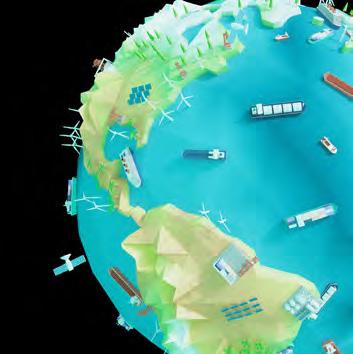

What if nations embrace widespread adoption of green hydrogen?
The maritime industry could become a decarbonisation enabler, linking key future producers of green energy such as China, Saudi Arabia, South Africa and the US.
With further development, ammonia is likely to become the safest and most efficient way to transport hydrogen, creating many new jobs and upskilling opportunities.
How we get here
• Global co-operation on climate change with clear targets
• Political support through investments and incentives
• Rapid uptake of new fuel technologies by ships
• Ports redesigned for supply and storage of new fuels
• Demand for tech-savvy ship managers enables more women seafarers

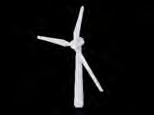

2026
Target date for Europe's first green ammonia facility
90%
Most electricity expansion over the next five years will be renewable
02
Rapid tech-driven transition
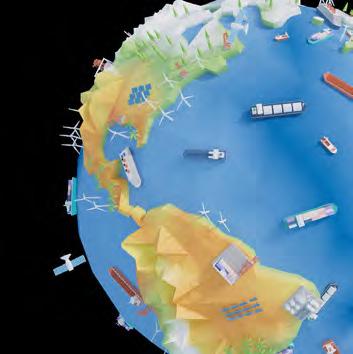

What if automated technology solutions became widely adopted?
Remote control, automation and IoT technologies will greatly enhance the efficiency of ships and ports, creating opportunities to increase maritime trade.
Human supervision by skilled employees will be critical, with AI-powered assistants and immersive technologies such as the metaverse to simplify and enhance tasks.
How we get here
• Strong industry-wide technology investment
• Coordinated approach to decarbonisation
• Global harmonisation of technology protocols
• Industry training matches emerging innovation



30.6bn
Number of IoT units expected to be in operation by 2025
90%
Percentage of vessel data that AI-based models can process





CHART OF THE ISSUE 20 | Baltic Transport Journal
04 03
Percentage of vessel data that AI-based
03
Regionalised and fragmented transition


What if regionalisation and population expansion lead to fragmented maritime trade?
Localised systems of trade could lead to smaller ships making shorter journeys, with escalating costs due to varied adoption of technology in different regions.
Lack of global co-operation on governance and trade increases the risk of ‘dark fleets’ operating under the radar.
How we get here
• Shifting population dynamics drive consumer demand in Asian and African economies
• Geopolitical and supply chain challenges lead to regionalisation
• Low co-operation on innovation, data sharing and decarbonisation
• Disparate technology uptake causes port incompatibility
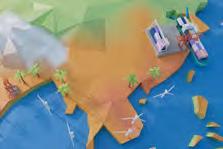

50%
By 2050, half of the world's top ten economies will be Asian
25% Africa will contribute a quarter of the world’s population by 2050
04
Delayed transition
See the full picture


What if average global sea levels rise by at least 40 cm?
Unchecked, climate change is set to destabilise many traditional shipping routes, prompting increased traffic in the unpredictable Arctic Ocean as ice retreats.
Extreme weather and natural disasters will increase the costs and requirements for insurance, while rising sea levels could submerge many vital economic ports.
How we get here
• Low co-operation and action on climate change
• Slow and fragmented technology uptake
• Rising water and soil salinity disrupt supply chains
• Rising sea levels increase coastal inundation
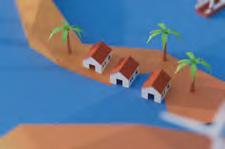

800m
Number of people already vulnerable to a 0.5 metre sea-level rise
2030
Predicted start of ice-free Septembers in the Arctic Ocean
Read more about the scenarios in our online hub and report: http://impact.economist.com/ocean/global-maritime-trends-2050/
© The Economist Group 2023

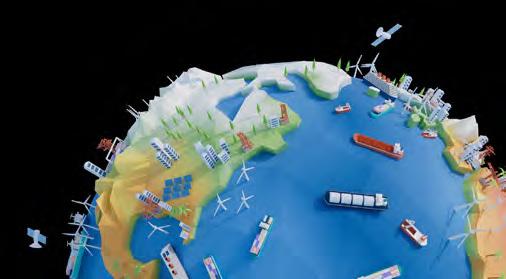

CHART OF THE ISSUE 1/2024 | Baltic Transport Journal | 21
electricity expansion over the next five years will be renewable
Most
can process
models
Temporary storage period – debated
The European Parliament is discussing the Commission’s (COM) proposal for a new EU Regulation on the Union Customs Code. The European Sea Ports Organisation (ESPO) shared a series of concerns over the file, most notably regarding reducing the time for the temporary storage to three days. “The 90 days temporary storage plays a crucial role in ensuring the fluidity of cargo flows through ports, in particular, when other parties in the logistics chain do not provide in a timely manner the data required to place goods under a customs procedure,” highlighted ESPO in a press brief. The Organisation also
noted, “In fact, the ‘temporary storage’ status must be seen as a useful ‘administrative waiting room’ either to get the necessary information/data or, in case of transhipment call to collect the cargo and/or wait for the vessel to continue the voyage to the end destination of the goods. A shortened temporary storage period would leave an unacceptable amount of goods without an adequate customs procedure, forcing terminals & shipping lines to be responsible for putting goods under a customs bonded procedure.” ESPO has also published a position paper on the Customs Reform Proposal (COM(2023) 258).
TEN-T – under review
On 18 December 2023, the European Parliament and Council reached a deal on the review of the TEN-T Regulation. Among others, the European Sea Ports Organisation (ESPO) strongly supports the legislators’ decision to include energy ports in the EU’s Trans-European Transport Network (TEN-T). In accordance with the reached agreement and the Organisation’s longstanding plea, a port’s position in the TEN-T will now be assessed not only on the basis of the amount of cargo handled but also on its contribution to the energy transition. “Even if volumes and tonnes remain an important indicator for ports as hubs in the logistic chain, it is not anymore the only indicator of performance. The decision to include ports that play an important role
in the supply of energy in the TEN-T is a huge step forward. It shows that the legislators recognise that energy is an important commodity and ports are key in ensuring both Europe’s energy security and energy transition. This energy role cannot always be counted in tonnes,” underscored Isabelle Ryckbost, ESPO’s Secretary General. At the same time, ESPO welcomed the Parliament’s adoption of the Berendsen report, an initiative on building a comprehensive European port strategy. The Organisation especially highlights the report’s understanding of the strategic challenges modern ports face and, similarly, the sheer amount of investments they need to carry out to continue supporting the EU’s society and economy in a future-fit manner.
OPS workshop package – available
The package – developed by the IMO-GreenVoyage2050 project in collaboration with the International Association of Ports and Harbours – has been released . It explains how ports can use onshore power supply (OPS) and support the use of cold ironing to reduce ship emissions in harbours, in line with the objectives of IMO resolution MEPC.366(79), which encourages voluntary
cooperation between the port and shipping sectors to contribute to the reduction of greenhouse gas emissions from vessels. The package goes through several topics, including key issues when exploring OPS, common drivers and influencing factors that affect the viability of OPS as an emission reduction strategy. and types of analyses required to assess the feasibility and potential usage.
Sustainable Ocean Principles – developed
The UN Global Compact has, in consultation with more than 300 stakeholders worldwide, developed the Principles in question. The purpose of the Practical Guidance – Ports edition is to promote the well-being of the ocean for current and future generations,
as well as to emphasize the shared responsibility of businesses to take necessary actions to secure a healthy and productive ocean. The nine principles cover three areas: ocean health and productivity, governance and engagement, and data and transparency.
Guidance on the Safety of Battery Energy Storage Systems (BESS) On-board Ships – released
“BESS installations on board ships have been increasing in number and installed power as battery technology also develops. There are more than 800 battery ships in operation across the world, 60% of which are known to be operating in Europe, using batteries onboard for propulsion either in pure electric or hybrid functions,” said the European Maritime Safety Agency in a press release
on the launch of its publication. The Guidance – developed with the support of experts who brought essential knowledge on the requirements of classification societies, industry standards, and available research – aims at supporting maritime administrations and the industry by promoting a uniform implementation of the essential safety requirements for batteries aboard vessels.
CIG4U – presented
On a visit to Kyiv, the Lithuanian Ministry of Transport and Communications, supported by Canada, Sweden and Ukraine, presented the Common Interest Group for Transport in Ukraine (CIG4U) support platform within the International Transport Forum (ITF) and as one of the priority activities of the Lithuanian ITF Presidency. CIG4U is to help Ukraine meet its immediate transport needs by contributing to the long-term reconstruction of the country’s transport links.
As such, CIG4U will act as an information exchange platform about the transport and infrastructure needs identified as urgent by the Ukrainian government, e.g., immediate repairs, replacement material, or other actions to ensure the functioning and safety of Ukraine’s transport systems. The ITF platform will also coordinate the mobilisation of international support for the reconstruction of the country’s infrastructure, ensuring transparent use of aid for Ukraine’s key priorities.

WHAT’S IN THE CABINET 22 | Baltic Transport Journal | 1/2024


As safe as ports?
by Neil Dalus, Risk Assessment Manager, TT Club
Security is key for container terminals and ports generally. The threat horizon is vast, incorporating cargo theft and illicit trades alongside operational safety and the prevention of terrorist attacks. Inevitably, land and water interfaces are needed to be taken into account. Let us then consider some fundamental aspects of modern-day port security challenges and offer some guidance.
Acentral reference in the context of security for port operators is the International Ship and Port Facility Security (ISPS) Code, a supplement to the Safety of Life at Sea Convention. It sets minimum security arrangements for ships, ports and governmental agencies.
Dating back to 2004, the ISPS Code ascribes responsibilities to a variety of stakeholders, including port personnel, related to detecting threats and taking preventive measures affecting ships or port facilities used in international trade. The Code also specifies the appointment of a port facility security officer responsible for the development and maintenance of a port facility security plan.
Barrier fundamentals
Physical security will be a primary consideration. Getting the simple things right, such as perimeter fencing, is fundamental. Measures that go beyond that will need to be proportionate to the risks assessed, inevitably influenced by volumes, throughput, the type of cargo being handled, the layout of the terminal and the technology available.
There is an array of options and combinations to consider for perimeter fences; some designs may be more secure than others. It is recommended that palisade-style fencing, for instance, be avoided as it may be more easily manipulated, allowing access. A mesh style of fencing is generally thought
to offer greater levels of security. The height of the perimeter fence (influenced by local topography) is another critical factor. A minimum of 2.4 metres is recommended to deter bad actors from scaling or being able to pass items over. Higher fences or topping with electric fencing or razor wire for added security may need to be considered.
Accessibility
Controlling access is a necessary starting point; strict controls will assist in managing the flow of people (legitimate and otherwise) to the facility, together with reducing the number of physical entry and exit points to the minimum necessary. Alongside this, consider how such areas will be monitored and managed. This includes the extent to which security personnel will be deployed, the introduction of physical barriers, and what logs will be kept and for how long.
There will typically be a large number of restricted areas, buildings and rooms within a facility, where locks are utilised to prevent unauthorised access. Regardless of who may have them, robust processes are necessary to ensure that keys are returned and controlled with timely intervention protocols.
The implementation of electromechanical key systems may significantly improve essential control and operational efficiencies; these remove the risk of lost or stolen keys and security compromises while providing valuable user data for management and control. Central programming ensures
efficient and speedy modification of access permissions. Further smart and high-security locks may be appropriate.
Line of sight
The deployment of cameras can add to security provisions and can have multiple benefits. Sophisticated systems monitoring the entry gate can serve not only to record access but also to capture the condition of the vehicle, container, chassis and cargo. All such records might prove invaluable evidence in the event of any dispute.
Cameras can also be linked to a terminal operating system. At the same time, using optical character recognition technology can drive the development of operational efficiencies, identifying and locating individual containers. Automatic number plate recognition cameras can identify expected site visitors, providing both security and efficiency, potentially controlling the release of vehicles and containers with a binary ‘release/don’t release’ prerogative.
Visual analytics software can provide unrivalled insight, including managing the movement of visitors and restricting & controlling the areas of the facility that they are able to access. Additionally, if linked to the relevant authority and national databases, this could serve to identify bad actors and vehicles operating on false registration plates (often used to facilitate theft of cargo).
Thermal cameras are now being used for both security and fire detection.

24 | Baltic Transport Journal | 1/2024
Advances in technology aiding seaport and terminal security
These may eliminate the need for continuous monitoring of cameras by alerting security personnel at the point of detection due to a fire or a trespasser.
CCTV cameras and software can also provide a deterrent to bad actors. However, take care to ensure that the procured system is fit for purpose, well-maintained and that operators are trained to use the equipment proficiently. And don’t forget simple housekeeping – overgrown foliage or litter can trigger unwelcome false alarms!
Eye in the sky
The supporting use of drones not only helps pinpoint an area of suspicion but also can provide and record additional data, such as thermal imagery and geo-location, which can deliver valuable insights for any ongoing incident or subsequent investigations.
Tethered drones are, in particular, a useful refinement allowing a permanent land-based power supply in the form of a fixed cable attachment. This technique removes the limitations of the flight time due to the capacity of the batteries and avoids battery changeover interruptions. Tethering allows the drone to operate for a much longer duration; it lends itself to use in more prolonged surveillance operations where a high viewpoint from the drone can be used to maximum effect while utilising the camera’s zoom and thermal imaging functions. The collateral limitation is reduced freedom of movement around a facility.
Drones can be further adapted. Thermal imaging may identify and track heat sources over a wide area and in poor lighting conditions, allowing this information to be relayed to the team on the ground, thus supplying them with intelligence that would not be otherwise available.
The object tracking function – available for use with a regular image camera as much as with thermal imaging – allows the drone operator to fix onto an object and then let the drone camera track it. This enables the drone operator to relay/record the data without losing sight of the object being tracked. In each case, it’s possible to relay the thermal image/camera data directly to the ground team so that they can see exactly what is being seen by the drone and its operator, who may be some distance from what is being observed. These capabilities can support the detection of intruders (including clandestine migrants)
as much as give early warning of developing fire risks in cargo or assets.
Interfaces and insider risk
Some facilities might fall under the jurisdiction of the port police; regardless, working closely with local law enforcement will be vitally important. While operation-specific security measures should consistently be implemented, interacting with port police or other local law enforcement agencies will be beneficial in ‘layering’ protections.
Technologies are likely to overcome the human-moral hazard. This can be further enhanced, for example, with forensic coding security solutions: gels, sprays and liquids can be an effective deterrent, remaining on clothing and skin for prolonged periods, and thus increasing the risk of apprehension (this may be during questioning in relation to unconnected crimes since those involved in criminal activity in and around ports will typically be entangled in other crime, too).
Insider risk is prevalent within TT’s claims experience; information is the lifeblood of criminal activity and can be sourced from within an operation. This may be access codes, the location of a particular container or details of on-site security provisions. Information security is, therefore, critical. Carry out a risk assessment of the information that your operation collects, stores and shares. Recognise the value of that information in the wrong hands and consider thoroughly who has access and why, balancing access restrictions with operational efficiency. Prevent workstation sharing or sharing of passwords. The terminal operating system is pivotal in the management of a container terminal. Protecting this key infrastructure is critical to maintaining operational integrity and avoiding business disruption.
Advanced technologies require skill & awareness advancement
The use of automation and innovative technologies – including artificial intelligence, big data, the Internet of Things (IoT) and blockchain – to improve port and terminal operational performance is becoming more commonplace.
Although the industry is often regarded as conservative and resistant to change, this image is fast-changing. However, together with the opportunity to improve efficiency come new risks in terms of cybersecurity,
such as an increase in the potential access points to the valuable data that is being collected through IoT devices. These issues force increased focus and resources into the development of measures to secure the data and prevent unauthorised access.
Cybercriminals often exploit the ‘people factor’ through the use of common hacking tool kits readily available in the public domain. Consequently, an ongoing mandatory awareness programme should be implemented for the workforce to explain the risk of cybersecurity events and set up preventive measures. It is vital to establish an appropriate cybersecurity incident response team along with an assigned contact point.
Further to this, it should be recognised that many elements of operations are likely to be outsourced to third-party vendors; it remains the responsibility of the company to ensure sufficient due diligence has been taken to avoid a cyberincident resulting from the action or inaction of third parties. For example, ensuring information security management standards, such as ISO 27001, are complied with by the third party can reduce the risk substantially. It is essential to develop an appropriate strategic approach and a formal cybersecurity incident response process to tackle cyberincidents effectively and consistently.
Closing the window
The sheer volume of cargo moving through ports and onto their final destinations is staggering – and only likely to grow with the predicted increase in global population. Unfortunately, this makes it a target for criminal exploitation through the trade in illicit commodities and theft of cargo, to name a few.
Therefore, the adoption of ‘smart’ technologies such as IoT and blockchain within ports can increase the ‘visibility’ of the cargo throughout the supply chain. This augmented oversight not only has the potential to improve efficiency, but it can also improve security through transparency of the entire process.
Increasing the visibility of the cargo flow by providing real-time information can reduce the opportunity time window for criminal activity. Likewise, the digital fingerprint that is left through the use of blockchain provides a smaller hiding place for criminals operating in the margins of our industry.
TT Club specialises in the insurance of intermodal operators, non-vessel owning common carriers, freight forwarders, logistics operators, marine terminals, stevedores, port authorities and ship operators. The company also deals with claims, underwriting, risk management as well as actively works on increasing safety through the transport & logistics field. Please visit www.ttclub.com for more info.

LEGAL 1/2024 | Baltic Transport Journal | 25
Increase in stern tube damages
A concerning new trend?
by John Balaouras, Senior Claims Executive, Piraeus, and Svend Leo Larsen, Senior Claims Adviser, Bergen, Gard
The number of stern tube-related damage claims has increased considerably over the last few years, and such damages are now one of the more frequent claim types handled by Gard under the hull and machinery policies. A recent analysis carried out by our organisation sheds light on the problem.
The nature and severity of damage suffered by stern tube/shafting systems vary greatly – ranging from a simple aft seals’ leakage that can be rectified over a few days whilst afloat to loss of propulsion involving costly salvage operations and extended dry-dock repairs.
In the past, surveyors often considered damage to a stern tube a relatively straightforward casualty. The cause was often obvious: contact with a floating object such as ice, fishing nets or ropes, for example.
These causes still exist, of course, but the significant increase in frequency over the past years, without any apparent explanation, raises concern.
A new ‘thorn’ for owners and insurers
Over the last decade, the number of shaft/ stern tube-related claims Gard has handled, either as claims’ lead or on follow accounts, exceeds 700 (Fig. 1).
To be clear, the number of vessels insured with Gard also increased over this period. So, did the increasing claims just reflect the higher number of vessels insured? No. Even when taking into account the total number of ships covered, we still see that the share of stern tube-related damages is on the rise (Fig. 2). So, what is happening?
The use of EALs
As shown in the first bar graph, the significant increase in claims seems to have followed the introduction of the revised Vessel General Permit (VGP) requirements in 2013 by the U.S. Environment Protection Agency. These require all vessels over 79 feet trading in U.S. waters to use Environmentally Acceptable Lubricants (EALs) in all oil-to-water interfaces.
According to a study performed in 2019 by DNV GL with the assistance of Scandinavian insurers (Gard, Skuld, the Swedish Club, and the Norwegian Hull Club), it was discovered that two key features of EALs make them different from the traditional mineral oils widely used before VGP requirements came into force. First, the pressure/viscosity coefficient – under
high load operations (i.e., hard turns at high speeds), the EALs operate with a lower safety margin of the minimum oil film between the tailshaft and the bearings. Second, the viscosity index (EALs significantly higher than mineral oils) – EALs operate with lower viscosity under lower temperatures (i.e., mooring trials and cold start-up).
Damage caused due to the above characteristics can be prevented to some extent by either using EALs with higher viscosity (one grade up) or by modifying the aft bearing design to smoothen/increase the contact surface between the bearing and tailshaft by double slope design instead of single.
In addition, another notable characteristic of the EALs is poor hydrolysis stability when interacting with seawater once bypassing the aft seals. When contaminated with seawater, lubricant decomposes, and carboxylic acid is generated, which can damage the seals, resulting in even greater seawater ingress.
The speed of hydrolysis depends on various factors, including the chemistry of the oil, temperature and additives. However, the most important factor is the quantity of seawater in the lubricant. According to the International Association of Classification Societies (IACS), the upper water limit suggested is 1% (the same for both traditional mineral oils and EALs). Experience has nevertheless shown that this limit is quite ‘relaxed’ and somehow misguiding when it comes to EALs, as apparently even minor water quantities can trigger the hydrolysis reaction of an EAL and affect its characteristics, including stability.
In sum, it has been confirmed that the performance capacity of the traditional mineral oil – the strong lubricating oil film, consistency in the presence of water in the oil and excellent seal compatibility – cannot be matched by the EALs. This is why ship owners tend to go back to the ‘traditional’ mineral oils combined with air-type seals for both newbuildings and existing vessels.
New root cause analysis
In Gard, we have conducted an internal investigation of all the stern tube damage
cases we encountered in the previous ten years (2013-2022) in an attempt to identify any patterns with respect to causation.
It was evident from the start that the vessels that suffer most from such damages are bulk and container carriers, accounting for 53% of the occurrences (these segments make up 44% of Gard’s Hull and Machinery portfolio). The root cause investigation was thus narrowed down to focus on bulkers and container ships, with the reported causes categorized as follows in Fig. 3.
The surveyors attributed many incidents to fishnet/ropes entering the stern tube seal area, causing seawater to contaminate the stern tube oil and accounting for 38% of the cases. Indeed, some 0.5-1.0 million tonnes of fishing gear is lost or abandoned at sea every year, according to the World Wildlife Fund.
However, we believe the ‘fishing net causation’ may have been overrepresented as the primary explanation, leaving little room for further investigation into other possible factors. In fact, many of the stern tube bearing failures since 2014 did not seem to involve any contribution from external factors (i.e., contact marks on propeller blades, nets’ entanglement in the aft seals’ system, groundings, etc.).
Four in five
Interestingly, our analysis shows that as many as 80% of the incidents investigated involved stern tube seal failure with EAL oil in use, whilst the average age of the vessels was 12 years.
“Design fault” was also an interesting category, which has nevertheless not been fully explored. It appears that other than some misalignment problems due to an error in design from a shipyard (resulting in damaged bearings), other factors greatly affect the lifetime and condition of the tailshaft assembly, such as single stern tube bearing design (increasing risks); improper monitoring of aft seal lube oil (no design for obtaining representative oil samples, no circulation of the oil); and bearings tolerances (as thoroughly studied by DNV).

26 | Baltic Transport Journal | 1/2024
Other than the above, and despite the fact that same were not presented in any of the survey reports we reviewed, we have concluded that several additional factors play a significant role either in the initiation of damage or in its aggravation, like crew awareness and monitoring procedures (especially regarding the presence of water in the EAL); allowable % of water as per IACS suggested limits which do not fully take into consideration the certain types of EAL oils that are prone to give accelerated wear of seals (due to EAL
hydrolysis especially for emulsifying EAL based on unsaturated esters); mixing of EALs with mineral oil during topping up of the aft seal tank; sailing for a prolonged time with a partly immersed propeller. All of that and heavier propeller/larger

diameter/lower rpms; selection of EAL type (base oil); improper past repairs (i.e., seals’ bonding); and use of non-original/ after-market seals.
Advice to ship owners
We recommend that owners take the following actions to prevent or mitigate stern tube damage. During vessel operations: selection of proper EAL viscosity (one grade up) and thoroughly consider the various qualities of EAL being offered in the market to ensure minimum risk of failure (i.e., selection of EAL based on fully saturated synthetic esters, non-emulsifying); frequent testing of representative oil samples from aft/fwd seals’ tanks and stern tube system; retrofit installation of filtering/surveillance systems available in the market; continuous monitoring of bearings’ temperature; close monitoring of aft seal oil circulation if such a system is fitted; frequent monitoring of the drain tank in case air-type seals are used; change of aft seals’ oil once seawater presence has been confirmed even for minor quantities; drain water if non-emulsifying EAL is used and water contamination was swiftly spotted; keep a close eye of elevated levels or increasing trend of water content, TAN, bearing/shaft material elements (tin, lead, etc.) in the lub oil analysis; avoid continuous sailing with partially immersed propeller (if unavoidable, propeller to be used with reduced rpm); and properly check condition of rope guard and net cutter during underwater surveys.
During routine repairs/newbuildings, we recommend: air-type seals are preferred together with the use of traditional mineral oil; modifying aft seal oil system to the continuous circulation type rather than the static gravity type; note that some stern tube seal manufacturers have reduced the provided warranty from five to two and a half years for single piping s/t lub oil arrangements for EAL oil; use of multi-sloped bearings’ modification at the first opportunity in dry dock to ensure better hydrodynamic lubrication between bearings and tailshaft; verification of shaft alignment from M/E flange to aft end via laser & jack load tests; and if not already fitted, consider installing net pickup ring and rope cutter to avoid ropes/fishing net to enter the stern tube seal area.
Gard is owned by the industry it serves – working for and with its Members and clients whilst offering the widest choice of marine policies. Founded in 1907 in Arendal, Gard is today the largest P&I Club and one of the largest marine insurers in the world, employing more than 650 people in 13 global offices. We focus on providing the maritime industries with insurance products that offer financial protection and practical assistance when disaster strikes. Head to gard.no to learn more.

LEGAL 1/2024 | Baltic Transport Journal | 27
2012 2011 VGP introduced 5 2 16 32 41 47 72 86 112 134 118 87 2013 2014 2015 2016 2017 2018 2019 2020 2021 2022 160 140 120 100 80 60 40 20 0 frequency claims 2012 5 16 32 41 47 72 86 112 134 118 87 2013 2014 2015 2016 2017 2018 2019 2020 2021 2022 1.00% 0.90% 0.80% 0.70% 0.60% 0.50% 0.40% 0.30% 0.20% 0.10% 0.00% 160 140 120 100 80 60 40 20 0 worn seals (sandy waters) shing netsloss of lubrication misalignmentturning hard stbd low draft navigation other/water ingrrss/unspeci ed design fault 38% 8% 8% 8% 3% 3% 11% 16%
Fig. 1. Total stern tube-related claims in Gard in excess of USD 5,000
Fig. 2. Frequency of the stern tube-related claims in Gard in excess of USD 5,000
Source for all figs.: Gard
Fig. 3. Causes of stern tube damages
A surge in lithium demand raises stability concerns over transporting its minerals
Rock-solid shipping
by John Southam,
Loss Prevention Senior Executive, NorthStandard (Greece), and Lee Stenhouse, Managing Director, Roxburgh
Spodumene, a lithium aluminium silicate, is the world’s most abundant commercially viable lithium mineral. The rapid global increase in lithium demand due to the advent of the electric vehicle battery industry has led to the mineral sources of lithium being increasingly developed and exploited, with spodumene being the most important. This has, in turn, led to an increase in shipments of spodumene (alternative names declared by shippers include lithium mineral concentrate, lithium alumina silicate, spodumene concentrate sc6.0, and alpha spodumene), a cargo which possess shifting and/or liquefaction risks.
The International Maritime Solid Bulk Cargoes (IMSBC) Code includes a schedule for spodumene (upgraded), describing it as an odourless and tasteless off-whiteto-beige sand containing a mixture of naturally occurring silicates and quartz. It is categorised as Group A cargo, which may liquefy if shipped at a moisture content over its transportable limit. But spodumene can
also come in other shapes and sizes, involving their own potential shipping hazards.
Coarse trade
Significant spodumene deposits exist in Australia (which currently has the highest annual production), South America, and Canada. There is also a growing African export sector (Zimbabwe, Namibia, Democratic Republic of Congo, and Mali), which is
anticipated to be increasingly important due to its large reserves. Currently, the destination of spodumene concentrates is almost exclusively to China, chiefly discharging in ports of the Sichuan and Jiangsu provinces.
The source rock (spodumene pegmatite) is typically upgraded to a spodumene concentrate for shipping purposes. But it can also be carried in its natural coarse state, which can consist of large cobbles or even boulders,

28 | Baltic Transport Journal | 1/2024
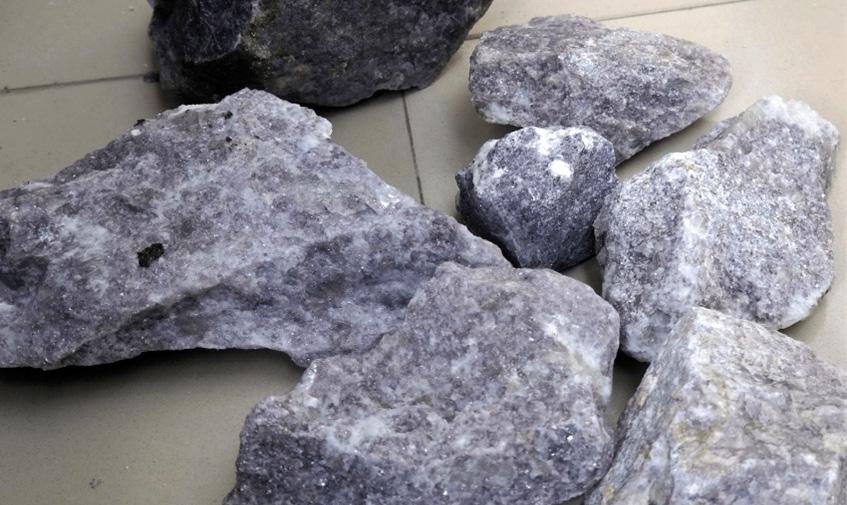
sometimes in palletised form, and is similar in appearance to an aggregate material.
The large particle size and relatively low friction mean that, if improperly loaded in the ship’s hold, there is a risk that the cargo as a whole (or individual rocks) could shift, creating stability issues, or causing damage to the vessel or stress to the ship’s structure.
Coarse material shipments have, up until recently, been considered uneconomic; as such, there is no individual schedule for them in the 2022 edition of the IMSBC Code. However, the increase in lithium prices has made coarse product shipments a more viable economic option, especially from remote mining operations or ones trying to develop early revenue streams before their concentrate processing facilities come online.
Fines and concentrates
In some regions, especially in Southern African countries such as Namibia and Zimbabwe, there is a focus on controlling natural resources. They aim to keep a firm hand on the export of raw materials by promoting value-added local concentrate processing. In some cases, full or partial bans have been put on the export of unprocessed (coarse) spodumene pegmatite. It is anticipated by the mining and material experts from Roxburgh that a pragmatic approach will be adopted, and
there will be a mix of ore and concentrates shipped out of these regions as the industry demand increases.
It is expected that the spodumene (upgraded) concentrate processing facilities currently under construction near mines and quarries will soon become operational. This process will involve spodumene pegmatites (raw coarse state) undergoing initial concentration via crushing and grinding to a fine particle size before the valuable minerals are separated (and a waste product is produced). The upgraded lithium concentrate can then be further processed to produce sand containing naturally occurring quartz and silicates – as well as valuable spodumene.
Carriage risks
As with other mineral concentrates, the potential risk of material failure during shipping, such as liquefaction, dynamic separation or cargo shift, will be controlled by the

cargo’s particle size distribution, mineralogy, and moisture content. Therefore, before commencing loading, the shipper must provide the ship’s master with accurate information on the specific properties of the cargo to allow for safe stowage and shipment.
The shipper should also provide evidence that a proper technical assessment for the potential Group A properties of the cargo has been undertaken. Moreover, the subsequent procedures for sampling, testing, and moisture management of the shipment are to be reviewed and approved by the competent authority at the port of loading.
In some developing regions exporting this cargo, there are concerns that procedures for sampling and testing may not have had proper consideration or oversight. Shippers are recommended to ensure they are provided with the relevant documentation well in advance of loading to allow for an appropriate review.
The marine environment and its commercial operations are in constant motion, presenting many opportunities and challenges for ship owners, managers, and charterers worldwide. To navigate these opportunities and challenges, NorthStandard, one of the largest P&I clubs in the International Group, is here to support you as a dynamic leader and trusted partner. Go to north-standard.com to learn more.

We provide a comprehensive suite of technical and advisory risk reduction solutions to private, corporate, and institutional clients investing in and shipping a geographically diverse portfolio of natural mineral resources. We act impartially without project equity. Head to roxburgh.co.uk to see more.

LEGAL 1/2024 | Baltic Transport Journal | 29
Photo: NorthStandard/Roxburgh
An eventful year for the Port of HaminaKotka
Keeping an upright position while on a bumpy road
by Jaana Niemi
For the Port of HaminaKotka, 2023 will go down in history as a time of great changes. There were considerable variations in transport volumes during the year, a significant port investment was completed, and there were successes in the international cruise traffic (a market that is, too, undergoing fundamental changes).
The Port of HaminaKotka has been transforming its port areas with a long perspective in mind. The biggest developments in recent years have taken place at the Mussalo Harbour in Kotka. Since 2017, the port company has been developing the D-area there to improve the service level and enable the increasingly efficient handling of larger vessels and cargo volumes.
In the first phase of the project, land operation areas were filled with material from the sea, the basic infrastructure of the area was set up, a harbour basin was dredged, a breakwater and a noise barrier were built in the western part, and the first part of the quay and a rail connection were constructed. At the same time, the port operator Steveco built a 20,000 m 2 pulp warehouse in the area.
In the second phase of the project, which finished last autumn, the quay was completed, and additional rail connections were added. Steveco erected another warehouse terminal of 24,000 m 2 . The City of Kotka also continued the filling of the background premises of the D-area to become an industrial site, which will enable the extra construction of almost 50,000 m 2 of warehouses in the northern part of the territory.
Investing environmentally
The project is a significant investment for both the Port of HaminaKotka and many other parties involved. Almost a total of €100 million – of which the port’s input totted up to €60m – has been invested in constructing and equipping the area. The waterworks and quay construction in the D-area, the rail connections in the background, and the noise barrier have been partially financed by
the European Union’s Connecting Europe Facility with a good €10m.
The Port of HaminaKotka has a permit to utilise concrete and brick waste in designated areas and to use waste rock in port structures. Environmental considerations are essential in port construction, and in the works of the D-area, they were taken into account by utilising concrete and brick waste left over from demolished schools and a bus station in the area structures. Rock material extracted from the sea during the dredging of the D-basin was used to build the breakwater, and some of it was moved to Palaslahti (located within Mussalo Harbour) to be used as a backfill for the industrial area.
“The port company started to develop the D-area of Mussalo so that even larger ships and the goods-flows they carry could be handled as efficiently as possible and so that containers and break-bulk could be handled in the same location, also optimising rail transportation. The D-area completed last year offers an excellent operating area for the international transport of the wood-processing industry, and the completion of this area will make the Mussalo Harbour of the Port of HaminaKotka the largest concentration of pulp transport on the Baltic Sea,” underscores Dr. Kimmo Naski, the Port of HaminaKotka’s CEO & Port Counsellor (satamaneuvos, a Finnish honorary title).
The port for all seasons
The past international cruise summer was, by all means, a successful one for the Port of HaminaKotka. A total of 13 ships called the port, two of which anchored in the Eastern Gulf of Finland by the remote island of Ulko-Tammio. The total number of visitors was about 20,000, with the passengers mainly coming from the
US, Canada, Australia, New Zealand, the British Isles, and Germany. The feedback received directly from the guests and the cruise lines was good.
“The absolute highlights of the season were the visits by the Silver Wind , the luxury cruiser of Silversea Cruises, at the island of Ulko-Tammio in early June. The visitors spent a day on the island, getting to know its beautiful natural environment and interesting fortification history. These visits also attracted considerable international attention,” shares Petra Cranston, the Port of HaminaKotka’s Project Manager – Cruise Business.
The cruise guests were particularly delighted by the parks of Kotka, where nature meets an urban setting in a unique manner. The Valkmusa National Park and the Langinkoski Imperial Fishing Lodge were also of great interest among the cruise visitors. The River Kymijoki, with its diverse activities, provided the visitors with unforgettable experiences, and the towns of Kotka and Hamina enchanted travellers with their versatility and individual ambience. Of course, we couldn’t forget to mention the Maritime Centre Vellamo or the magnificent archipelago!
Even though St. Petersburg, one of the leading destinations of Eastern Baltic Sea cruises, is no longer on the itinerary, the degree of occupancy rate on the vessels cruising in the region grew to an average of almost 90% last year. In 2022, the largest cruise ships withdrew from the Baltic Sea to different markets, but they intend to return (a move also influenced by the political situation in other parts of the world). The active sales and marketing efforts by the port company yielded results: the Port of HaminaKotka and the regional attractions got printed in cruise shipping companies’

30 | Baltic Transport Journal | 1/2024
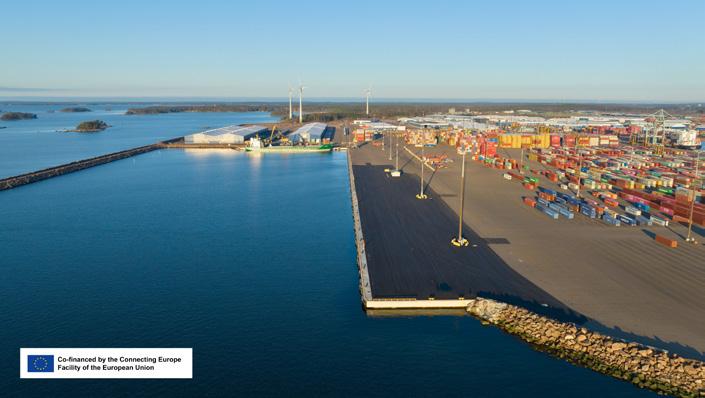
memories. Still, it takes time for consumer travelling & purchasing patterns to change. Expert estimates suggest that a better outlook for the Eastern Baltic cruise market can be expected from 2026 onwards. As such, the port company is busy preparing within a time span of almost ten years ahead.
Looking on the bright side (while on a roller coaster)
The Port of HaminaKotka started at a record pace in 2023, and after the first five months, the transport volumes were at their peak. At the turn of May and June, however, Finnish exports began to slow down, and the general economy, both in

Finland and in its key trading partner countries, started to decline. The situation at the Port of HaminaKotka was also impaired by the sanctions imposed on Russia. In 2023, these affected oil and methanol transport in particular. All that and the irregular entry of people into Finland that started at the border with Russia at the end of the year further eroded the operating environment. As a result, the cargo handling result of Hamina and Kotka fell short of the previous year by 13.2%, nonetheless amounting to a wholesome 14.1 million tonnes.
The outlook for 2024 is uncertain. The EU sanctions, the economic decline in Europe and Finland, significant sales


difficulties and increased costs of the Finnish exporting industries, disputes in the labour market, restrictions caused by the irregular entry of people into Finland at the Finnish-Russian border, and difficulties in international transport in the Red Sea and via the Suez Canal all muddy the waters for the port industry in general.
“Despite the current challenges, expectations in the longer term are still positive,” Kimmo Naski brightens the mood. “There are many different projects underway in our area, such as ones related to the car battery industry and future fuels, which, if realised, will also bring traffic to the Port of HaminaKotka.”



MARITIME 1/2024 | Baltic Transport Journal | 31
Photos: Port of HaminaKotka/Jarno Koivula
Photos: VisitHaminaKotka
Photo: Annika Ruohonen/VisitHaminaKotka
How a Baltic cruise ferry rescued a Finnish sailor in the middle of the Indian Ocean
Assistance at sea
A tiny, battered sailing boat floats next to a gigantic passenger-cargo ship. The mast of the boat is broken. No other vessels, let alone land, are in sight on the open sea. Soon, fuel and a typical Thursday dessert will be transferred to the sailing boat with the help of a rope. What is going on exactly?
Sailing the world’s seas can lead to all sorts of events, including unexpected encounters. The luck of Ari Känsäkoski, a Finnish Global Solo Challenge sailor, turned when he met Finnlines’ newest ro-pax vessel, Finncanopus, in the Indian Ocean. Känsäkoski needed fuel and supplies. A rapid operation was promptly initiated on Finncanopus
Ari Känsäkoski, Finnlines, and the Global Solo Challenge
The Global Solo Challenge, with Finnlines as one of the event’s partners, started in October 2023 in Spain. Ari Känsäkoski’s boat was a single-masted Class 40 Fuji, transported on board Finnlines’ Finneco II ro-ro from Kotka to Bilbao in the autumn of last year. It was in September 2023 when Ari met Finnlines’ Cargo Superintendent Timo Vanhala, whom he reached out to in time of need. Ari’s original goal was to sail around the world in 130-150 days.
In dire straits – and with the wrong bunker
On 22 December 2023, the solo sailor Ari Känsäkoski encountered rough weather with his Fuji sailing boat. The boat’s mast broke, but luckily, the skipper survived the crash without any acute emergency.
Alone at sea, one must be resourceful. Känsäkoski constructed what is known as an emergency rig, allowing him to (somewhat) use the remaining intact sails. In addition, he received marine diesel fuel from a Japanese fishing vessel, which, however, was not exactly the best fuel for the engine of the Fuji sailing boat, and Känsäkoski was in need of regular diesel. But where could one find diesel in the middle of the Indian Ocean? Other vessels were rarely seen on the horizon.
‘Operation Pancake’
The most incredible part of the encounter between Finncanopus and the Fuji sailing boat was pure chance. Finncanopus wasn’t even originally supposed to be in this part of the world! Additionally, distances at sea are vast. Something about the scale of the oceans is illustrated by Känsäkoski’s accident location in December, which was one thousand nautical miles, or nearly two thousand kilometres, from Madagascar and thirteen hundred nautical miles from Cape Town. Support teams or the nearest port were far, far away.
Känsäkoski had been struggling at sea for about 20 days with a damaged boat and the wrong type of fuel. While considering his options, Känsäkoski saw a news item about Finncanopus’ route, which led him to immediately contact Timo Vanhala at Finnlines, whom he had met before. The wheels started turning. Of course, Finncanopus would help!
The ferry, on her way to Durban in South Africa, was able to assist. Practically, the meeting route did not even slow down the journey
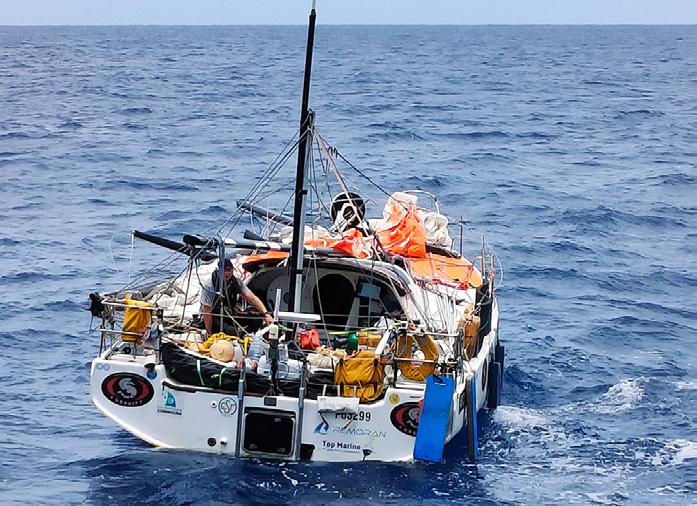
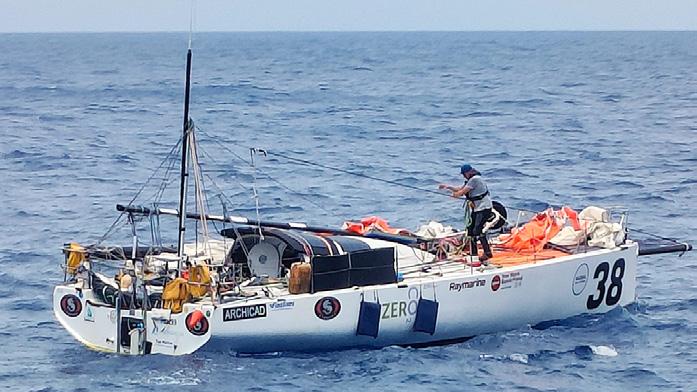


32 | Baltic Transport Journal | 1/2024
Ari Känsäkoski’s hardy Class40 Fuji sailing boat photographed from Finncanopus. Photo: Finnlines
After the accident that occurred in December 2023, Känsäkoski managed to get the broken mast on board. Photo: Finnlines
During the assistance mission, Finncanopus ’ Captain Jyrki Repo was in contact with Ari Känsäkoski via VHF radio. Photo: Finnlines


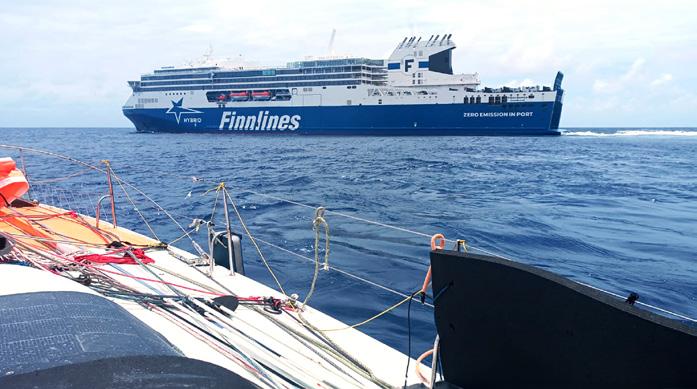
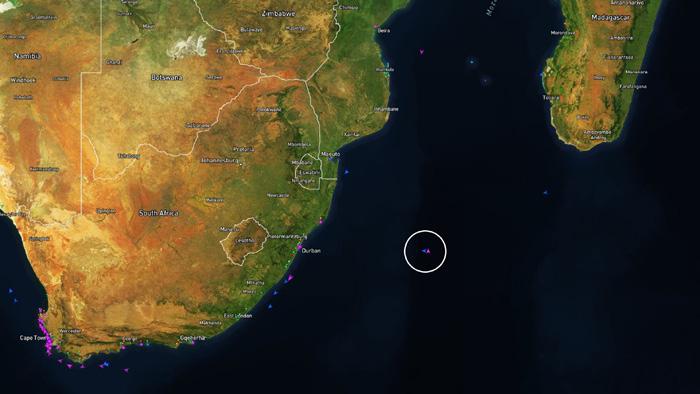
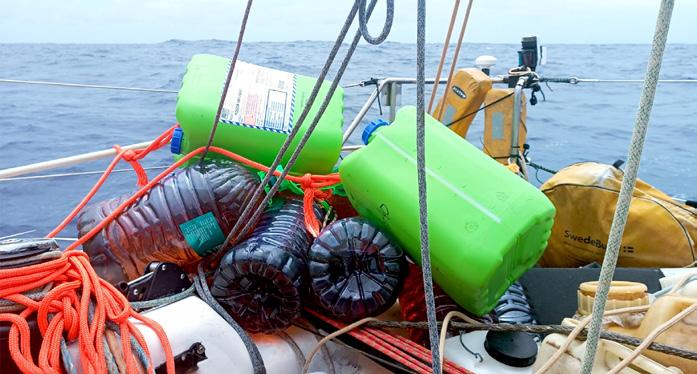
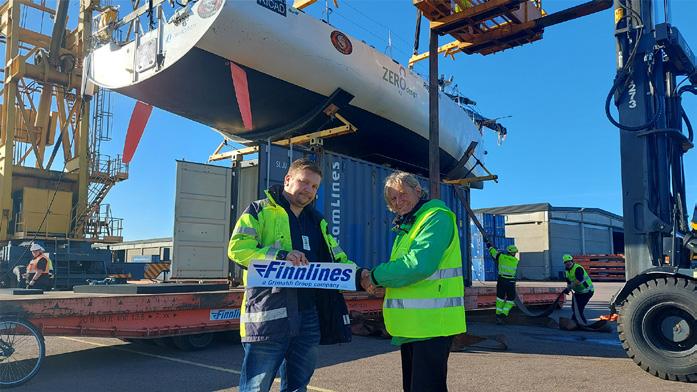
of our Superstar. The desired diesel was available on Finncanopus, and in addition, a food package was prepared in the mess. Since it was Thursday, the menu included pea soup and pancakes.
A million thanks
After the encounter, it was time for Finncanopus to continue her journey towards Durban. Ari Känsäkoski stayed on his Fuji boat to examine his assistance package. Later, we heard Ari’s message about the operation: “Finncanopus’ Captain Jyrki Repo manoeuvred around Fuji to smooth out the waves and stopped on the windward side so I could approach the pilot door. There was still considerable current from bow to stern, and the occasional swell made the approach challenging. After a few attempts, I safely got close enough, and a throwing line was sent to Fuji. After a quick tightening, cans began to be lowered into the throwing line with Jyrki keeping Finncanopus in slow motion, sideways towards the wind.”
“After lowering the cans,” Känsäkoski continued, “I moved to a safe distance, reeled in the line, and started lifting the cans. Finncannopus also lowered kitchen souvenirs in floating cans attached to a rope, which I later picked up. The surprise from the ship’s galley contained fresh pancakes, sweets, and an assortment of delicious breads, which made up the tastiest dinner of the trip. A million thanks to Finnlines and the skilled crew of Finncanopus , the galley, and the Captain!”
The operation was successful in every way. Fuji could continue towards Durban powered by clean diesel while Känsäkoski – by delicious food.
The story was first shared by Finnlines on the company’s blog. Go to finnlines.com/blog to check out other stories, too, including Finncanopus ’ journey towards the Baltic.

MARITIME 1/2024 | Baltic Transport Journal | 33
The meeting point of Finncanopus and the Fuji sailing boat (circled area). Photo: MarineTraffic
The operation was completed, and Finncanopus continued her journey towards Durban, a port city on the east coast of South Africa. Photo: Ari Känsäkoski
From deck three, through the pilot door, Deckhand Hardi Tiits had the honour of being the executor of the operation. Supplies and fuel were transferred to Ari’s boat using sling cloths. Photo: Finnlines
Let’s not forget the provisions! In the mess, Chef Peter Palander made sandwich snacks for sailor Ari Känsäkoski and also packed some fresh pancakes to take along. Photo: Finnlines
In September 2023, Ari Känsäkoski’s (on the right) Fuji boat was taken for transport by Finnlines. In the picture taken at the Port of Kotka, shaking hands with Finnlines’ Cargo Superintendent Timo Vanhala. Photo: Finnlines
The fuel and kitchen greetings were successfully transferred from Finncanopus to the Fuji sailing boat with the help of ropes and floatation canisters. Photo: Ari Känsäkosk
Working on Canada’s largest & most powerful Polar icebreaker
Designed in the Baltic
by Rami Hirsimäki, SVP Marine & Offshore Energy, Elomatic
The Turku-headquartered Elomatic is reaching the next phase in the design of a Canadian Polar icebreaker, which is set to be built by 2030. The project was initiated in early 2021 by the Canadian Government as a replacement for the 1969-commissioned/2000-refitted CCGS Louis S. St-Laurent , Canada’s current largest (gross tonnage of 11,345) and strongest (five 5,880kW engines) heavy icebreaker.
The overall aim of the project is to construct bigger and more powerful icebreakers than the ones currently operated by the Canadians. The country’s Coast Guard wanted to achieve this through a modern and effective design that can adapt to future requirements, fulfil its intricate mission profile, and enable extended operations at higher latitudes and in demanding Arctic conditions.
The vessel will be approximately 150 meters in length, have a top speed of over 18 knots, and accommodate up to 100 crew and personnel. The icebreaker’s operational range of about 30,000 nautical miles will enable it to stay in the Arctic for longer durations and allow the Canadian Coast Guard (CCG) to have a year-round presence. For comparison, the 119.8 by 24.4 metres Louis S. St-Laurent has a range of 23k nm, 57 berths, an endurance of 205 days, and can move at a maximum of 16 kn.
Going through the phases
Collaborating with Aker Arctic and Seaspan Vancouver Shipyards (VSY)
during the preliminary design phase, Elomatic contributed to reviewing and enhancing the vessel concept. The focus was on exploring design improvements, integrating cutting-edge technology, and ensuring adaptability to future demands.
The successful completion of the initial design phase led to a continued partnership between Elomatic and VSY in subsequent engineering stages, particularly the ongoing functional design phase (set to conclude by mid-2024). At this stage, Elomatic will be engineering the design to meet production requirements to build the vessel and will continue supporting the yard in improving its shipbuilding processes.
Adjustments were already made to the icebreaker’s helideck to meet current requirements. The steel hull of the new vessel was also optimised using nonlinear analysis tools, resulting in a lighter ship with advantages such as reduced steel weight, lower construction costs, and an efficient steel structure. Additionally, three different propulsion options were assessed, and extensive model tests in both
ice and open water were conducted to confirm the ship’s performance and manoeuvrability. Based on the results, a hybrid propulsion system with two azimuth thrusters and one centre-line shaft was proposed to the CCG and finally selected as the new propulsion configuration.
The production design phase is scheduled to commence this year, followed by construction around 2025, with the overall build process extending until 2030 and concluding with the delivery of the icebreaker to her owners.
Unforgiving nature
Considering the harsh Arctic ice conditions, the project team had to consider multiple challenges, such as what the extreme and unpredictable weather could throw the newbuild’s way, all the while ensuring the vessel can function effectively in the frigid and long-lasting winters.
The icebreaker also needs to be versatile to undertake various missions and conduct environmental research in unpredictable conditions. Considering

34 | Baltic Transport Journal | 1/2024
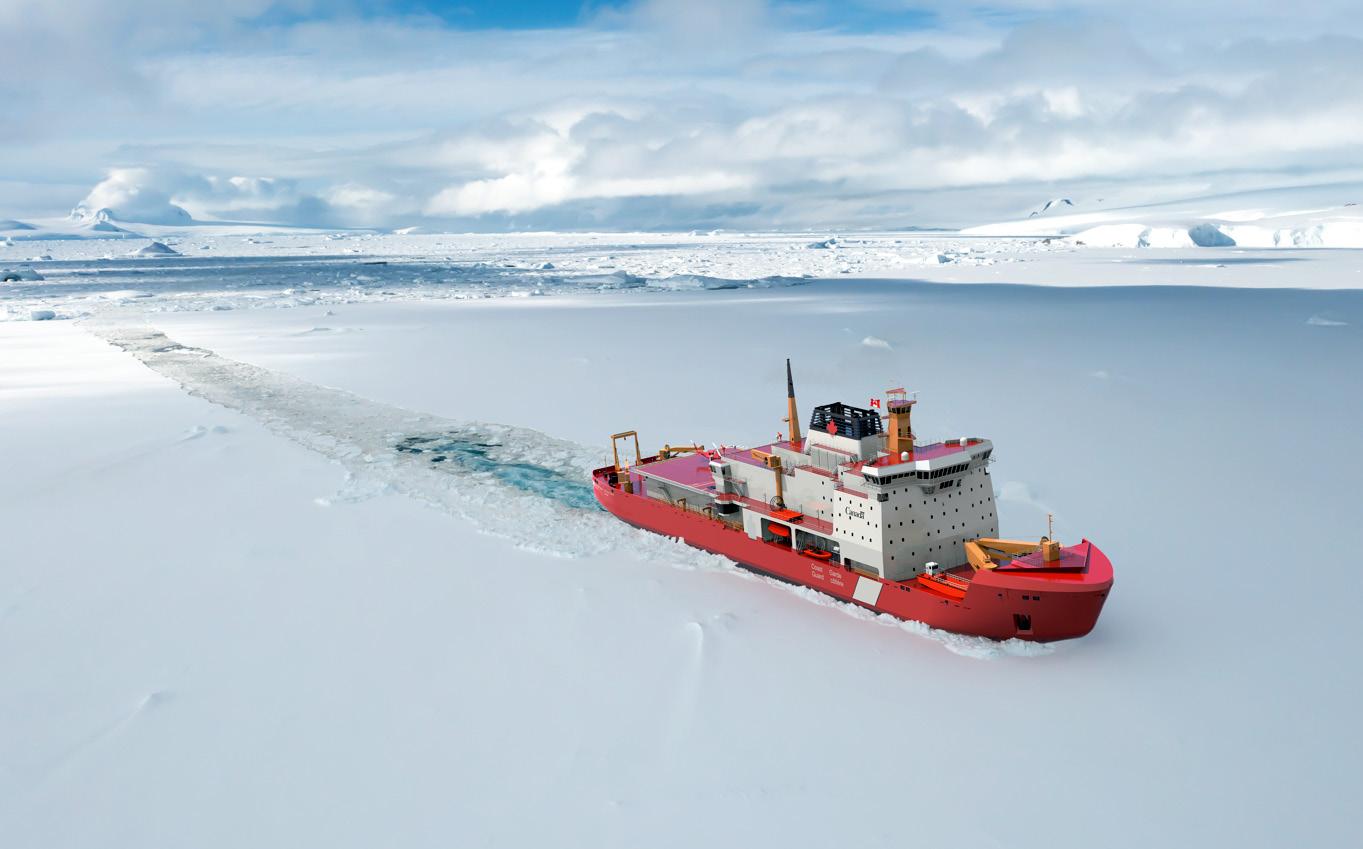
the remote nature of the Arctic, refuelling options are limited. As such, the ship’s fuel capacity must be high enough to last for extended periods.
The evolving regulatory landscape has posed significant considerations for the project team. Given the timeline leading up to the vessel’s delivery in 2030, the design and engineering teams have taken proactive steps to plan for potential regulatory changes where possible. However, due to the uncertainty of future regulations, a certain degree of adaptability and flexibility has been necessary at the design phase to ensure that the icebreaker remains compliant as it approaches its completion date – and well into the future.
Decision-handling
The Canadian Polar programme falls under the country’s defence sector, entailing 100% Canadian Industrial and Regional Benefits (IRB) obligations. Elomatic is committed to complying with the IRB requirements, envisioning opportunities to expand operations in Canada, reinvest, and create sustainable prospects, marking a significant milestone in the company’s strategic development within the partner country. Canada, on its part, is committed to renewing what is currently the world’s second-biggest icebreaker fleet (not to mention other vessels operated by CCG).
The project stands as a testament to innovation in Arctic ship design and underlines the importance of international collaboration across Canada, Finland, Germany, and Poland. The overarching goal is to make a positive impact in Canadian territory, enabling the country’s Coast Guard to operate effectively in higher latitudes, providing enhanced support, advancing high-Arctic science, and ensuring a rapid response to maritime emergencies.
The Polar icebreaker project is just another example of how Elomatic is helping yards and owners answer questions that will define the future of their fleets over the next several decades and set them up for success. From initial planning onwards, we can manage every stage of the design process to ensure that owners can get the vessels they need. We can confidently handle the most significant decisions that define projects, thanks to our ability to rapidly iterate and evolve designs while retaining and preserving complex details.

As showcased by this successful example, we can tailor designs to specific operational profiles, such as that of an (Arctic) icebreaker. We can adapt designs to specific operation profiles – simulating and forecasting how different concepts will perform over time, allowing us to rigorously test and prove designs at an early stage – saving time, money, and work later down the line.
Regardless of the type of vessel, Elomatic can help evaluate safety, usability and energy efficiency, designing the best possible concepts. Finding the right solution for each ship requires looking out for the optimal options, analysing possible solutions, and selecting (today) the most suitable one for a customer’s (future) fleet. This approach demands assessing the current state of onboard ship technologies and their respective (sometimes very individual) applications, future requirements, and the overall condition of the ship and its systems over many, many years of challenging yet fruitful operations.
Elomatic is an international consulting and engineering company that provides top-level expert services, products and turnkey solutions to process, machinery, marine, energy and pharmaceutical industries. We are focused on continuous improvement and sustainable development, and we are committed to design solutions that increase the wellbeing of people and the environment. Established in 1970, Elomatic employs 1,300 professionals, and has customers in more than 80 countries across the globe. Go to elomatic.com to discover more.

1/2024 | Baltic Transport Journal | 35
Photo: Elomatic
The Port of Hirtshals to become Northern Europe’s largest CO2 hub
Leap forward for an ambitious carbon capture & storage project
by Fitzwilliam Scott
Greenport Scandinavia – a project partnership consisting of INEOS Energy, Wintershall Dea, Evida, Biocarb Solution, the Port of Hirtshals, Aalborg Portland, Greenport North, EUC Nord, Hydrogen Valley, and Energy Cluster Denmark – has been granted €14.6 million by the EU Just Transition Fund to support the establishment of value chains for the capture, usage, and storage of carbon dioxide (CCUS). The size of the support underlines the initiative’s crucial importance for both the Danish and European goals of achieving net-zero emissions. The first vessel with liquefied CO2 is set to depart from Hirtshals in 2025.
The Port of Hirtshals is in the middle of planning a major step-up, which is expected to be completed in 2027. The increased area and improved accessibility – and, naturally, favourable access to geological storage sites – means that the Danish seaport will be well-positioned to become a leading European hub for the storage and shipment of CO2 . “We are in the midst of planning a significant expansion of the Port of Hirtshals, and in this context, the establishment of Northern Europe’s largest CO2 hub fits perfectly into our strategy. Making Hirtshals a hub for the storage and shipment of CO2 is obvious because our location is ideal in relation to the storage sites in the North Sea as well as potential future onshore or nearshore sites,” emphasises Per Holm Nørgaard, the port’s CEO.
In a nutshell, the ambition is for the seaport in Northern Denmark to develop into a hub for receiving significant amounts of CO2 from both home and abroad for intermediate storage. Subsequently, the CO2 is to be permanently stored in the empty oil & gas fields of the Greensand area in the Danish part of the North Sea (or in potential nearshore and onshore storages in North Denmark).
Off the ground
The project, which is the first of its kind in Europe with a complete value chain in place, will be rolled out in three phases.
The first involves the capture and storage of CO2 from regional biogas plants, transported by truck to an intermediate storage in the Port of Hirtshals before shipping to Greensand. Initially, the aim is to establish an annual shipment volume of up to 500,000 tonnes of CO2 from biogas plants in Northern Jutland starting from 2025/26.
Since the CO2 captured in biogas plants involves carbon that is absorbed as the processed plant matter grows, storing it will result in negative emissions. This means that the project can make a significant contribution to achieving the European net-zero-bymid-century goal (and, on the way there, contribute to the new goal of 90% emission reduction by 2040).
In the second phase, the potential volume is expected to increase to about 3.0mt/year from 2029, following the laying of CO2 pipe infrastructure to the intermediate storage facility in the Port of Hirtshals. The initial stretch is planned between Hirtshals and Aalborg to enable the transport of larger amounts of CO2 from industrial emitters, such as Aalborg Portland, Denmark’s only cement producer.
The company – part of the multinational Cementir Holding – has recently confirmed their goal to achieve net-zero emissions by 2050, committing to a cap on emissions of a maximum of 600kt/year by 2030 (a 73% cut compared to 2021). Michael Lundgaard Thomsen, Aalborg Portland’s CCO, says,
“We have joined Greenport Scandinavia because it is essential for Aalborg Portland to engage in an ambitious project that is already off the ground and ready and able to build a strong Danish CCUS infrastructure and deliver a reliable, safe and cost-effective CO2 handling solution as soon as possible.”
In the third phase, the potential volume is expected to exceed 15mt/year if Danish and Northern European infrastructures are connected in the early 2030s. Hence, the hub will be using the available off-, on-, and nearshore storage options to the fullest.
Fortifying the green transition
Greenport Scandinavia’s project partners INEOS and Wintershall Dea hold a storage license for Greensand from the Danish authorities. In March 2023, Project Greensand demonstrated the feasibility of cross-border, offshore CO2 storage across the entire value chain from capture to transport and storage, thus paving the way for the development of a full-scale international CCUS value chain to commence storage from 2025.
The world’s first cross-border CO2 storage was officially celebrated at an exclusive event in Esbjerg in the presence of then the Crown Prince, now King Frederik of Denmark, who initiated the injection of CO2 into the reservoir, and Lars Aagaard, the Danish Minister for Energy, Climate and Utilities, with Ursula von der Leyen, President of the European Commission, delivering a pre-recorded address.

36 | Baltic Transport Journal | 1/2024

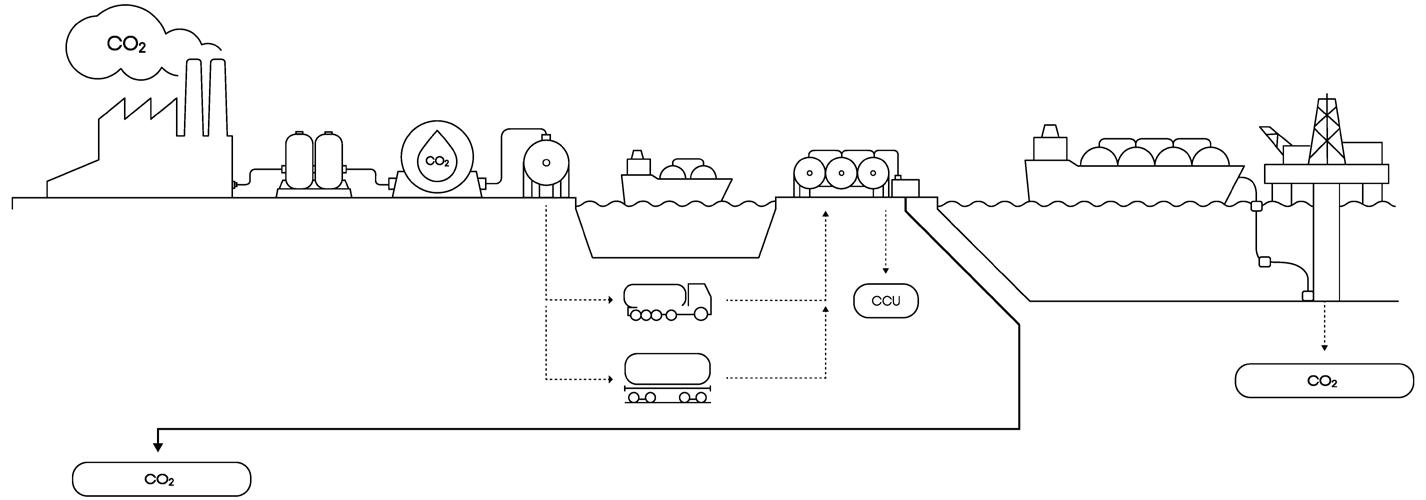
Greenport Scandinavia aims to provide emitters with alternative storage options as these become available. Applications for onshore CO2 storage licenses from nine companies and consortia are currently under review by the Danish Energy Agency (and nearshore areas are expected to be tendered soon).
The EU Just Transition Fund, which supports the advancement towards climate neutrality by alleviating its socioeconomic impact in the regions most affected, backs these far-reaching plans. On the allocation of €14.6m to Greenport Scandinavia, Morten Bødskov, the Danish Minister for Industry, Business and Financial Affairs, stated, “Green technologies play a crucial role in achieving the green transition. Storage of CO 2 is a significant part of the solution to meet the government’s ambitious goal of
climate neutrality by 2045. North Jutland is already well on its way to becoming an attractive market for investments in the capture, utilisation, and storage of CO 2 . I look forward to learning more about the new projects in the pipeline. This contributes to securing local jobs while providing substantial growth opportunities for the rest of society. Ambitious initiatives such as Greenport Scandinavia play a pivotal role in fortifying Denmark’s robust standing, guaranteeing our leadership in the ongoing and future green transition.”

New value
With the entire value chain and offshore storage in place, Greenport Scandinavia is positioned to be ready to receive CO2 by truck, train, or ship in the Port of Hirtshals before the end of 2025. In addition to managing CO2 from emitters, Greenport Scandinavia will be supporting potential carbon clusters wishing to tap into the knowledge and experience gained in developing new value chains and designing commercially viable multi-stakeholder business models for CO2 management.
The vision behind the project is to establish carbon capture, utilisation, and storage (CCUS) activities and create one of Europe’s largest CO2 import and export hubs in the Port of Hirtshals. Its mission is to create commercial CCUS value chains across geographical and industrial sectors. The purpose of the Greenport Scandinavia initiative is to support the Paris Agreement in limiting global warming to 1.5°C. Head to greenportscandinavia.com to learn more about the project as well as the partners spearheading the progress.

1/2024 | Baltic Transport Journal | 37
Photo: Port of Hirtshals
The Sustainable First Movers Initiative
‘Adversity is the mother of progress’
by Ewa Kochańska
Global ports and the cities and regions they serve play a vital role in international trade and the shift to sustainable energy. However, ports also have a history of causing adverse environmental impacts due to emissions and pollution. Last year, the Environmental Defense Fund, in collaboration with the Lloyd’s Register Maritime Decarbonisation Hub and in partnership with Arup, introduced the Sustainable First Movers Initiative (SFMI) Identification Tool in their The Potential of Ports in Developing Sustainable First Mover Initiatives report. This innovative solution aims to facilitate the maritime industry’s transition to cleaner energy sources by helping stakeholders identify ports ready for green investments. The SFMI tool also factors in socioeconomic and environmental consequences to ensure inclusive and sustainable outcomes on a worldwide scale.
The maritime industry, responsible for transporting around 90% of international trade, is a critical component of the worldwide supply chain. Shipping also generates roughly 3% of global greenhouse gas emissions (GHG-E); therefore, while taking steps to address its carbon footprint, the sector has been undergoing a fuel transformation.
Similar global transformations in numerous industries have often ignored the needs and circumstances of underdeveloped and developing regions, thus negatively affecting about 77% of the worldwide population. And, perhaps not surprisingly, presently, over 80% of clean energy investments are again made in only developed economies and China. However, if properly managed, the SFMI paper argues, the transition
to electrofuels (e-fuels), which is set to reshape the fuel market, could also offer significant opportunities for low- and middle-income countries.
The SFMI Identification Tool can facilitate this ‘fair’ transition by helping shift the maritime industry away from fossil fuels while addressing broader social, economic, and environmental circumstances. Specifically, the Tool identifies suitable port locations for investments while taking into account factors like e-fuel production, clean energy access, land suitability, decarbonisation efforts, and living standards. The system can also help spot lower-income regions where the deployment of more investment will be financially beneficial and necessary to safeguard the Paris Agreement targets. In some underdeveloped areas, conditions for renewable energy may be even
more beneficial than elsewhere because of unexplored renewable energy sources.
‘In the middle of difficulty lies opportunity’
The SFMI report mentions voluntary first-mover initiatives like the Clydebank Declaration and Clean Energy Ministerial promoting green shipping corridors and energy hubs as positive activities pertaining to reaching global climate goals. That said, these efforts have mainly focused on developed countries, leaving out the Global South and stakeholders such as port communities, which comprise 40% of the world population (living within 100 km of the coast).
Environmental damage and its consequences have disproportionately impacted the poorest regions, exacerbating existing vulnerabilities and

38 | Baltic Transport Journal | 1/2024
widening socio-economic disparities. These regions often lack the resources and infrastructure to adapt to changing environmental conditions, making them more susceptible to the adverse effects of climate change. Extreme weather events such as hurricanes, droughts, and floods have become more frequent and intense, devastating communities that rely heavily on agriculture, fishing, tourism, and natural resources for their livelihoods.
To ensure that e-fuel production brings fair socio-economic and environmental benefits, “significant” concessional finance (which is a below-market rate financing from major institutions in underdeveloped areas) will be vital in low-income countries as the investments there must increase fivefold by 2030 to achieve net-zero emissions by
mid-century. Focusing on the Global South for SFMIs can reinforce equitable benefits, while early engagement with shipping stakeholders, including port communities, can minimise negative impacts and create robust policies addressing inequality.
“SFMIs account for broader impacts on communities and the environment, truly ensuring that the transition is people-centred. This means that communities affected by such initiatives can benefit from their implementation rather than be put at risk,” says the report.
‘Innovation distinguishes between a leader and a follower’
The idea behind the SMFI Identification Tool is that while ports serve their pivotal role as pillars of
economies worldwide, they can also contribute to positive societal outcomes concerning improved air quality, sustainability, and socio-economic conditions.
Significantly, decarbonising shipping presents a substantial investment opportunity, estimated at over one trillion US dollars under appropriate regulations and commercial conditions. It would be hard to deny that societal change has a long history of being driven by opportunities to make money. For example, the Industrial Revolution broke new ground in manufacturing and transportation, leading to the creation of industries such as textiles and railroads. Still, it was primarily driven by opportunities to increase productivity and subsequently – profits. More recently, companies such as Airbnb or Uber transformed
Air Quality



SUSTAINABILITY 1/2024 | Baltic Transport Journal | 39
Current Air Quality Population Affected PM2.5 score PM10 score O 3 score NO2 score SO2 score Built Environment Land Use Terrain Land Suitability Solar Potential Wind Score Clean Water Availability Onshore Wind Potential Offshore Wind Potential Low Demand Low Energy Consumption Low Current CO2 Emissions Renewable Surplus Economic Improvement Low GDP per capita Low HDI Poverty headcount ratio at $2.15 Poverty headcount ratio at $6.85 Poverty Score Poverty headcount ratio at $3.65 AIS data points within 20 km AIS data points within 100 km AIS data points within 500 km
Traffic
Shipping
Fig. 1. The SFMI Identification Tool uses five criteria with underlying indicators
Renewable Surplus
Shipping Traffic
AIS data points within 20 km
AIS data points within 100 km
AIS data points within 500 km
Economic Improvement
Poverty Score
Poverty headcount ratio at $6.85
Air Quality
very traditional sectors – hospitality and mobility – by capitalising on the sharing economy concept. These companies have created new income streams while reshaping societal norms.
The global shift towards sustainability presents a massive market potential. As consumers and investors become increasingly discerning about environmental issues, they are more likely to support businesses that align with their values. Companies with solid sustainability reputations can tap into this growing consumer base, leading to increased sales and market share, and attract socially responsible investors and partners, providing access to additional capital and resources. Additionally, sustainable practices can
Wind Score
Onshore Wind Potential
Offshore Wind Potential
Clean Water Availability
Low Demand
Low Energy Consumption
Low Current CO2 Emissions
Land Suitability
Built Environment
Land Use
Terrain
Current Air Quality
PM2.5 score PM10 score
O3 score
NO2 score
SO2 score
Population Affected
lead to cost savings in the long run.
While initial investments in environmentally friendly technologies or processes are expensive, they often result in reduced resource consumption, lower energy bills, and decreased waste disposal costs. Over time, these savings can significantly boost a company’s profitability. Furthermore, early adopters can benefit from tax breaks, subsidies, and preferential treatment in government contracts, while failure to comply with these regulations can result in fines and reputational damage.
In line with past revolutions, the push for environmental accountability fosters innovation. Companies that invest in research & development related to e-fuels
will likely discover new technologies and processes that can lead to competitive advantages.
Given the significant stakes involved, ensuring that the transition to e-fuels includes developing and underdeveloped nations is crucial. These countries have suffered the highest economic and human costs of ecological irresponsibility of their wealthier neighbours, yet they have reaped minimal benefits from the opportunities presented by environmental innovation.
In searching for a proper definition of “just and equitable,” the report found that the present efforts to achieve a fair and balanced transition in the shipping industry focus on three main factors: addressing

SUSTAINABILITY 40 | Baltic Transport Journal | 1/2024
6% 3% 3% 2% 4% 2% 3% 14% 3% 7% 2% 1% 4% 2% 4% 5% 5% 5% 3% 2% 10% 6% 4% Solar Potential 6% 6% 2% 6% 3% 14% 3% 16% 4% 5% 5% 10% 10% 6% 4% 20% 20% 20% 20% 20%
GDP per capita Low HDI Poverty headcount ratio at $2.15
headcount ratio at $3.65
Low
Poverty
Fig. 2. Criteria weightings for Scenario A: ports exploring both fuel production and bunkering
Shipping Traffic
AIS data points within 20 km
AIS data points within 100 km
AIS data points within 500 km
Economic Improvement
Renewable Surplus
Solar Potential
Wind Score
Onshore Wind Potential
Offshore Wind Potential
Clean Water Availability
Low Demand
Low Energy Consumption
Low Current CO2 Emissions
Land Suitability
Built Environment
Land Use
Terrain
Air Quality
historical climate disparities, mitigating the disproportionately high GHG-E of wealthier nations, and alleviating the significant climate change costs endured by small island states and less developed countries. Additionally, the report underscores the importance of acknowledging the direct effects of the shipping sector on communities residing near ports, especially in the world’s less affluent regions.
As the use of e-fuels becomes more widespread globally, there have been delays in adoption due to differences in financial resources. Neglecting this issue could worsen the situation in underdeveloped regions, leading to extra costs and negative consequences for businesses and local communities. Therefore, it’s vital to include local port communities, particularly in economically disadvantaged
regions across the globe, while transitioning to e-fuels, understanding that they indeed are an integral part of this shift. Achieving such an inclusive transition will require collaborative efforts from all players in the industry: governments, ship owners, fuel providers, ports and their communities.
‘An investment in knowledge pays the best interest’
The SFMI Identification Tool was case-studied in the Indo-Pacific area, which was selected for its pivotal shipping routes and a unique mixture of Global South and Global North nations.
A multicriteria analysis was used to enable a thorough and balanced evaluation, which considered a variety of factors of different importance. The report
underscored that it is offering a preliminary evaluation of ports, and a more detailed analysis will come in the next stages of their work. This case study focused specifically on the production and use of renewable e-fuels with zerocarbon emissions (e.g., e-hydrogen, e-ammonia, and e-methanol).
The SFMI Identification Tool uses five criteria: the potential to deliver a surplus of renewable energy near ports; shipping traffic at the port and in the surrounding sea area; land suitability near the port; potential improvement in air quality; and potential improvement to local economies. Each port is assigned a weighted score and, based on that, a category: either ‘high potential’ for ports in the top 25% or ‘promising potential’ for ports in the next 25%.

1/2024 | Baltic Transport Journal | 41 9% 5% 5% 3% 6% 3% 4% 21% 4% 1% 8% 8% 8% 5% 3% 3% 2% 1% 9% 9% 4% 15% 30% 30% 5% 30% 5%
SUSTAINABILITY
Current Air Quality - 4% Low GDP per capita Low HDI Poverty headcount ratio at $2.15 Poverty headcount ratio at $3.65
Poverty Score Poverty headcount ratio at $6.85 Population Affected - 1%
PM2.5 score - 2% PM10 score - 1% O3 score - 0% NO2 score - 1% SO2 score - 1%
Fig. 3. Criteria weightings for Scenario B: ports mainly exploring fuel exports
Shipping Traffic
AIS data points within 20 km
AIS data points within 100 km
AIS data points within 500 km
Economic Improvement
Poverty Score
Poverty
Poverty
Poverty
Also, to ensure fair scoring, three scenarios were used. In Scenario A, the focus is on ports which are good candidates for developing SFMIs and investments related to exploring fuel production and bunkering. Scenario B emphasizes ports that are in the best position for SFMIs and investments in fuel production and export. The third scenario, C, focuses on ports which are best suited to develop SFMIs and unlock investments in fuel imports and bunkering.
Interestingly, some ports show high scores in specific criteria and very low in others – yet they classify as high or promising as the scores balance each other out. For example, the ultimately ‘high potential’ Port of Singapore scores low in land suitability and relative economic advancement but high scores in shipping traffic and air quality improvement even this out.
Scenario B-ports, while offering e-fuel production, do not provide strong local shipping demand, so their focus stays on fuel exports. In Scenario C, ports are capable of providing e-fuel storage and
bunkering; however, the fuel is not produced locally but imported.
The SFMI Identification Tool has the capability to illustrate to stakeholders the numerous advantages of involving a diverse pool of collaborators and ports. This perspective can identify ports that might otherwise be overlooked for such initiatives. Additionally, according to the report, “shipping’s decarbonisation does not happen in isolation,” and many potential outcomes must be examined.
The SFMI Identification Tool can assist financial institutions and governments in identifying optimal investment areas and also help achieve climate objectives while protecting the environment and uplifting communities that have been forgotten in the green transition.
‘The secret of getting ahead is getting started’
Environmental sustainability represents a lucrative business opportunity in today’s world. As consumers, governments, and investors prioritise sustainability, companies that embrace it can gain a competitive
Land Suitability
Built Environment
Land Use
Terrain
Air Quality
Current Air Quality
PM2.5 score
PM10 score
O3 score
NO2 score
SO2 score
Population Affected
edge, reduce costs, and access new markets. History has repeatedly demonstrated that societal change occurs when opportunities to make money align with the greater good, making sustainability a compelling proposition for businesses.
The shipping sector’s fuel transition will change the fuel market fundamentally, but it’s vital to include underdeveloped and developing economies in this transformation for ethical, environmental, and financial reasons. SFMIs, aligned with the 1.5°C Paris Agreement target, aim to provide environmental, social, and economic benefits (particularly in Global South regions, but that doesn’t mean other corners of the globe cannot take advantage of the methodology).
The SFMI Identification Tool, while identifying lower-income areas where the deployment of investment is beneficial and necessary to achieve net-zero emissions by 2050, guides stakeholders in assessing a port’s potential and supports regional planning and development.

SUSTAINABILITY 42 | Baltic Transport Journal | 1/2024 1% 7% 1% 13% 4% 2% 8% 5% 8% 3% 3% 3% 2% 1% 20% 12% 8% 32% 5% 10% 40% 10% 40%
GDP per capita Low HDI
Low
headcount ratio at $2.15
headcount ratio at $3.65
ratio at $6.85
headcount
Fig. 4. Criteria weightings for Scenario C: ports mainly exploring fuel imports and bunkering
Source for all figs.: The Potential of Ports in Developing Sustainable First Mover Initiatives
"THE BEST "THE BEST MAP OF MAP OF THE NEW THE NEW SILK ROAD SILK ROAD !!

* NOT A REAL QUOTE (BUT WOULD BE IF MARCO POLO WAS HERE WITH US – SCAN THE QR CODE AND CHECK FOR YOURSELF!)


The challenges with decarbonising bulk carriers
Know the differences to make a difference
by Kostas Gkonis, Secretary General, and Emmanuel Vergetis, Regional Representative Greece, INTERCARGO
Over the last few years, we have seen a (rather rough) perfect storm of events. Following the turbulent pandemic time, our industry now finds itself dealing with the situation in Ukraine and recent attacks on ships in the Red Sea, the legacy of COVID and, of course, the incorporation of the International Maritime Organization’s (IMO) greenhouse gas (GHG) reduction targets into everyday operations.
The shipping industry has made significant progress in reducing its carbon footprint during the past decade and is striving to achieve IMO’s ambitious goals, which may soon start aiming for zero-emission shipping by mid-century. As the industry works towards achieving the unanimously agreed upon IMO 2050 targets, dry bulk shipowners are keen to play their part in meeting the ambitious decarbonisation objectives, and 2024 will surely bring more opportunities to share knowledge and work together to protect the marine environment.
In need of a systemic approach
INTERCARGO firmly believes in safe decarbonisation and that environmental excellence requires collaboration. If we are to witness a future with zero-emission shipping, responsibility cannot be placed entirely on the shoulders of shipowners. It must be remembered that the commercial development of (effective and safe) green solutions is within the control of a spectrum of stakeholders. Such a target requires a drastic and urgent acceleration in the commercial development of the needed technologies, fuels, propulsion systems, and related infrastructure.
It is fundamental for governments, legislative parties, and all stakeholders to understand that the decarbonisation of shipping is a whole system challenge and affects not only the vessel but also its wider operating environment. Most investments are therefore needed for land-based infrastructure and low- and zero-carbon fuel production.
It is worth highlighting that dry bulk carriers’ GHG emissions are amongst the lowest per tonne-mile of cargo carried, and bulk carrier vessels represent one of the most
economical and, thereby, environmentally friendly transport modes on Earth. Based on the Fourth IMO GHG Study 2020, the most significant carbon intensity reduction was achieved by bulk carriers, where the overall EEOI and AER (both operational GHG emission metrics) in 2018 were around 38% and 31% lower compared to 2008. Bulkers represent 43% of total capacity but are responsible for only 35% of all shipping emissions.
Models of trade
Shipping is primarily divided into the liner or tramp model, the latter characterised by vessels sailing in irregular trade patterns calling various ports worldwide. Over 65% of the around 13,000 bulk carrier fleet are engaged in this tramp trade.
Vessels of the liner model, typically container ships, often carry time-sensitive and refrigerated cargoes. Thus, these need to sail faster due to time pressure, whereas tramping vessels are not as time-constrained, with the cost per tonne being a more critical factor. Tramping shipowners tend to be asset managers, with the charterer responsible for the cargo carried, the vessel’s speed, and ports of call. In contrast, for container carriers, the owners have operational control.
For regulations to be equitable and effective, knowledge of all shipping sectors and models is necessary. To successfully deal with the massive task of decarbonising a world fleet comprising thousands of vessels of different sizes and shapes, regulators must understand the particulars of the two main maritime economic models. Furthermore, the tramp shipping model does not easily allow for operational optimisation, which would lead to further reductions in GHG intensity.
On top of the challenges above, due to irregular trade patterns, we also need to add the substantial capital expenditures of energysaving devices, highlighting that their cost (e.g., of wind-assisted propulsion) is much higher proportionately for the bulker fleet vs other sectors. This situation may negatively extend the return on investment horizon and make the business case less attractive. There are also novel technologies (at least for the shipping sector), such as onboard carbon capture, the true sustainability of which remains to be thoroughly validated.
Ports, fuels, ship design, and people
While the majority of bulk carrier owners eagerly await new fuels – as long as these are safe, promptly available, and permit a sustainable business model – shipping will be competing with other industries that are also trying to decarbonise (such as aviation, which aspires to become net zero carbon by 2050).
The GHG reduction potential of e-fuels, produced using green hydrogen and CO2 (i.e., e-hydrogen, e-methane and e-ammonia, or liquids like e-methanol or e-diesel), depend entirely on abundant renewable electricity. This prerequisite is questioned since the supply of green power is forecasted to remain in high demand. It is essential to look at any potential future marine fuel from a lifecycle GHG intensity perspective to provide clear & navigable ‘readability’ of the new fuel roadmap. There is too much confusion regarding the ‘green credentials’ of (bio)LNG, blue fuels, and so on, whilst stakeholders (the World Bank, EU, etc.) still debate if LNG is a suitable transition fuel.
There has been much discussion regarding the Green Corridors concept, too. While it might benefit some types of vessels (mostly

44 | Baltic Transport Journal | 1/2024

those serving fixed routes), it may not be suitable for most bulkers that are tramp trading. Instead, dry bulk shipping needs green ports above all else.
The most robust path for zero-carbon fuels is through dual-fuel engines and systems to ensure flexibility in bunker selection, but the multi-fuel pathway for bulk tramp shipping is much more challenging than for other segments. Alternative drop-in fuels would be in high demand and probably unavailable globally in sufficient quantities and locations. Furthermore, the dry bulk shipping sector does not enjoy national subsidies and has little political influence, let alone leverage over fuel suppliers.
Shipyards and marine designers must also play their part and develop ship concepts that integrate technology that can be practically and safely implemented on board. Yet, there are also inherited constraints with certain types of dry bulkers. For instance, smaller geared vessels present the designer with a cargo section forward of the engine room bulkhead where deck tanks for alternative fuels cannot be located. In addition, the deck cranes leave little room for the increased storage volumes required by alternative, low- or zero-carbon fuels.
Last but certainly not least is the human element. The shortage of skilled seafarers will continue to be one of the biggest challenges for most dry bulk owners and operators. Crew competence for most pure bulker operators (i.e., not operating LNG/tankers,
etc., and thus their crews not having adequate experience with alternative fuels yet) may prove to be one of the most significant threats in the decarbonisation journey, particularly as alternative fuels (some of them toxic by nature) are becoming more complex to handle on board.
Spinning the Ariadne’s thread
In common with other shipping industry sectors, our members face a confusing conundrum of MARPOL amendments, circulars, resolutions and guidelines as they work to turn the green ambition into reality. We at INTERCARGO work hard to guide our members through this maze, as no one can navigate it alone. Partnership has, is, and will continue to be critical.
Against this backdrop, INTERCARGO continues to address the key issues the dry bulk industry has always faced. Our Association’s working groups deal with the safety, environmental, and regulatory aspects, as well as security and broader challenges that INTERCARGO, as a collective body representing the sector, takes the lead on.
Through INTERCARGO’s presence on the IMO scene, we are able to influence

industry-wide decisions and impacts on our sector. As an Association closely working with its members, INTERCARGO understands how IMO instruments affect the operations of our vessels and crew and their unique trading patterns – the implications of which are, unfortunately, not always fully understood outside the dry bulk industry.
During their regular meetings, INTERCARGO’s Committees explore the impact of new legislation and technologies on vessel operations to further projects on safety and environmental issues, likewise to share successful solutions. With some 3,300 ships of 325 million deadweight, our more than 250 INTERCARGO members now represent about one-third of the global dry bulk fleet tonnage, thus strengthening the Association’s global influence. The enlargement and vigour of our organisation allow members to benefit even more by coming together and sharing their experiences.
Having a strong voice enables INTERCARGO’s membership to build on solid foundations as we face and together address the challenges detailed above (and many more).
The International Association of Dry Cargo Shipowners (INTERCARGO) is representing the interests of quality dry cargo shipowners. The Association provides the forum where dry bulk shipowners, managers and operators are informed about, discuss and share concerns on key topics and regulatory challenges, especially in relation to safety, the environment and operational excellence. Go to intercargo.org to learn more.

1/2024 | Baltic Transport Journal | 45
Photo: Port of Kemi
The energy transition’s new duck in the pond
by Alexa Ivy
When asked to name a renewable offshore energy source, most people would probably say “wind.” That’s a perfectly logical answer because, after all, the offshore wind energy industry is well-established. The first farm was up and running back in 1991, and around 20 countries have to date started harvesting power this way. When asked to name a second renewable source, a smaller number of people would say “tidal,” referring to the energy gleaned from areas of strong tidal currents. Even fewer people would give “solar” as their answer. This is not surprising because offshore solar power generation as an energy sector is still in its infancy. But that doesn’t make it any less important or attractive. It is here – and it’s growing fast!
With this in mind, looking to discover more about the challenges and opportunities of developing and deploying offshore solar energy, we take a look at the 2020-founded SolarDuck, a DutchNorwegian cleantech company with big ambitions for the energy transition, putting its Offshore Floating Solar (OFS) systems forward as a realistic alternative to fossil fuels as well as a ‘booster extension’ to offshore wind energy farms.
SolarDuck’s mission focuses on accelerating the energy transition. “Our aim is to develop offshore floating solar energy to a point where, from 2030 onwards, we are deploying in excess of 1.0GW per year,” says CEO and Co-founder Koen Burgers. “To achieve this, we are currently involved with numerous international demonstration projects – in Japan, Malaysia , and the Netherlands.”
Solutions to challenges
The design and technology behind OFS systems are based on various factors; sea conditions, environmental impact, reduction of maintenance, safety, and scalability all play a huge role. While it must be noted that SolarDuck is not the only OFS company in the market, its solutions to each of these factors give a broad impression of the challenges and solutions of OFS projects.
To cope with the exposed weather conditions found in offshore waters, SolarDuck has designed its floating systems as triangular or hexagonal platforms topped with solar panels. The geometric shape provides a cost-effective and structurally flexible yet stable construction. For mooring solutions,
the innovator looked to the design of floating oil rigs and floating offshore wind turbines for lessons learned.
In terms of the environmental impact of floating solar platforms, it is crucial to reduce this to a minimum. In practice, this equates to minimising the reduction of air and light flow below the solar panels. It is for this reason that SolarDuck’s systems are raised to a distance of three to ten meters above the water surface depending on wave height, allowing free flow of air. Open grating around and between panels enables the transmission of sunlight below the platform.
With an eye on reducing lifecycle maintenance costs associated with marine fouling and salt deposition, SolarDuck’s floaters have a small surface area to minimise marine growth, and the solar panels have a self-cleaning 10° tilt to prevent the buildup of salt. The entire construction is fabricated from offshore-grade aluminium, which is said to be able to last 30+ years in the corrosive offshore environment.
Safe access (e.g., by maintenance personnel) is provided by offshore-standard grated walkways. What’s more, the seakeeping behaviour of the entire structure is such that only low levels of movement and acceleration are experienced by people working ‘on board.’
The final aspect to take into account is scalability or, more to the point, costeffective scalability. To make this form of energy generation as accessible as possible, SolarDuck has set up its company processes and supply chain to make sure that costs are kept to a minimum throughout all stages of production, installation, and
operations. This includes solutions such as containerised logistics and commercial off-the-shelf components, straightforward assembly, and installation requiring small & inexpensive workboats.
New (solar-hybrid) lands
As the world faces the numerous challenges of climate change, one of the biggest questions is: when will OFS make its mark? Burgers highlights the scarcity of land as the driving force behind the anticipated growth of OFS. “Of course, onshore solar will remain a vital component of our future energy mix, but the fact is that space on land is getting more and more limited. We are going to have to move solar power offshore to meet our future energy requirements. To this end, perhaps the biggest advantage of offshore floating solar applications is the availability of space, something that is in very short supply throughout the coastal metropolises around the world.”
The potential for OFS power generation can be illustrated with two of SolarDuck’s current projects: Merganser and Hollandse Kust West (HKW). The former is an industry collaboration between SolarDuck and several Dutch research institutes. The aim is to develop, test, and validate solar energy platforms that are capable of functioning reliably in the toughest North Sea weather conditions (including hurricane-speed winds and 14-metre-waves). The latter has been, in turn, heralded as the world’s largest hybrid offshore floating solar farm.
Both are close to Burgers’ heart.
“Merganser was one of our first projects,

46 | Baltic Transport Journal | 1/2024
Collecting solar power – offshore

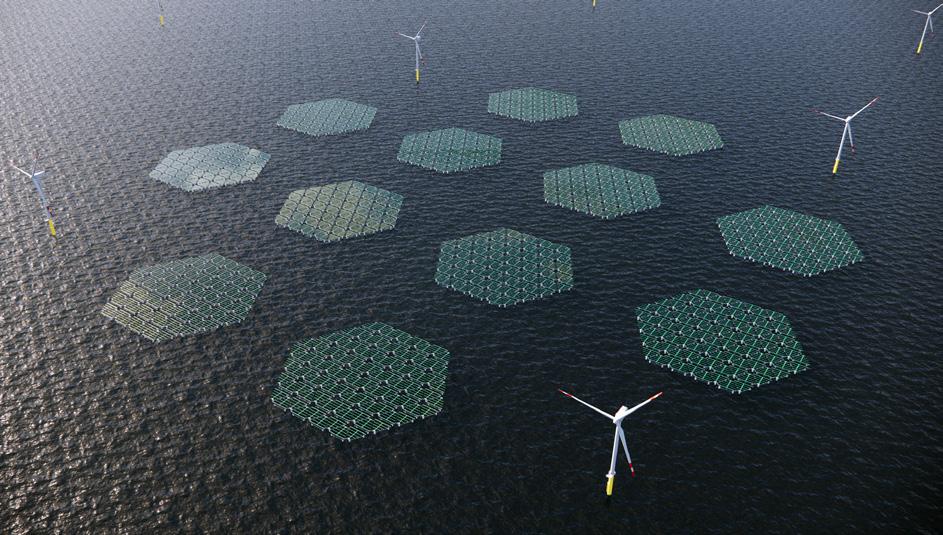
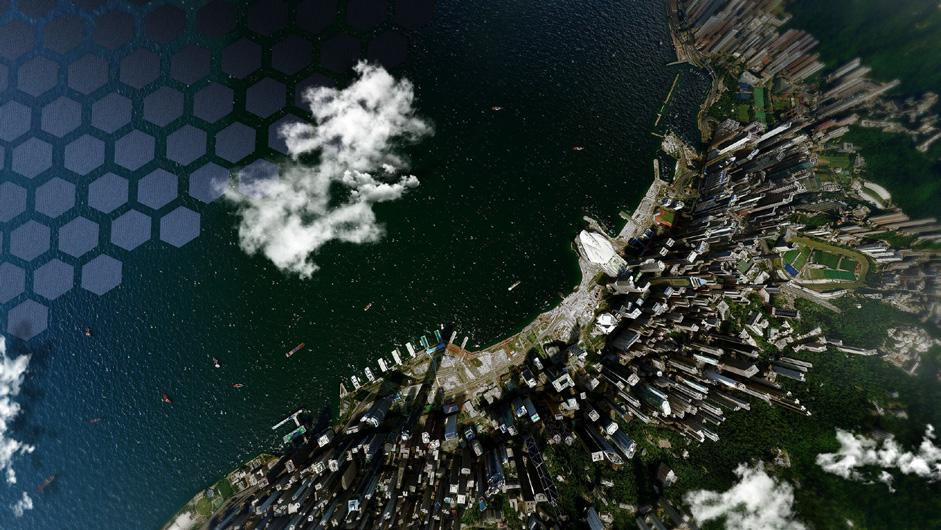
consisting of six interconnected triangular floating platforms, each measuring 42 meters side-length. The key point is that OFS is an easily scalable technology; Merganser will start its life generating 5.0MW of renewable energy at sea, but we see this idea getting upgraded to gigawatt scale.”
“And then we have HKW,” he continues, “our flagship project. But more importantly, it’s a groundbreaker for the whole OFS industry because it is a hybrid project.” What Burgers means by that is that floating solar panels will be installed
in between offshore wind turbines. He explains, “Wind turbines are positioned a considerable distance apart from each other. As such, there is a lot of space within an offshore wind farm that we can use to install an offshore floating solar park. Looking at the number of offshore wind turbines currently active in the North Sea, hybrid projects where wind and solar complement each other will really make optimum use of both space and infrastructure. This will yield significant benefits in terms of stability of energy supply.”

Hotspots
Another key question to ask is: where will OFS make its mark the most? The answer to this can be found by looking at the Earth’s latitude. Just as there are windy areas of latitude (and it’s no coincidence that the world’s offshore wind energy farms are located in these zones), there are also sunny areas of latitude, forming the so-called ‘sunbelt,’ which lies in tropical countries with latitudes of within 40° of the equator.
“These are ‘hotspots’ for solar power energy generation,” notes Burgers. “Crucially for OFS, these areas are characterised by their low average wind speeds – this will make installation and operations much less challenging. Furthermore, these ‘sunbelt’ countries often experience land scarcity. It is for this reason that we see great opportunities in urban conglomerations in Asia: Japan, Singapore, and South Korea, for instance, as well as the island nations of the Caribbean. In fact, we have already signed agreements with partners in Malaysia to undertake a feasibility study and in Japan to build a demonstration project – both signifying ‘OFS firsts’ for both countries.”
Burgers is excited about how SolarDuck is stretching its wings beyond its European roots. More than that, however, he is keen to show the world the benefits of OFS. “Due to rising populations, the need for urban development and agricultural land will only increase in the coming decades. With energy demands increasing, Offshore Floating Solar offers real promise for the decarbonisation of our energy supply.”

SUSTAINABILITY 1/2024 | Baltic Transport Journal | 47
Photo: Rotterdam Innovation City
Koen Burgers; photos: SolarDuck
Turn up the volume!
by Fitzwilliam Scott
On the understanding that ‘green’ methanol will run vessels almost emission-free one day, commercial shipping is increasingly looking favourably on a fuel type which – in its current form – is widely used in other industries. As such, technical inquiries poured in after SRC Group secured Approval in Principle (AiP) for a concept that “reinvented methanol fuel storage” on board ships. Delivering the answers has seen technical talk quickly converting into project discussions.
Methanol, currently derived principally from natural gas, is available, relatively easy to handle, and predictable. Lower-carbon today and potentially zerocarbon tomorrow, methanol, therefore, offers a practical alternative to heavy fuel oil (HFO) and a pathway towards ticking off the International Maritime Organization and EU’s decarbonisation targets.
As of September 2023, methanol had been specified for 216 newbuilds, according to figures from DNV. Clarksons recently estimated that 1,200 ships could be running on methanol by as early as 2030. That is, indeed, much methanol that needs to be stored somewhere.
How to free capacity – safely
Methanol’s other “outstanding” characteristic is its space inefficiency: tonne-fortonne takes 2.4 times more to generate the equivalent energy as HFO.
Conventionally, tanks storing low flashpoint fuels on board ship feature cofferdams
of at least 600 millimetres (mm) across to separate internal and external walls. Included as a safety precaution, the gap nevertheless restricts capacity.
Imaginative design can help find unused spaces for extra storage aboard a newbuilding, but opportunities are more limited on existing vessels. Where retrofitting a dual-fuel engine to run on methanol is feasible, the fuel storage issue may restrict a ship to short voyages or demand more frequent bunkering – both of which undermine the return on investment.
Understandably, huge interest greeted Lloyd’s Register (LR) AiP for SRC Group’s ‘Methanol Superstorage’ in October 2023. According to the designer from Estonia, the retrofitted tank storage solution increases volume by as much as 85% and can be installed with minimal impact on the general arrangement.
New use of “old” tech
The Methanol Superstorage dispenses with the cofferdam altogether and instead
installs tank walls formed by the sandwich panel system (SPS) technology. This solution sees a continuous polymer core injected between two steel surfaces.
Approved for permanent repairs by all major members of the International Association of Classification Societies, SPS has been used in maritime and offshore applications for over two decades, including for corrosion repairs in ship structures. The secured class approvals have involved laboratory testing of the polymer core material for chemical resistance, among others, for methanol. SRC, as an engineering, procurement, construction and installation service provider, has experience with complex refits across 5,000+ projects worldwide, including an extensive understanding of the patent-protected SPS technology process.
For the Methanol Superstorage fuel tank, a 25-mm-thick steel-polymer-steel barrier provides protection against fire or leakage that is equivalent to a conventional tank, according to SRC. The injected

48 | Baltic Transport Journal | 1/2024
Addressing the storage challenge of methanol as a marine fuel
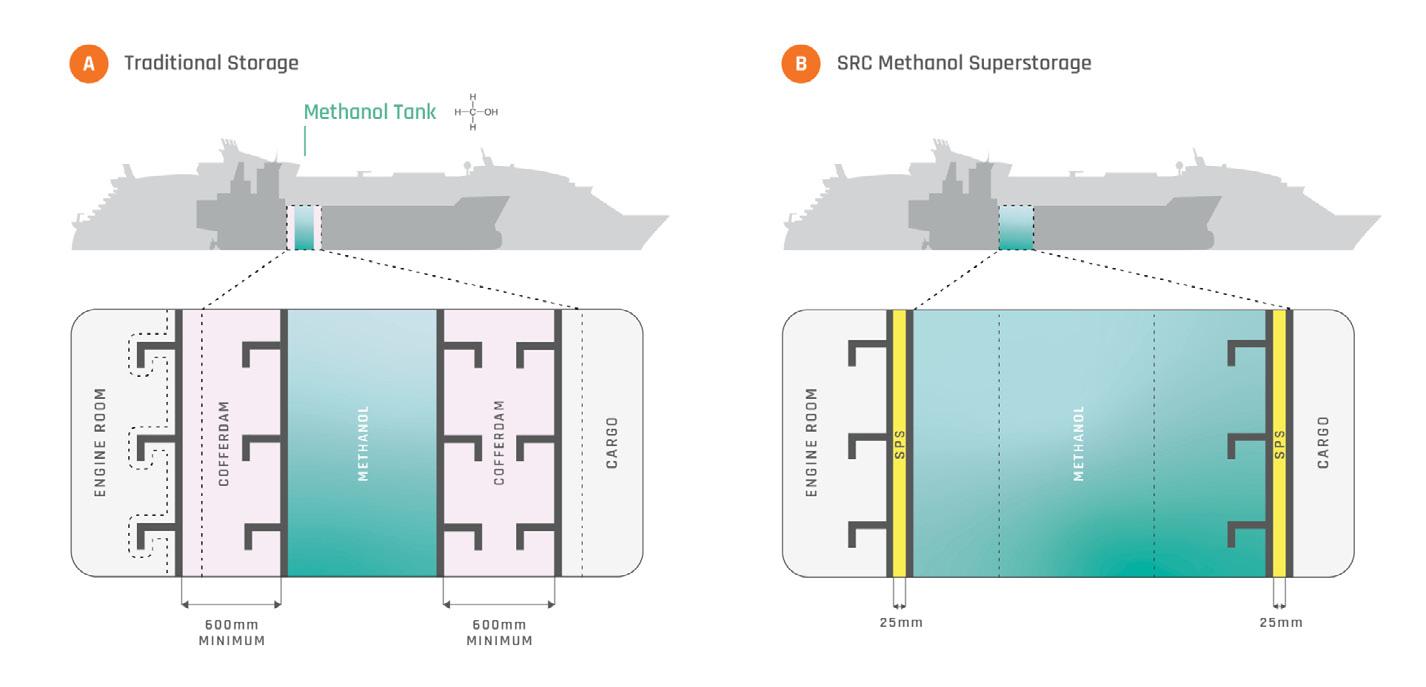
polymer also creates oxygen-free conditions behind the steel plates to prevent corrosion. The sandwich panel system can be used in place of cofferdams on all tank boundaries (incl. those facing shell plating).
“We always knew how significant Methanol Superstorage would be because existing ships need to play a full role in energy transition if GHG emission targets are going to be met and storage capacity is a key challenge,” says Hannes Lilp, SRC Group’s CEO. He furthers, “We are already in detailed discussions with a well-known ferry line, while we’ve been approached by cargo ship operators, offshore support vessel owners, tug companies, shipyards in Europe and Asia, and by the marine engine suppliers. One area that has surprised us has been the high level of interest from the super yacht sector.” Less surprising has been the flow of inquiries from cruise ship owners, many of whom have already studied the feasibility of retrofitting ships for using methanol as a marine fuel.
“These are new and confidential discussions, but what I can say is that live projects are under review to accommodate consideration of Methanol Superstorage, while one project that looked dead is being revived,” comments Lilp. The in-flow of technical questions from all corners of the maritime industry has been “almost overwhelming,” he adds.
No showstoppers
Securing AiP provides a technology developer with a statement from class
confirming there are no significant obstacles to future certification or classification. As explained by LR, it allows an innovator to “gain early confidence that your technology has the potential to satisfy regulatory requirements.” It also means that “stakeholders will have confidence in their investment.”
Discussions covering approvals from other classification societies are ongoing, shares Lilp, although he acknowledges that the journey length from AiP to full class approval is substantive. In an area where fuel storage regulations are evolving, additional scrutiny can be expected. “Due to the regulatory status of low flash point fuels, all methanol fuelled ships need to go through a Risk Based Certification process that includes full risk assessment for the whole methanol fuel system from bunkering station to the engines,” comments Alex Vainokivi, Innovation Manager, SRC Group. “AiP is part of the risk assessment. Any final approval for a methanol fuelled ship comes from the Flag State Administration,” he adds.
Nevertheless, key SPS technology characteristics are not in dispute. “For example, under fire testing, and when the core thickness for SPS structure is more than 25 mm, it has satisfied the fire safety

objectives and the functional requirements of SOLAS A-60 regulations without the need to install thermal insulation,” underscored Vainokivi. He continues, “We will establish whether inerting and venting are needed on a case-by-case basis –and the same for fire and leakage detection – but the requirements relating to cofferdams can be dispensed with. From that perspective, the solution provides equivalent ‘triple barrier protection’ to prescriptive requirements for cofferdams adjacent to all space categories – including accommodation.”
Happy to answer
Lilp says the most frequently asked question SRC has been fielding concerns whether Methanol Superstorage is as appropriate for newbuildings as it is for retrofits. “The answer is an emphatic yes: fuel storage tanks can be constructed using the SPS sandwich panel system in lieu of cofferdams on both new build and refit projects,” he explains.
“Actually, we seek to open more direct channels of communication for questions from major shipbuilders and designers worldwide because of requests from our commercial ship-owning clients. As before, we are only too happy to answer,” Lilp sums up.
We are well-positioned with knowledge and capability to support climate targets in the maritime industry, with 90% of SRC’s business volume directly arising from the Green Transition. Our company provides solutions for ballast and wastewater treatment systems, shore connections and retrofits, installing exhaust gas scrubber systems, integration of alternative fuels, and anything that helps convert your ships to
greener and more efficient future. Set course for src.ee to discover more.

SUSTAINABILITY 1/2024 | Baltic Transport Journal | 49
meet a
Photo: SRC Group

Baltic transport 2023 highlights
by Przemysław Myszka
The past year was again rife with different kinds of green developments taking place (or at least announced) across the Baltic Sea region, on- and offshore. There was, however, a noticeable shift in where the focus was placed. Whereas liquefied natural gas (LNG) always supplied a sizeable portion of news bits, other future fuel candidates garnered more attention last year (and methanol called the tune here). The same holds for offshore wind energy, with all sorts of organisations – including, naturally, the regional seaports – deciding the time is ripe to put their money where their mouths are. Capturing, storing, utilising, and shipping carbon also became a topic in and of itself (likewise the uptake of electric trucks and charging them, leastways in the Nordics). At the same time, cold ironing is still very much a thing in the Baltic Sea, while ports and terminals harvesting themselves solar energy is increasingly becoming one (and some will harness wind, too). The latest round-up only justifies that the right time came for us to create the Baltic Green Map and the accompanying Catalogue, the go-to publications if you want to quickly get the lay of the (green Baltic) land (and sea).
Onshore power supply (OPS)
Last year kicked off with news that the Port of Helsinki made it possible for all liner traffic vessels visiting the Finnish capital regularly and mooring for longer to cold iron at its city centre harbours. As such, ships can now draw energy from the shore everywhere at the Port of Helsinki’s newest ferry terminal. The port authority underlined, “Providing onshore power more extensively than before is one of the most important measures in the Port of Helsinki’s carbon neutrality programme [making its operations climate-neutral by 2025]. The greatest positive environmental impact can be achieved with regular liner traffic in particular, but in the future, OPS will be provided in Helsinki to cruise ships and cargo vessels as well.” Concerning the latter, the port began providing OPS in its Vuosaari Harbour for Finnlines’ Travemünde traffic in 2023. According to the port’s Head of Sustainable Development, Andreas Slotte , “Shore power reduces the emissions of berthed
vessels by 50-80%. This figure is probably closer to 80%, but we’re making a conservative estimate, as vessels are not heated with shore power during colder weather.”
Later, in April 2023, Tallink & Silja Line shared that its Megastar ferry started drawing electricity from the shore in Helsinki . Specifically, the ferry cold irons while berthed at the West Harbour, meaning that the Estonian shipping line ‘plugs’ in Helsinki, Stockholm, and Tallinn. The ferries Megastar and MyStar connect to OPS during their overnight stays at Helsinki and Tallinn, respectively. During her daytime port visits, the cruise ferry Baltic Queen is cold ironing at Tallinn and Stockholm. The company’s other cruise ferries, Silja Serenade and Silja Symphony, are connected to shore power during their daytime port stays at Stockholm and Helsinki. According to Tallink Grupp, drawing power from ashore decreases Megastar and MyStar ’s monthly CO2 emissions by 112 tonnes each (1,344t/year), Baltic Queen’s by 95t/1,140,
and Silja Serenade and Silja Symphony ’s by 154t/1,872t. The company’s total yearly use of OPS spares the environment some 7,572t of CO2 emissions, additionally lowering in-port noise pollution. “We are pleased that the significant effort made both by Tallink Grupp as well as our partner ports in Tallinn, Stockholm and Helsinki has got us to a point where our operations are increasingly environmentally friendly and sustainable. It has not been a simple project and has required significant investments both on our part in terms of retrofitting our ships with the necessary equipment meeting the EU standards, as well as the ports, but the end result is worth it and an important milestone on our journey of developing sustainable shipping in the Baltic Sea region,” Captain Tarvi-Carlos Tuulik , Head of Ship Management at Tallink Grupp, commented.
But probably the brightest OPS highlight of 2023 made headlines in February, with the event’s culminating point later in November.

REPORT 1/2024 | Baltic Transport Journal | 51
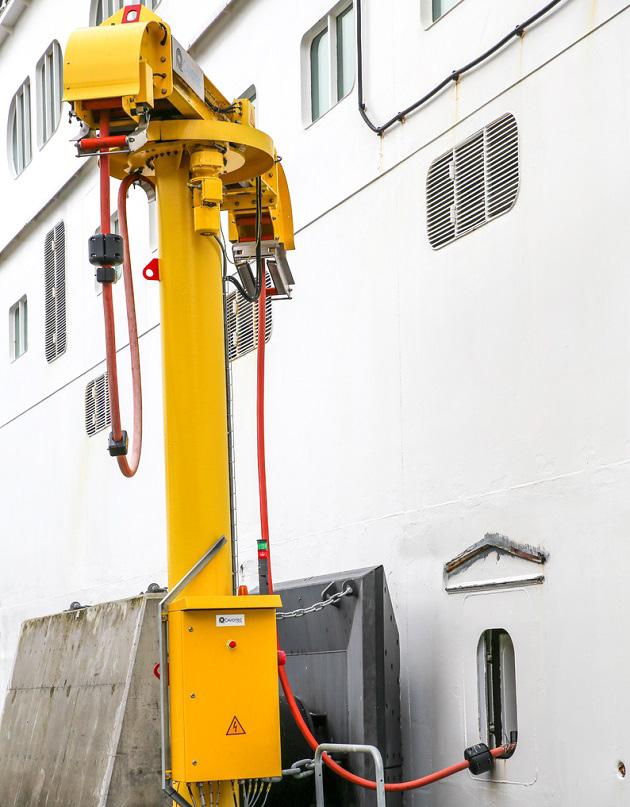
Just before March, Terntank carried out the first connection to an OPS facility at the Port of Gävle with a tanker (though without any electricity running through the cable). The test was done with Tern Fors, whose crane was used to hoist the connector cable from Gävle’s brand-new cold ironing installation. The test was performed to go through the connecting checklist, ensuring that safety is maintained throughout the whole process (incl. manual and automatic steps), as OPS-connecting a tanker differs from cold ironing other vessel types since the risk of explosion is ever-present when flammable cargo is being handled.
In January 2023, the PSA-operated container terminal Baltic Hub from Gdańsk ordered 20 automated sideloaded stacking cranes from Künz (with ABB tech) for the under-construction 1.7 million TEUs/ year T3 expansion. The machinery will offer a span of 32 metres and two cantilevers of 8.5 m in length each. The lifting height will be 1-over-6. The cranes’ structures will consist of a double girder gantry with Künz’s patented trolley, equipped with a 4-drum hoist with direct outgoing ropes to the headblock. The headblock will be, in turn, equipped with micro motion, allowing for fine positioning in the trolley and crane travel direction.

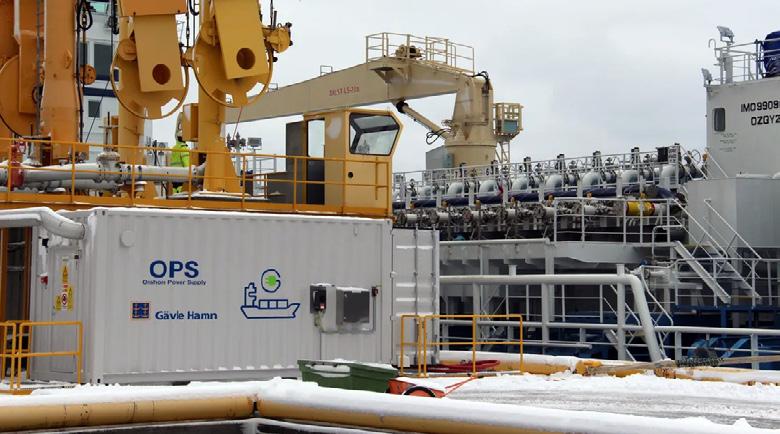
Then, on 16 November, the same Tern Fors drew electricity from the shore in Gävle , marking a new milestone for the development of OPS in (Baltic) seaports. The tanker was connected for over three hours, consuming 1,424kWh, and used the electricity to run its unloading equipment. To enable safe cold ironing, the containerised OPS unit on the quay was overpressurised with air so that no gases could enter it, while the connecting room on board the tanker was filled with nitrogen to keep the oxygen level below 5% to prevent any sparks from leading to explosion. Also, the vessel is equipped with battery
Automation
The system also corrects a possible skew. ABB will supply the electrical equipment (incl. automation). The company’s technology consists of 3D laser systems with cameras that allow load- and unloading automatically in the truck area and the container stack. The cranes will be delivered in several phases beginning in early 2024 (the manufacturer plans to go live on the terminal in Q2 of 2024). The final units will be completed by the end of H1 2025. “We selected Künz and its partner ABB for several reasons, such as their patented hoist and gantry design and tailored automation solution for Baltic Hub. Together with Künz, we will take great
packs, ensuring no blackout will occur if the OPS connection is lost.
Worth mentioning is that the Port of Gävle also partakes in the Green Cable project, led by the Port of Gothenburg , which is tasked with devising a global standard for tanker cold ironing in hazardous environments. Apart from Gävle, only the Port of Long Beach at BP Terminal ’s Pier T offers OPS (8.0MW at 6.6kV) for tankers.
Two other regional seaports included OPS into their portfolios last year, Naantali and Kapellskär, but more about that in the passage on the launch of Finnlines’ Finnsirius in the shipping part of this round-up.
steps on our automation journey that will increase Baltic Hub’s productivity while helping us achieve our ambitious sustainability targets,” Mustafa Doğan , Technical Director at Baltic Hub, underlined.
Also in January last year, HHLA Next invested in the FERNRIDE tech startup from Munich, with HHLA granting access to its sea container facility in Tallinn’s Muuga Harbour. Subsequently, FERNRIDE began trialling its solution (for the first time in a container terminal) for the gradual automation of trucking operations. Specifically, trucks and tractors were equipped with sensors and cameras for remote-controlling via mobile networks by

REPORT 52 | Baltic Transport Journal | 1/2024
Photo: Tallink Grupp Photo: Terntank
Photo: YIT
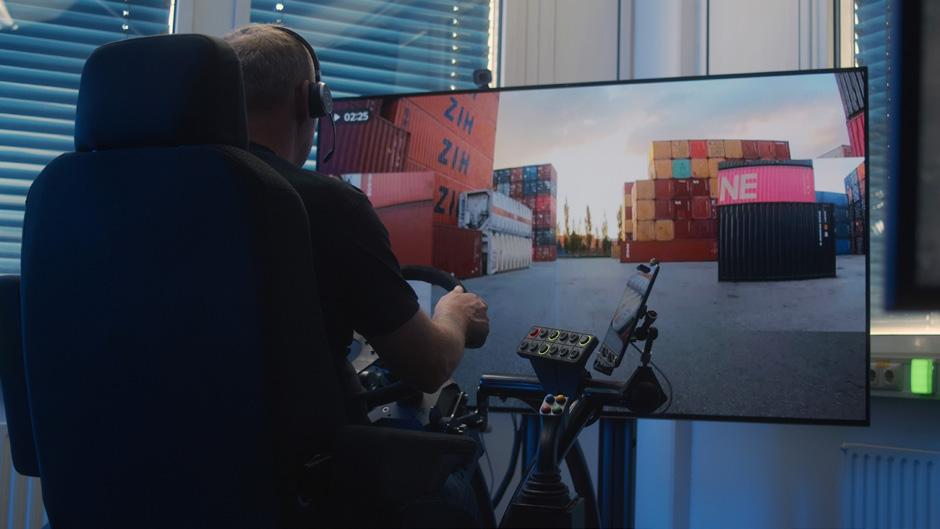
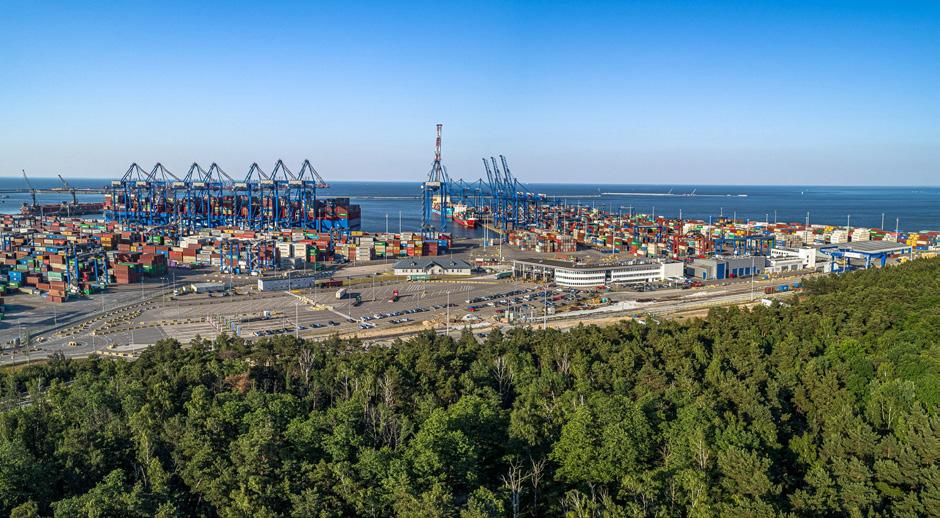

operators at a computer workstation resembling a vehicle cockpit. FERNRIDE said the algorithms could be further trained using real-time operational data to roll out additional autonomous functions. “We at HHLA Next invest in digital and sustainable business models in maritime logistics. We see great potential in autonomous
driving solutions, also because of the current lack of truck drivers. With FERNRIDE, we are investing in a company that has already implemented a viable solution with a partner network of respected companies from industry and logistics with very good results. In addition, the project highlights our focus on sustainable logistics,” Simone
Lode , Managing Director of HHLA Next, commented at the beginning of 2023. Fast-forward to July 2023, and after ticking off the first phase of their joint remote/ automated trucking project in Estonia, HHLA and FERNRIDE agreed to proceed. The yard truck that FERNRIDE equipped with sensors and cameras already transported containers between the quayside in the Muuga Harbour and the yard via remote control. With the start of the second phase, autonomous driving got integrated into operational processes. For this purpose, an additional automated yard truck was deployed at the terminal for container transport, with the goal of the follow-up to achieve a degree of autonomy of at least 80-90%. “Thanks to the joint project with FERNRIDE, we have been able to test the system directly in the operational business of HHLA TK Estonia. The implementation has proven itself in daily terminal operations, so that proof of concept could be achieved at an early stage. We will now continue our excellent collaboration with FERNRIDE and will work together to see how autonomous driving might work in the future. Our goal is to create work processes at our international terminals that are future-oriented and sustainable,” said Philip Sweens , Managing Director of HHLA International. Martin Isik, FERNRIDE’s CCO, added, “We are looking forward to the next phase of productive and successful collaboration with HHLA. Our mutual trust and the desire to positively transform the sector make us perfect strategic partners in the implementation of our platform for autonomous electric trucking in port areas. Our partners are impressed by the platform’s advantages, including the increased efficiency and safety for our employees, the reliability of our operations and the easy scalability of the solution. HHLA shares our values and our ambitions of scaling this technology internationally, and the TK Estonia terminal offers ideal conditions to lay the foundation for this.” Meanwhile, HHLA Next for the second time invested in FERNRIDE (Series A financing). The company’s Simone Lode said on this occasion, “The successful project in Tallinn once again underlined FERNRIDE’s professionalism as well as the immediate operability of the system. This strengthened our decision to expand our investment. With FERNRIDE, we are investing in a company that provides ‘human-assisted autonomy.’ This is already a functioning, reliable solution that is paving the way towards autonomous driving.”
In June last year, the Chinese ZPMC delivered two hybrid (Li-ion batteries-diesel)

REPORT 1/2024 | Baltic Transport Journal | 53
Photo: HHLA/FERNRIDE
Photo: APM Terminals Aarhus
Photo: Künz
automated straddle carriers to APM Terminals Aarhus, which runs a container terminal in the Danish seaport. The new machinery joined the prototype Blue Bot that has been operating within a test area since 2022’s start (performing over 6,000 lifts and driving 800 km till the news bit saw the light of day). The Blue Bots are part of ZPMC’s automated straddle carrier
programme and were built explicitly for APM Terminals Aarhus based on specifications and learnings from the initial operations in the reefer area and picking & placing containers to and from a test quay crane lane. “We are proud to be part of the development of these highly advanced GPSoperated automated straddle carriers. We have been testing the first straddle carrier
Wind #1 – offshore energy
Harnessing wind power was in all probability the trend that received the most tailwind in 2023. The year kicked off with the announcement that PKN ORLEN , a Polish state-owned energy company, received the permit to start constructing its offshore wind energy (OWE) installation facility in the Port of Świnoujście , due for commissioning in 2025. The terminal will feature two berthing places, each 250 m long. The facility’s set-up will not only enable handling single OWE components but also make it possible to assemble larger elements (incl. 100-m-tall towers).
PKN ORLEN’s terminal in Świnoujście will assist in erecting the company’s 1.2GW Baltic Power OWE farm some 23 km off Poland’s coast near Choczewo and Łeba (a joint project carried out with the Canadian Northland Power). Baltic Power is planned to come online in 2026.
At the same time, news came from Denmark that the Port of Esbjerg will invest in the digital twin technology to triple its wind installation capacity. With the help of the California-headquartered Moffatt & Nichol, the Danish seaport is developing a solution thanks to which Esbjerg will be able to handle 4.5GW of offshore wind components by 2025. “This computer program is fed huge amounts of data, enabling it to analyse all port processes related to the shipping of offshore wind installations, using a 1:1 simulation of the port. Everything from storage
locations of wind components and space requirements to the impact of high tide and much more,” the Port of Esbjerg explained in a press release. Dennis Jul Pedersen, the seaport’s CEO, underlined, “Working with the digital twin is a game-changer. We can make much better decisions using that tool. It means that we can triple our capacity at Port Esbjerg without expanding by a single square metre.” He furthered, “We are now the first port in the world to have a digital twin for offshore wind. However, it could play a huge role in the deployment of wind installations across the whole of Europe in the coming years. There is a lack of space at most wind ports in Europe, so we need to pull the ports out of our spreadsheets and create more digital twins instead.” Moffatt & Nichol’s Marine Structure Engineer, Joshua Singer, who was also the Project Manager behind developing Esbjerg’s digital twin, commented, “The ability to digitally develop the port and physically see the project happening gives you the opportunity to identify issues and efficiencies before any significant capital investments are made, and that’s a hugely powerful tool for the offshore wind industry.” Esbjerg’s capacity will steadily increase from 1.5 to 4.5GW/ year by 2025 when the required changes are completed (among others, rebuilding of various access roads). “There is no reason to think we’ll stop at 4.5GW, and the same goes for increasing capacity in the rest of

in a small, enclosed area which has provided valuable learnings and insights for the development of the next models. With the new Blue Bots, we are now ready to expand our test area to 65,000 m 2 in order to further analyse and optimise the technology to fit our operation and enhance safety,” highlighted Mikael Gutman, APM Terminals Nordics’ Managing Director.
Europe. And that’s before we even start expanding the ports,” Jul Pedersen claimed.
Shortly thereafter, also in January 2023, the European Offshore Wind Port Declaration was signed in Esbjerg. The ports of Cuxhaven, Eemshaven, Esbjerg , Humber, Nantes-Saint Nazaire , and Oostende joined forces to speed up the green transition to meet Europe’s offshore wind deployment targets. “[…] the six of us signed a declaration stating that we will do everything we can to support Europe’s ambitious aims. In May [2022], the politicians set the framework with the original declaration, and today we’ve started to act on the challenge they gave us all by raising skyhigh the targets for offshore wind,” Esbjerg’s Dennis Jul Pedersen commented. He was referring to the Esbjerg Declaration, which saw Belgium, Denmark, Germany, and the Netherlands pledge to deliver a minimum of 65GW of offshore wind energy capacity by 2030. “[…] In other words, Europe aims to install well over five times as much offshore wind in the next eight years as we have built during the previous 20 years. This target puts great pressure on European wind ports because there is currently not enough port capacity to install all these offshore wind farms by the deadline,” said the signatories of the European Offshore Wind Port Declaration in a press brief. The parties will share best practices, e.g., using the digital twin to increase handling capacity without physically enlarging their harbours.
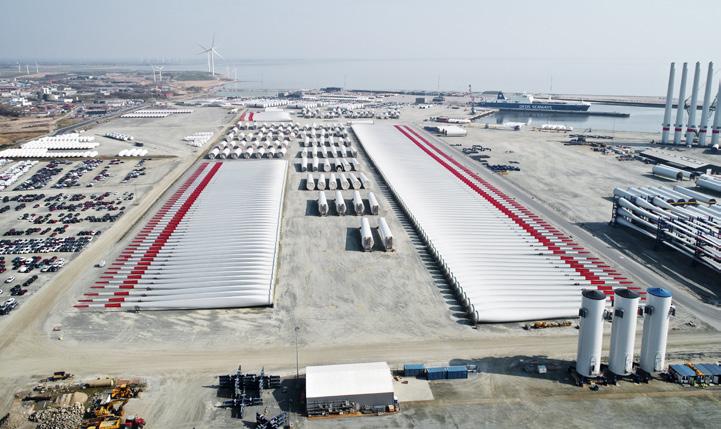

REPORT 54 | Baltic Transport Journal | 1/2024
Photos: Port of Esbjerg

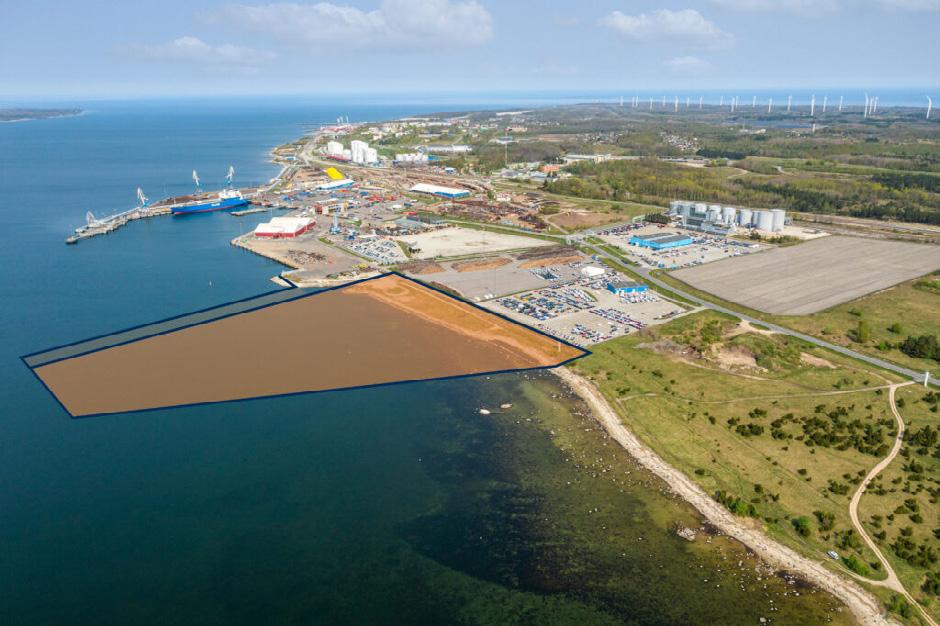

They will also collaborate on getting around the issue of, among others, space shortages, such as when one port only has space for half a project, another may have room for the other. Dirk Declerck, the Port of Oostende’s CEO, noted, “This collaboration is important, because we make each other stronger. Likewise, it is very important for the green transition that we exchange knowledge and experience and share professional information with all stakeholders in the offshore industry, so we can create a professional platform.” The European Offshore Wind Port Declaration was underwritten in the presence of Isabelle Ryckbost, Secretary General of the European Sea Ports Organisation, who took this opportunity to underscore that “The importance of ports in Europe should not solely be calculated in tonnes, but should also be assessed in terms of their contribution in the deployment and supply of energy, in particular renewable energy. I am very excited to see these six important wind energy ports joining their efforts and leading the way in view of reaching the EU offshore goals. Through cooperation it will be easier to face the identified headwinds.” According to WindEurope, 2023 saw the addition of a record 4.2GW of new offshore wind farms in Europe (of which 3.0GW in the EU, incl. the Dutch 1.5GW Hollandse Kust Zuid), up 40% on 2022. The EU built 17GW of new wind energy capacity last year. That was more than ever in a single year; however, WindEurope notes that it’s still short of the 30GW/year of new wind that’s needed between now and 2030 for Europe to align reality with its green ambitions. That said, wind energy accounted for a not insignificant 19% of all electricity produced in Europe’s last year.
Next month, the Port of Tallinn and Utilitas Wind , an Estonian heat & energy producer, signed a memorandum of understanding to accelerate the regional OWE industry, jointly working on the development, construction, and maintenance of OWE farms in the Baltics. On its side, Tallinn intends to add an installation quay in its Paldiski South Harbour. The €53m investment will see the set up of a 310 m long quay and adjacent 10 ha yard. Meanwhile, Utilitas Wind is working on the Saare-Liivi OWE farm in the Gulf of Riga, to be ready in 2028. The first stage of development will include installing 80 turbines with 1,200MW total capacity (over 5.0TWh of expected annual electricity generation). “Cooperation between strategically important sectors is of key importance to ensure that new generation capacities are built as soon as possible, bringing down the price of electricity and

REPORT 1/2024 | Baltic Transport Journal | 55
Photo: Port of Tallinn
Photo: Port of Kaskinen
Photo: Port of Szczecin-Świnoujście
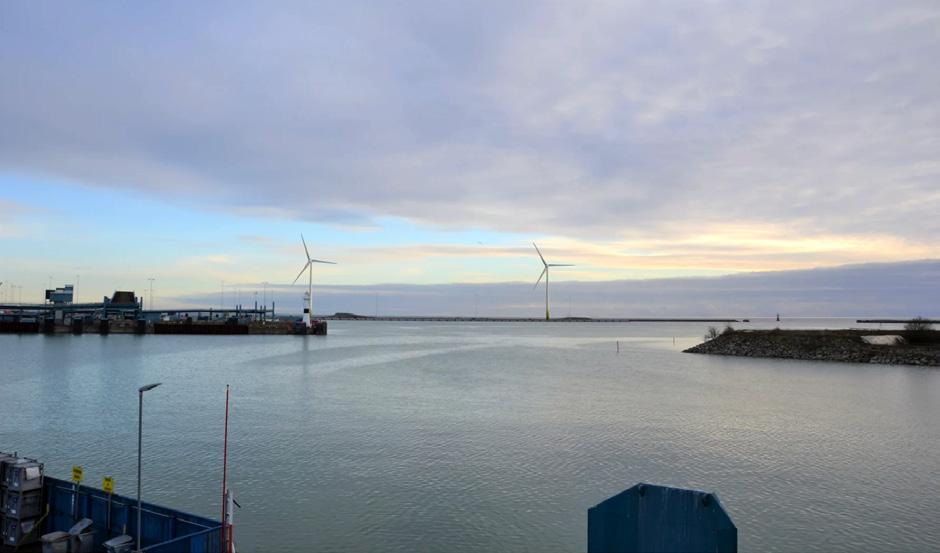
ensuring our energy independence through domestic production. Offshore wind farms are the best possible solution to achieve this goal,” Rene Tammist, Board Member of Utilitas Wind, underlined.
In March 2023, Van Oord picked Mukran Port as the base for transshipping transition pieces (some 50 units) for Iberdrola’s 476MW Baltic Eagle OWE farm (located 30 km off the island of Rügen and scheduled to come online by this year’s end). The transition pieces will come from the Spanish Avilés, while Baltic Eagle’s turbines will be provided by MHI Vestas Offshore Wind (the MVOW V174 model of 9.53MW capacity). EEW ’s mega-factory in Rostock will supply the monopiles. Van Oord’s heavy-lift vessel Svanen will take care of the installation, while the company’s Nexus and Dig-It will lay the cables (with 50Hertz installing the offshore substation).
In April 2023, news broke out that the Port of Gothenburg earmarked SEK15m (about €1.32m) for purchasing 5% of the Västvind OWE farm and further partially financing the project costs. The 1,000MW offshore wind farm, situated in the Kungälv and Öckerö municipalities, will produce 4-4.5TWh/year (or what the City of Gothenburg currently consumes). Eolus, the project developer, expects to commence construction in 2027, completing the works two years later. “The Port of Gothenburg is facing a green transformation that will entail a sharp increase in the port’s electricity needs already during the period up until 2030. The port’s forecasts for future electricity consumption show a multi-fold increase in the need for power. There is already a severe deficit in electricity generation in the region, and demand for electricity is expected to double by 2035,” the Gothenburg Port Authority (GPA) underscored in a press release. Elvir
Dzanic, back then GPA’s CEO, added, “The world’s major ports will become energy hubs and centers for the manufacture of hydrogen gas and e-fuel for maritime traffic. The Port of Gothenburg’s strategy is to lead the green transition of maritime traffic, but this position will not come about without some effort. Access to green electricity will be entirely crucial for the port’s development and competitiveness. Investing in electricity production is therefore a strategic decision for us.” Per Witalisson, CEO of Eolus, also highlighted, “Regional renewable electricity generation is an integral and necessary part of the green transition in both the transportation sector and industry in western Sweden. It is therefore both natural and strategically important that the Port of Gothenburg is part of Västvind.” He continued, “Västvind could play a key role in western Sweden’s ambitions of becoming northern Europe’s center for the electric vehicles and battery manufacture of the future, and the world’s most climate-smart port logistics. Access to green electricity is a decisive issue in this regard. In practice, offshore wind power is the only source of energy that can contribute such large amounts of new electricity generation in the timeframe up until 2035.” More about e-invetsments in and around Gothenburg (and other sites across Scandinavia, too) in the section on charging stations.
In mid-June 2023, the Offshore Wind Power & Ports in Ostrobothnia project was launched. The Regional Council of Ostrobothnia selected Ramboll to assess the opportunities and needs associated with developing OWE via Coastal Ostrobothnia. The project is divided into three parts. The first is tasked with mapping how Ostrobothnian ports (Kaskinen, Pietarsaari, Vaasa, Kasnäs, and Karhusaari) stack against other seaports in the Gulf of Bothnia and the wider Baltic
Sea as regards their preparedness for serving the construction of OWE farms. The second part is devoted to the division of labour and cooperation (also with Swedish harbours), as the investment scale of OWE off Finland’s coast is too big for a single port to handle the entire demand. Lastly, Ramboll will look into what opportunities may follow thanks to erecting OWE farms, such as hydrogen and e-fuel production. In the project announcement, the Council said that a record number of wind turbines was built in Finland in 2022, and wind energy production rose by 41%. The country was at that time peppered with nearly 1,400 turbines (though mostly on land). Among others, OX2, a developer and seller of renewable energy solutions (incl. wind), initiated the development (environmental impact assessment and other studies) of the 100-turbine-strong 1,400MW/6.0TWh/year OWE farm Tyrsky in the Gulf of Bothnia (about 30 km northwest of Kaskinen) at the beginning of 2023.
Alike Gothenburg, the Port of Trelleborg also wants to produce its own OWE. To that end, a building permit was granted in July 2023 for erecting two 120-m-tall wind turbines in the Swedish seaport, expected to start swirling this year. The pair will produce about 15m kWh/year. Together with the port’s 2.2k m 2 solar park, the turbines will deliver more green energy than it consumes. As such, electricity will also be used for the Municipality of Trelleborg’s hydrogen investment (H2X and Trelleborg Energi will deliver hydrogen buses and a waste truck for the Swedish local authority). “Together with Trelleborgs Energi, we are now working to find the best design and how to ensure green hydrogen for the upcoming truck traffic powered by hydrogen in the future,” said Jörgen Nilsson, the Port of Trelleborg’s CEO. The wind turbines are one of the activities in the port’s EU Green FIT 2025 project, co-financed by the EU. The Port of Trelleborg intends to reach net zero emissions by 2040.
In October 2023, the Spanish Windar Renovables and the Port of SzczecinŚwinoujście signed a preliminary land concession agreement towards establishing an offshore wind energy tower production centre in the Port of Szczecin. The deal was later signed & sealed in January 2024. The factory and its storage area will occupy 17 ha and the towers produced by Windar Renovables in Szczecin will be designed to support the new generation turbines with 20MW of installed capacity.
Just before the end of November 2023, the Port of Halland , OX2 , and Ingka Investments signed a two-year agreement,

REPORT 56 | Baltic Transport Journal | 1/2024
Photo: Port of Trelleborg
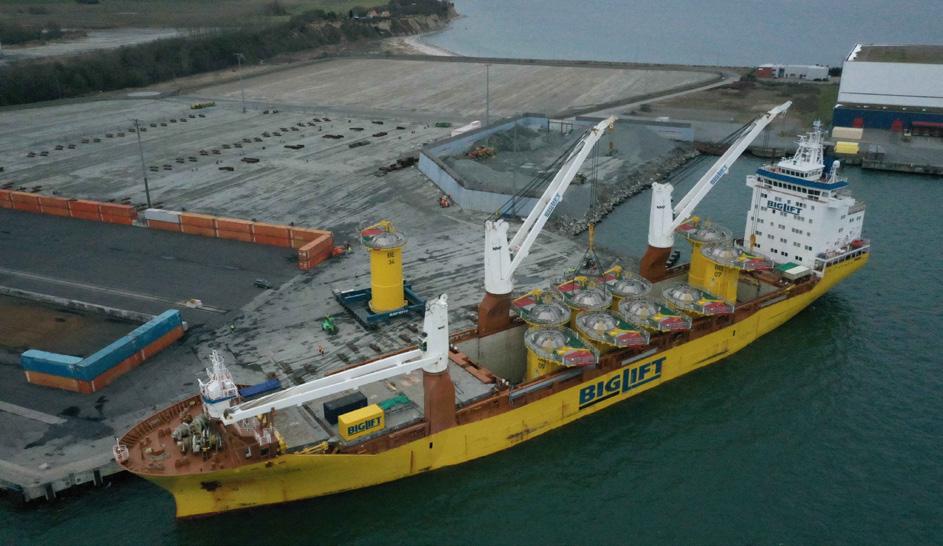
following which they will scrutinise the conditions under which the Port of Varberg can function as a supply harbour for the Galene OWE farm. OX2 will set up an office and a warehouse in the Swedish seaport with quay access to serve the 400MW installation (21 wind turbines some 20 km off Halland’s coast). “We are very optimistic about the agreement with OX2, which will create conditions for a long-lasting partnership that will contribute to electricity supply security and Halland’s green transition. We will also get the opportunity to strengthen the operations in Varberg with yet another segment in addition to being Sweden’s leading forest harbour,” commented Henrik Nanfeldt, COO at the Port of Halland (the joint authority of the seaports in Halmstad and Varberg). Emelie Zakrisson, Head of Offshore Wind Development Sweden with OX2, added, “We are looking forward to contributing to the development of the Port of Varberg by establishing an office, warehouse, and operations. The port will play a central role in building and then operating Galene, which will produce a significant amount of cost-effective and renewable electricity in the region.”
Nearing the end of last year, Suomen Hyötytuuli obtained the building and water permits for adding new turbines to the 42MW Tahkoluoto OWE farm off the coast of Pori. The so-called demonstration project, supported by NextGenerationEU funding, will see the addition of two at least 15MW strong turbines (the current ones, 11, have a capacity of 2.3-4.2MW). The project aims to demonstrate the construction of new-scale offshore wind turbines, likewise testing foundations capable of withstanding harsh sea conditions (Tahkoluoto is the world’s first OWE farm erected in freezing waters). The entire expansion project assumes placing 40 new turbines, thus increasing the farm’s capacity by 600800MW by 2027-2029. “These are the first permits granted to offshore wind turbines of this size in Finland. When applying for permits for Suomen Hyötytuuli, it was important to ensure that the plans comprehensively took into account the understanding of the marine nature of the area and became more detailed during the environmental impact assessment and zoning. Of course, it is also important to monitor the environmental impact during construction
Wind #2 – propulsion
Here last year got off to a nippy start with the announcement that Horizon Europe granted €9.0m to the 11 project partners behind Orcelle Wind, the pure car & truck carrier (PCTC) to use wind as the main form of propulsion (hence the title of this section omits ‘auxiliary’ before ‘propulsion’ in contrast to the Baltic transport highlights from the previous years). Over the next five years, all aspects of planning, building, and operating the wind-powered vessel will be carried out. Wallenius Wilhelmsen, who
will operate Orcelle Wind, expects to start commercial sailings in late 2026/early 2027. The 220 m long PCTC will offer 7,000+ vehicle capacity (she will also be able to transport other rolling cargo, likewise break-bulk). As part of the Horizon Europe funding, the project will also see the installation of a wing sail test rig on an existing Wallenius Wilhelmsen vessel in mid-2024 (more about that later). “The Horizon Europe EU funding shows the concept stood up to the scrutiny of the EU funding authorities and that they
and in the early stages of production,” said Juho Lappalainen, Project Development Manager responsible for the Tahkoluoto OWE farm expansion.
Meanwhile, the City of Pori – together with the Port of Pori, the city-owned company Suisto Kiinteistöt, as well as Suomen Hyötytuuli, Enersense, and the Dutch logistics service provider Olmar – are working on setting up an international hub for expertise and operations based on offshore wind power. The competence hub will be located on a 50-hectare plot in the Port of Pori’s Mäntyluoto Harbour. In the initial phase, the area will be used for pre-installation services, assembly, and storage of offshore wind turbines. “There are several significant offshore wind power investments planned for the Gulf of Bothnia. Our goal is to build a competence hub that serves wind power projects in the region, both in Finland and Sweden. We already have one offshore wind park in operation, giving us a head start compared to competitors. We aim to develop Pori as a pioneer in clean energy solutions,” highlighted Lauri Kilkku, Head of Administration at the City of Pori. According to the Confederation of Finnish Industries, the total value of planned offshore wind power investments in Finland exceeds €42b. Within a radius of 400 km from Pori, 15 larger wind power projects have been announced. Seppo Ihalainen, heading Suisto Kiinteistöt, also underscored, “The principles in green transition projects are similar to those in developing digital infrastructure. Expertise is crucial, and it is necessary to build strong ecosystems. Wind power expertise and port development provide a solid foundation for industrial investments related to solar power and green hydrogen production.” Enersense is already constructing technically demanding foundations for offshore wind turbines in Mäntyluoto. Suomen Hyötytuuli and the Port of Pori have agreed to build a gravel loading dock at the Tahkoluoto Harbour to serve the construction of wind turbine foundations.
had the confidence to give it their support,” Roger Strevens, VP Global Sustainability at Wallenius Wilhelmsen, underlined. He furthered, “The EU Funding project is based on a collaborative approach – we need strong partners to lead the way to zero emission as soon as possible. We are proud to have a group of the best technical, operational, and academic partners, as well as one of our key customers, for the project. All have committed to working together to help make Orcelle Wind a reality.” His company also

REPORT 1/2024 | Baltic Transport Journal | 57
Photo: Mukran Port
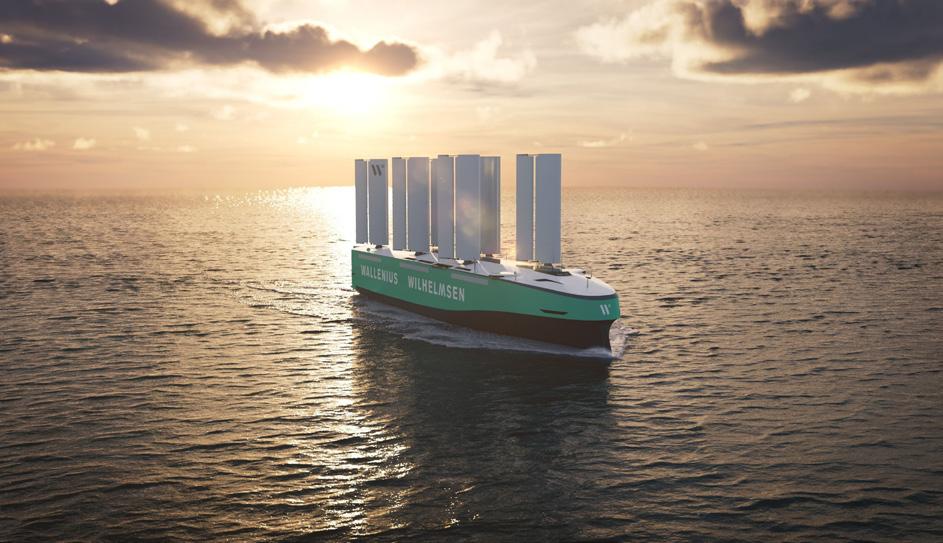

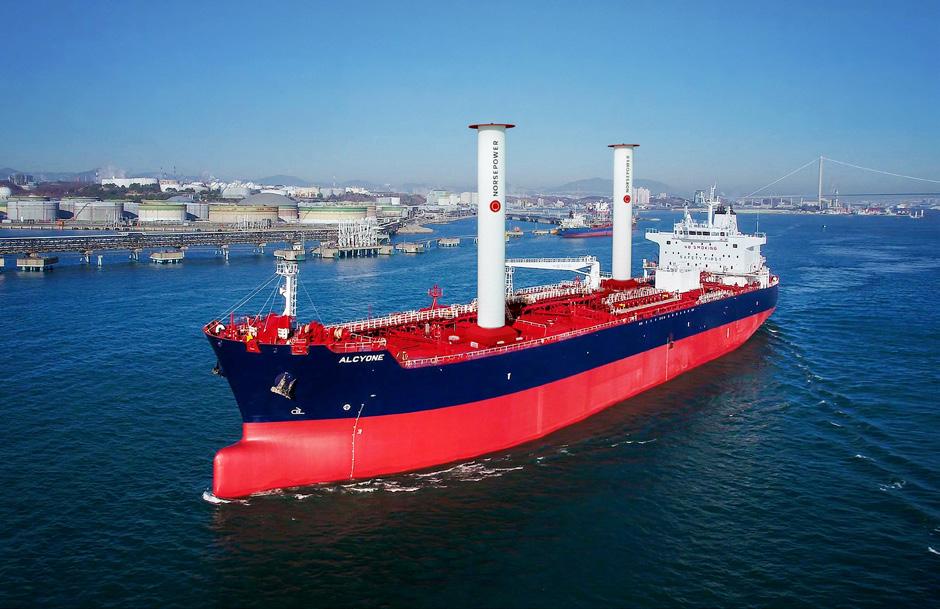
highlighted in a press release, “The EU project is a solid opportunity to combine the investments needed for full-scale demonstration and data capture with advanced models and tools for wing propulsion
vessels. Beyond the demonstrator vessel, the partners will use the models and tools to develop advanced conceptual designs and operational plans for multiple vessel types to apply the wing solution.”
Naturally, the wind propulsion section just couldn’t go without Norsepower (whose prototype of the modern Flettner rotor I had the opportunity to see with my very own eyes upon visiting the Port of Naantali in September 2023). First, in January 2023, the French shipowner and operator Socatra ordered the retrofitting of its medium-range (MR) tanker Alcyone with Norsepower’s two 35 m tall and 5.0 m in diameter Flettner rotors. The 50k dwt, 2022-built ship, charter-working for TotalEnergies, will receive Norsepower’s Rotor Sails in Q4 2023/Q1 2024 (the sails were provided by the manufacturer’s new production hub in China in December last year). According to calculations, the Rotor Sails will lower Alcyone’s fuel consumption by an average of 8% on her crossing from South Korea to French Polynesia, “[…] with the potential for further savings using voyage optimisation reaching up to 2,000 tonnes of CO2 per annum,” said Norsepower in a press brief. “As the oil industry is moving towards a low-carbon future, it is everyone’s responsibility to put forward tangible and economically viable solutions. We are pleased to be working with Norsepower to accelerate this transition and minimise our environmental footprint. The Norsepower Rotor Sail is widely recognised as a proven solution for sea-going vessels, and we believe that our MR tanker Alcyone will benefit from significant efficiency gains and help us reduce our CO2 emissions,” Laurent Bozzoni, Socatra’s CEO, said. Jérome Cousin, SVP Shipping at TotalEnergies, added, “The installation of two Norsepower Rotor Sails on Alcyone contributes to TotalEnergies’ Net Zero ambition by providing an immediate reduction of the carbon footprint of our shipping activities. We reaffirm our commitment to promoting innovative solutions for more sustainable shipping and actively support the deployment of the most promising technologies. The success of this project could pave the way for a broader adoption of wind-assisted propulsion for TotalEnergies’ fleet.” Another Finland-based company, Deltamarin, has been contracted to provide Socatra with a conversion basic design package for installing the two rotors. Kristian Knaapi, Sales Manager at Deltamarin, said in this regard, “We are delighted to execute this project together with Socatra and Norsepower, and we look forward to seeing the vessel with installed sails in operation early next year [i.e., 2024]. Wind is definitely a good technology for decarbonisation in both segments, in existing ships and newbuilds.”
Second, in March 2023, Norsepower scored another order, this time for two sails for one of MOL’s 200k dwt dry bulkers.

REPORT 58 | Baltic Transport Journal | 1/2024
Photo: Wallenius Wilhelmsen
Photo: Oceanbird
Photo: Norsepower
The 35 m tall and 5.0 m in diameter Rotor Sails will be mounted in H1 2024 and are expected to lower the vessel’s fuel consumption by 6-10% (when combined with voyage optimisation technology). The installation results from MOL co-op with Vale, for whom the ship carries iron ore under a mid-term contract. Third, later the year in July, the Finnish manufacturer of auxiliary wind-assisted propulsion was commissioned by the Japanese Iino Lines and J-Power to furnish Yodohime with a 24 m tall and 4.0 m in diameter sail. The installation will take place in Q3 2024. It will be Iino Lines’ second Norsepower Rotor Sail, following an installation on board a very large gas carrier (and J-Power’s second wind propulsion auxiliary system for a coal carrier).
As the promised throwback to Orcelle Wind , the Oceanbird Wing 560 received
In 2023, other energy carriers dominated the Baltic news feed, leaving the LNG market with but two major developments. In January, the floating storage regasification unit (FSRU) Exemplar got connected to the Finnish grid in the Port of Inkoo, ready to receive gas for distribution in Finland and the Baltics (more on the latter in a second).
The 291 m long, 150.9k m3 capacity (68kt of LNG when fully laden, translating to some 1,050GWh) Exemplar has been chartered for ten years from the Texan Excelerate Energy.
The floating terminal has an annual regasification capacity of 40TWh, which according to Gasgrid exceeds the country’s yearly demand (25.1TWh in 2021 per the company’s data). The FSRU, operated by Gasgrid
the Approval in Principle (AiP) from DNV in summer of 2023. The class confirmed that the rigid, tiltable sail designed by the JV of Alfa Laval and Wallenius Marine encountered no showstoppers and can be further developed toward Type Approval and prototype assembly. Oceanbird Wing 560 is 40 m tall and 14 m wide, offering 560 m 2 sail area. It consists of a main sail and a flap, optimising the aerodynamic forces by creating a camber. According to its developers, one wing sail on an existing ro-ro can, at normal speed, reduce fuel consumption from the main engine by 7-10% on favourable oceangoing routes, saving approximately 675k/year litres of diesel, which corresponds to about 1,920t/y of CO2 . “It is one of the first stiff wing sails that will tilt in hard winds as a safety feature that gets an Approval in Principle.
Liquefied natural gas (LNG)
Finland ’s subsidiary Gasgrid Floating LNG Terminal Finland , is connected to the bi-directional Balticconnector pipeline, the other end of which is in the Estonian Paldiski . The 1 January 2020-launched pipe (providing Finland with around onethird of its gas demand) became nonoperational on 8 October 2023 when the operators detected a sudden and significant drop in pressure (from 34.5 to 6.0 bars), forcing them to shut off the flow. The damage was in all probability caused by the anchor of the Chinese container ship Newnew Polar Bear Consequently, Finland has had to turn to its LNG import terminals (Hamina , Inkoo, Pori, and Tornio) to make for the lost pipeline capacity (which could get back online
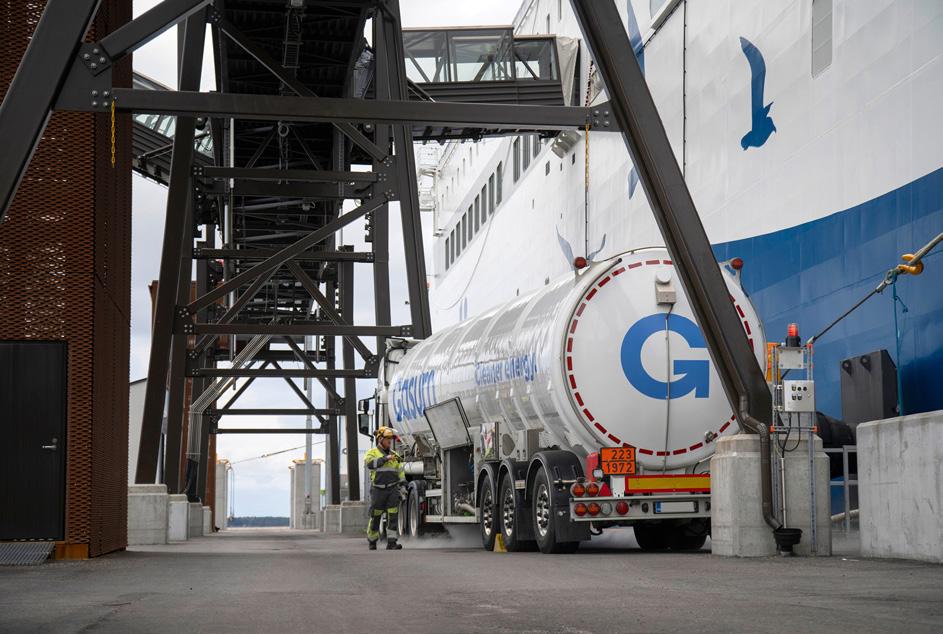
Therefore, it is reassuring that DNV supports our safety philosophy since we are now going from vision into realisation. In just a few months, we will begin to assemble our first full-scale wing prototypes, which will be on board a [Wallenius Wilhelmsen] vessel in about one year from now,” underlined Niclas Dahl, Managing Director, Oceanbird . “We’re pleased to award Oceanbird the AiP for their windassisted propulsion system […]. Such systems hold promise in enhancing the efficiency of maritime operations, and partnerships like this play a significant role in moving the industry towards decarbonisation. With our extensive knowledge in this domain, DNV is eager to collaborate and foster the advancement of these innovations,” said Hasso Hoffmeister, Senior Principal Engineer at DNV.
in April this year at the earliest). As such, Gasum has been feeding Exemplar since October 2023, also with its Coral Energy bunker vessel following the FSRU upgrade to receive LNG from smaller vessels (but that was an event from early 2024; in total, by 10 January this year, Gasum delivered four large batches of LNG to Exemplar since Balticconnector went out of order). Upon welcoming Exemplar, Gasgrid underlined that no Russian gas will be handled at the Inkoo terminal; moreover, the investment would help Finland to permanently phase out its dependency on Russian gas. An eye-catching move was put in motion by the Finnish-Swedish Wasaline in early autumn of 2023. The company connecting the ports of Umeå and Vaasa (the two Kvarken Ports) started sailing its gas-run Aurora Botnia ferry on bioLNG each Friday from 13 October 2023 (ending the so-called Green Fridays around Christmas). With certified climate-neutral bioLNG from Gasum, Wasaline said it intends to reduce its carbon footprint further: the company shared in an October press release that its 2023 emissions were already 22% lower than last year. Moreover, Wasaline covered the price spread between bioLNG and the standard version of LNG. “Aurora Botnia is the world’s most environmentally friendly ferry today, but our efforts to reduce our climate footprint continue,” underscored Peter Ståhlberg , Managing Director at Wasaline. He went on, “This is a pilot project to measure the interest of our cargo owners and passengers, and whether it is financially viable to continue biogas purchases. We would like to thank our loyal

REPORT 1/2024 | Baltic Transport Journal | 59
Photo: Wasaline

customers who have made this unique investment in climate-neutral transport possible for the first time in the Kvarken.” Jacob Granqvist , VP Maritime at Gasum, commented, “This is a great initiative that we at Gasum are very happy to be a part of in our role as a biogas supplier. Biogas is one of the already available concrete pathways to reducing emissions in maritime
Also in January 2023, Liquid Wind shared the company conducted a feasibility study (together with Umeå Energi) on setting up a marine e-fuel production site at the Dåva cogeneration plant up in the Swedish far north. According to the study, there are “excellent conditions” for establishing Sweden’s third electrofuel facility for the maritime sector in Umeå . All documents required for an investment decision are planned to be ready this year, with an expected production of 100kt/ year starting in 2026. The plant will see some 230kt/year of CO2 captured. “We are looking forward to our partnership with Umeå Energi and their future-oriented vision which results in the possibility to jointly establish the first electrofuel facility in Region Västerbotten. The Dåva facility will follow the Örnsköldsvik [50kt/y/ online in 2025] and Sundsvall [100kt/y/possibly end 2025-beginning 2026] facilities already being developed in Västernorrland. The transition to electrofuels in the maritime sector which uses 300 million tonnes of fossil fuels every year is very urgent. With
transport and travel, and it’s fantastic that Wasaline is now setting on this pathway to provide lower emissions services to its customers. Our goal is to continuously increase biogas availability to our customers in the coming years.” Ida Saavalainen, CEO at Ahola Group, one of Finland’s prime road hauliers, also underlined, “Sustainability and holistic environmental-effective
Future fuels
electrofuel replacing today’s fossil fuels, carbon dioxide emissions can be reduced by over 90%,” Claes Fredriksson, Liquid Wind’s Founder & CEO, said. Jan Ridfeldt, CEO of Umeå Energi, underlined the synergies and wider benefits behind such investments, “As an energy company we play an important role in reducing both society’s climate footprint and the footprint from our operations. Capturing the carbon dioxide from the Dåva cogeneration plant will allow us to take yet another step towards circularity. Umeå Municipality has pledged that the City of Umeå will be climate neutral by 2030, and the municipality itself by 2040. The establishment of an electrofuel production plant at Dåva could be an important step in that direction.”
In May 2023, the Danish energy company Ørsted began constructing FlagshipONE , the abovementioned plant in Örnsköldsvik (sited on the grounds of the biomass-fired combined heat & power plant Hörneborgsverket, operated by Övik Energi). Siemens Energy, Carbon Clean, and Topsoe also broke the ground:
solutions are a central part of our operations where we work actively to reduce our footprint. Our methods include realtime optimization of routes, high filling degree, energy-efficient driving, and the use of alternative fuels with lower emissions. We are pleased to reduce emissions even further with the help of biogaspowered ferry connections by Wasaline.”
the companies will deliver the electrolysers and control system, the carbon capture equipment, and the methanol synthesis gear, respectively. The e-methanol from FlagshipONE will be produced using renewable electricity and biogenic CO2 captured from Hörneborgsverket. In addition, FlagshipONE will use steam, process water, and cooling water from Hörneborgsverket, and excess heat from the e-methanol production process will be delivered back to Övik Energi and integrated into their district heating supply. The Swedish Environmental Protection Agency supported FlagshipONE with SEK151m (about €13.1m) through its Climate Leap initiative. “The event in Örnsköldsvik focused on the need to decarbonise global maritime transport and on the large potential for Sweden to become a key market for the production of e-methanol, which is emerging as shipping’s preferred route to zero emissions in the 2020s. Sweden has ample opportunity to develop renewable energy, like onshore and offshore wind, and has a world-leading forest industry to supply the

REPORT 60 | Baltic Transport Journal | 1/2024
Photo: Excelerate Energy
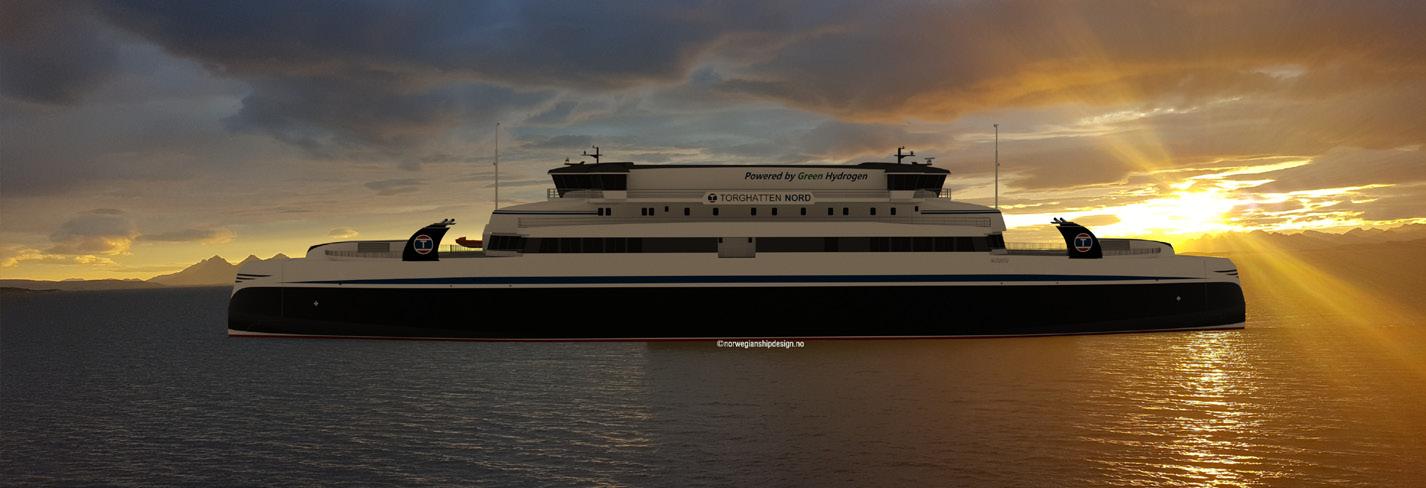
biogenic carbon needed to produce e-methanol. Örnsköldsvik is one of the centres of the Swedish forest industry, having a large commercial presence from advanced forestbased industries,” Ørsted highlighted in a press release. According to the company, over 110 e-methanol vessels are on order or already operational, up from 80 at the end of 2022. Anders Nordstrøm, COO of Ørsted P2X, said, “FlagshipONE is a pioneering project that will open a new era for green shipping and for Ørsted. I’m very pleased that we’ve now started on-site construction together with other green fuel leaders from across the supply chain, and together with representatives from Örnsköldsvik, Västernorrlands Län and Sweden at large. FlagshipONE will be the first project in a new green industry in Sweden, which Ørsted intends to spearhead.” His company also develops the 300kt/year Project Star in the US Gulf Coast and the Green Fuels for Denmark e-methanol projects. Claes Fredriksson, Founder & CEO of Liquid Wind (the enterprise that originally developed FlagshipONE), also commented, “FlagshipONE will soon become the largest commercial-scale electrofuel facility in Europe and at Liquid Wind we are thrilled that Ørsted is now starting the construction phase of the project. FlagshipONE is our first sold project and is just the beginning of our journey to become the leading developer of electrofuel facilities. This milestone will hopefully inspire many others to also contribute to the decarbonisation of shipping. Today is a historical day for Sweden as we put the country on the map as a developer and producer of green electrofuel. All with the intent of reducing the world’s dependence on fossil fuels.”
Fredriksson put his money where his mouth was in mid-November 2023, when Liquid Wind , Alfa Laval, Carbon Clean, Siemens Energy, and Topsoe strengthened
their co-op to design ready-to-build core e-methanol plants (CMP). The partners said they would focus on reducing the time, cost, and risk of developing CMPs to get ten additional e-methanol facilities in the Nordics by 2027 and a total of 80 standardised, 100kt/year capacity e-methanol units by 2030 (estimated to yearly reduce CO2 emissions by 14mt). The projects target the shipping business as the primary client for their (fuel) product. Sundus Cordelia Ramli, Chief Commercial Officer P-to-X at Topsoe, used the occasion to urge, “At Topsoe, we’re thrilled to collaborate with other decarbonisation leaders on this project, driving a faster transition towards a sustainable shipping industry. The sharp rise of CO2 emissions within the maritime sector (to 5% in 2022) is a stark reminder of the urgency of our collective mission. Inspired by Liquid Wind’s visionary approach and united by the pioneering spirit of the project’s leaders, we stand poised to demonstrate that, when harnessed, the technology available today can propel a swift transition to a more sustainable maritime future. The time for change is now. This endeavour exemplifies the accelerated progress possible through industry-wide collaboration, and we’re deeply honoured to be at the forefront of this pivotal transformation.”
On the intersection between LNG and future fuels came January 2023 news that a new bioLNG plant will be up and running in Sweden by Q4 2024. Scandinavian Biogas’ SEK760m investment (around €68m) will have a production capacity of 120GWh, catering to the transport sector (maritime & heavy overland). The facility will be erected by the Portuguese Efacec and the Swedish Multibygg in Mönsterås in southeastern Sweden. The Swedish arm of Wärtsilä will provide the gas upgrade and liquefaction technology. Local farmers initiated the manure-fed biogas project
in Mönsterås in 2016, with Scandinavian Biogas getting involved in 2021. The parties formed a jointly-owned company responsible for designing, building, and managing the planned biogas plant. The Swedish Environmental Protection Agency ’s Climate Leap granted the project SEK154m (€13.8m) in economic support in 2021. “We have worked for many years to find a sustainable solution for our operations as the production of manure has become a limitation for us. The collaboration with Scandinavian Biogas brings us a solution that will manage the normal methane emissions, while simultaneously lowering the carbon dioxide emissions in the transport sector. There will be considerable environmental benefits from the local production of food, when taking the whole cycle into consideration,” Olof Boson , farmer and Board Chairman of Mönsterås Biogas , said. Matti Vikkula , CEO of Scandinavian Biogas, also underscored, “The biogas project in Mönsterås will be the first in line of the projects that we will develop in collaboration with local farmers. We believe that local ownership is important, to make sure that parts of the future revenues also remain local. The benefits of liquefied biogas with manure as feedstock are obvious, and enable a green transition for locally produced food products as well as for heavy transports. This is another important step for us at Scandinavian Biogas towards our longterm vision of a total production capacity of 3.0TWh by the year 2030.” Michael Wallis Olausson, Chief Growth Officer at Scandinavian Biogas, summed up, “It feels good to finally have everything in order and that we have received green light to start the project. The farmers need this biogas plant in order to be able to further develop their operations and our customers in Europe are in great need of fossile-free gas.”

REPORT 1/2024 | Baltic Transport Journal | 61
Photo: The Norwegian Ship Design Company
In February 2023, the Långnäs Mega Green Port project was announced. OX2 and Ålandsbanken Fondbolag, the Bank of Åland ’s fund management subsidiary, teamed up to conduct a 12-month-long feasibility study on setting up a green hydrogen production facility on the Åland Islands. The parties – supported by Mærsk Mc-Kinney Møller Center for Zero Carbon Shipping, EuroMekanik, and several other consultancies – will look into the practical, technical, and financial conditions for setting up the 3,000MW electrolyser facility. The inquiry will also see what business opportunities the investment will open: directly on the Åland Islands and beyond, as OX2 develops various projects in the north-to-south Baltic, including offshore wind energy farms (between Finland and Sweden), energy storage sites (in Poland), or a hydrogen pipeline (from the Nordics to southern Baltic, with potential branch pipes to Bornholm or Gotland). Apart from providing clean marine fuel, the facility could also cater to the needs of the agricultural and manufacturing industries. OX2 and Ålandsbanken Fondbolag are already working together: on the Noatum South and Noatum North offshore wind energy farms (3,000MW and 5,000MW capacity, respectively). OX2 has also initiated the development of the (already mentioned in the Wind #1 section) 1,400MW OWE farm Tyrsky. “Creating a Mega Green Port will bolster the Åland economy in many different ways. In addition to being an important part of the offshore wind power projects, it will generate jobs and produce e-fuel for the shipping industry – making Åland attractive for the establishment of large new businesses and enabling many new innovative projects in oxygenation of water and utilisation of excess heat in various manufacturing activities. The port will strengthen Åland’s potential to become the leading green hub in the Nordic region,”

Anders Wiklund, OX2’s Country Manager Åland, said. Peter Wiklöf, Manager Director and Chief Executive of the Bank of Åland, commented, “The purpose of our planned wind power projects is green energy transition and enabling the general public to participate via our fund structure – but perhaps, above all, to create a new growth engine for the Åland business sector. The feasibility study for Långnäs as a Mega Green Port is an important step in understanding how Långnäs can play a key role in the future of the Åland business community, especially with reference to the growth of existing Åland companies and the establishment of new business operations.” Johan Byskov Svendsen, Programme Manager at the Mærsk Mc-Kinney Møller Center for Zero Carbon Shipping, highlighted, “We are very much looking forward to being involved in this feasibility study, the vision for Åland and the role that Långnäs can play for shipping. The global shipping industry is clamouring
for green e-fuel on a large scale, which makes the timing of this feasibility study perfect. It needs to get started as soon as possible.”
There are voices in the industry, with the Brussels-based NGO Transport & Environment probably being the most vocal here, that European and international regulations aimed at curbing shipping’s carbon footprint take much of the industry sailing with smaller vessels out of the green transition equation. But here, too, the Baltic works on solutions that move faster than the regulatory framework. In February 2023, ScandiNAOS, the Chalmers University of Technology, and the Swedish Maritime Administration (SMA) launched a project to develop dual-fuel kits for converting new and existing diesel engines (up to 1,000kW) to methanol operation. The two-year-long project will see ScandiNAOS develop and implement a dual-fuel kit in a pilot boat owned and operated by SMA (the organisation, which intends to remove


REPORT 62 | Baltic Transport Journal | 1/2024
Photo: Maersk
Photo: Scandinavian Biogas
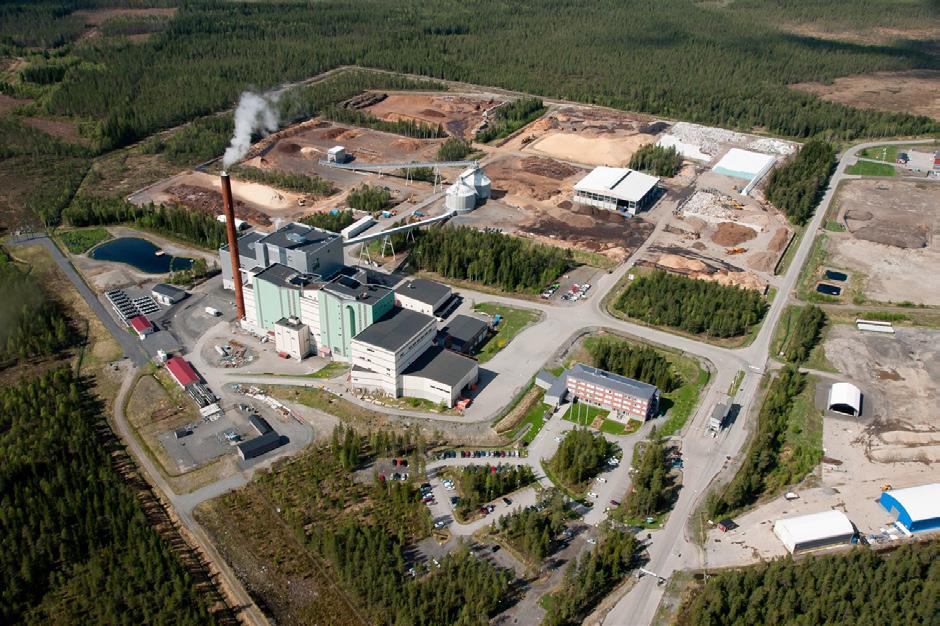
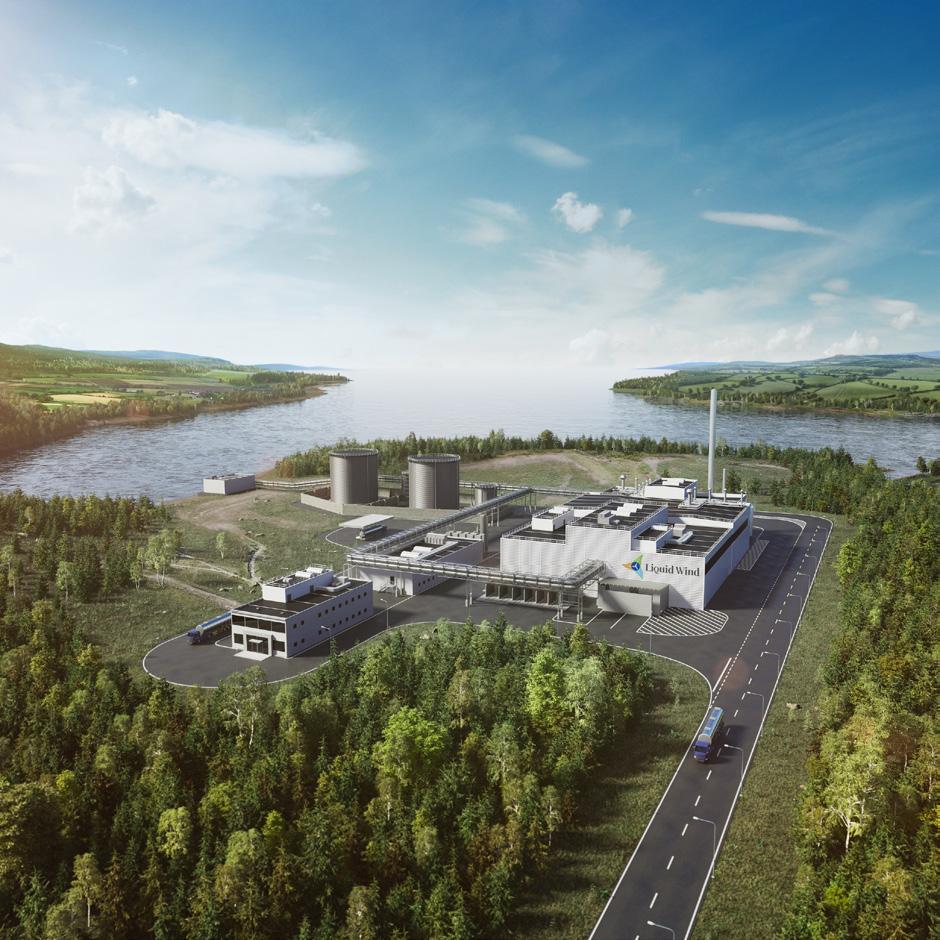
fossil fuels from its fleet by 2045, already operates a methanol-powered pilot boat equipped with a single-fuel compression ignited methanol engine which completed successful trials in December 2021, a conversion supported by the FASTWATER consortium). The pilot boat was expected to be ready for field trials in Q3 2023, a process which would go on for 9-12 months, during
which the dual-fuel kit would be tuned and optimised based on operational experience and from the results of the research and laboratory tests carried out by Chalmers. “The adoption of dual-fuel kits will enable conversion of more ships and boats more quickly, since a conversion kit can be costefficiently applied to existing engines while maintaining the fuel flexibility to run on
either methanol, MGO [marine gas oil] or HVO [hydrogenated vegetable oil],” the parties said in a press brief. The project has a budget of SEK8.6m (around €1.8m), half of which comes from the Swedish Strategic Vehicle Research and Innovation programme. The methanol producer Proman and the Methanol Institute provide industry funding. Albert Hagander, Technical Manager with SMA, commented, “The SMA is glad to be a part of the project that may open a new door towards fossil-free operation.” Dr Lucien Koopmans , Professor, Head of the Division of Energy Conversion and Propulsion Systems at the Chalmers University of Technology, added, “A quick and powerful transition towards a decarbonised transport future starts with the conversion of the existing fleet.”
Staying in Sweden, in March last year, PowerCell shared it’ll deliver the world’s largest marine (green) hydrogen fuel cells. The Swedish company’s 6.0MW H 2 fuel cells will be fitted on two of Torghatten Nord ’s ferries, saving the environment 26.5kt CO2 emissions annually. The €19.2m order, won in a tender, will see PowerCell working with SEAM, a Norwegian systems developer and integrator of low- and zeroemission solutions for the marine industry (responsible for the electrical installations on the ferries). The final delivery is to take place in Q4 2024. Torghatten Nord and PowerCell also intend to enter into a longterm service agreement. “[The] announcement comes as part of a Norwegian government initiative that aims to see all ferries crossing the Vestfjorden between Lofoten and Bodø in Northern Norway be emission-free. With a long and demanding crossing of up to four hours, green hydrogen was deemed the most viable solution to supply the power these vessels require. The ferries – each with a capacity of 599 passengers and 120 cars – are scheduled to operate from October 2025 as part of a replacement programme for similar sized and operable fossil energy-powered ferries,” PowerCell said in a press release. Richard Berkling , the company’s CEO, added, “This is a groundbreaking project not just for PowerCell or Norway, but for the entire marine industry, and one that we are very happy and proud to be part of. Norway led the development in the introduction of liquefied natural gas in the marine industry and now the country is taking an important step to establish green hydrogen as a clean energy source for our hard to abate sector. Our solutions are perfectly suited for demanding applications where operational reliability, high power

REPORT 1/2024 | Baltic Transport Journal | 63
Photo: Johan Gunséus/Liquid Wind
Photo: Liquid Wind
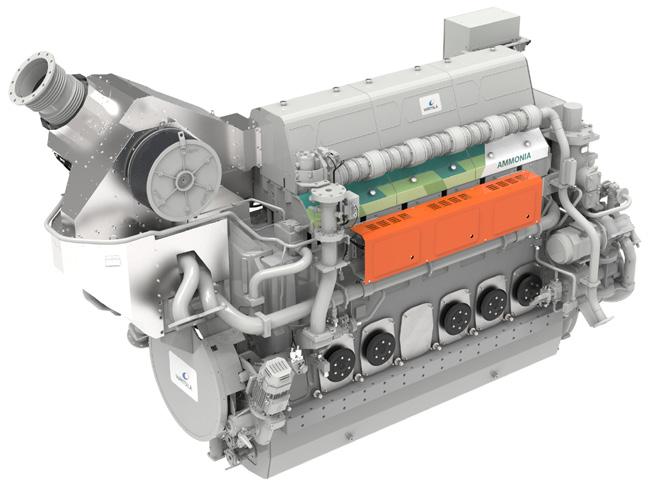
density and compact format are important parameters.” He furthered, “[…] In Norway alone, there are roughly 800 ferry lines and ferries are a segment where we can expect great interest in hydrogen-electric solutions. Starting next year [i.e., 2024], the maritime sector will be included in the EU Emissions Trading System, which will increase the demand for net zero, hydrogen-powered solutions.”
Still in Scandinavia, but this time in Denmark, the Port of Aalborg’s East Port got a new tenant in August 2023: a new 3,000 m 2 future green fuel acceleration test facility of Aalborg University (with space for potentially adding four more test facilities). “The project will be the backbone of our future development projects that are crucial for realizing large-scale production of, for example, hydrogen and e-methanol. With the Port of Aalborg, we will have the optimal conditions for developing our research and technologies in practice, in order to scale up production in the future. At the same time, we also make it possible for commercial players to test the facilities in order for us to realize the enormous potential of CCUS [carbon capture, utilisation, and storage], which will be crucial for achieving national and international climate goals in the coming years,” explained Lasse Rosendahl, Head of Department and Professor at AAU Energy at Aalborg University (on that note, Fidelis New Energy and the Port of Aalborg have announced the construction of up to 4.0mt/ year CO2-receiving facility, up and running from 2026). Kristian Thulesen Dahl, the Port of Aalborg’s CEO, added, “We are very pleased to facilitate the space for the facility as well as our collaboration with Aalborg University and its world-leading research environments within CCU and P2X [powerto-X]. A project like this fits well in the area, where we already have a strong cluster of companies working with the technologies
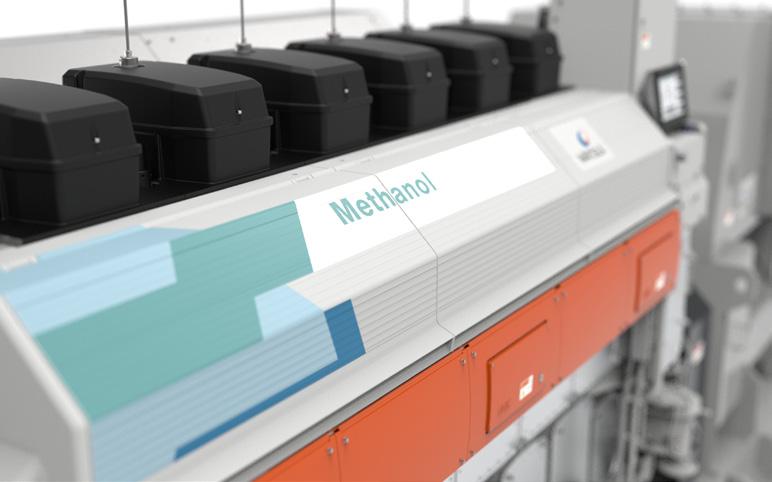
in different ways.” Lasse Frimand Jensen, the Port of Aalborg’s Board Chairman, also commented, “By collaborating with AAU on the test facility, we look forward to also work with actors from CO2Vision [a consortium gathering diverse parties from Denmark] and across the value chain to help translate the university’s world-class research into a tangible product, which both contribute to the green transition as well as growth and new jobs in the area.” Worth bringing up is that in 2022 the Port of Aalborg and European Energy signed a letter of intent to establish a P2X plant with an e-methanol-producing capacity of up to 75kt/year.
Just at the start of summer 2023, Stena Line contracted Wärtsilä to convert an undisclosed number of its ferries to use methanol as fuel. The conversions – scheduled to take place in 2025 – will include the fuel supply system and engine modifications, as well as integrating the new installations with the ships’ existing systems. The full scope of Wärtsilä’s supply package will include fuel tank instrumentation and valves, transfer pumps, low-pressure pump skid, fuel valve trains, methanol fuel pump units and the automation of the system, engine conversions, and automation upgrade for the engine control room. “Converting ferries for methanol fuel will enable them to be compliant with various existing and upcoming regulations, including the Carbon Intensity Indicator (CII), FuelEU Maritime, and the IMO 2050 GHG reduction target,” Wärtsilä highlighted in a press release. “As we continue to implement our strategy to decarbonise all our operations, we see methanol as a viable alternative fuel that will help us achieve this ambition. Wärtsilä has proven its capabilities to carry out the necessary conversions. This was shown eight years ago when they converted Stena Germanica to operate with methanol, and our experience from this
ground-breaking innovation has been very positive,” commented Ian Hampton, Stena Line’s Chief Operating Officer Fleet and Government Affairs. Roger Holm, President of Wärtsilä’s Marine Power business, said, “We have had close cooperation with Stena Line for many years and we are pleased to be supporting them again in this important conversion project. Like Stena Line, Wärtsilä is committed to making decarbonised shipping operations a reality, and we have invested heavily in developing our engine portfolio to be capable of utilising carbon-neutral and zero-carbon fuels.”
As such, in November 2023, Wärtsilä introduced the marine sector’s first commercially available 4-stroke engine-based solution for ammonia fuel. In addition to the engine, the full solution includes the company’s AmmoniaPac fuel gas supply system, the Wärtsilä Ammonia Release Mitigation System (WARMS), and the Wärtsilä NO x Reducer (NOR). According to the manufacturer, Wärtsilä 25 ammonia can reduce greenhouse gas emissions by more than 70% compared to a similar sized diesel solution. Stefan Nysjö, Vice President of Power Supply, Wärtsilä Marine Power, claimed, “This is only the beginning. The Wärtsilä 25 is the first Wärtsilä engine to run on ammonia as a fuel, and this is an important milestone, but we do not stop here. While we are planning for additional ammonia engines in our portfolio over time, we are also committed to continue development and testing of technologies and solutions that can continue to support the industry with reducing greenhouse gas emissions even further in the future.”
Earlier the same month, a letter of intent for the Wärtsilä 25 ammonia engine solution was signed between Wärtsilä and Viridis Bulk Carriers (a JV between Amon Maritime , Mosvolds Rederi and Navigare Logistics). The signing of a commercial

REPORT 64 | Baltic Transport Journal | 1/2024
Photos: Wärtsilä
contract is expected in early 2024, making the shipowner the first to use Wärtsilä’s ammonia engines (Viridis Bulk Carriers intends to become the world’s first zeroemission shipping company, offering to that end carbon-free transportation with a series of ammonia-powered newbuilds). André Risholm , Viridis Bulk Carriers’ Board Member, commented, “The maritime industry must significantly reduce its emissions if we are to succeed in reaching the goals set in the Paris Agreement. The adoption of new technologies and ammonia as a carbon-free fuel is central to this. We are delighted to partner with Wärtsilä on another important milestone for our ammonia-powered short sea bulk vessels.”
In August 2023, Svitzer shared that it will complete, with the help of naval architects and marine engineers from the Canadian Robert Allan, the design of its next-gen tug – the world’s first methanol fuel cell tug (to be deployed in H2 2025 and operate from the Port of Gothenburg). The newbuild will use an electrical propulsion system with methanol fuel cells and batteries, delivering a self-sustained tug with longer endurance and fewer operational constraints than a purely battery-powered vessel. Secondary methanol-fuelled generators will provide
Laura Mærsk can serve as a segue to talking about Baltic ships in 2023 in general. Last year kicked off here with the introduction of Stena Ebba onto the GdyniaKarlskrona service. She joined her sister ship Stena Estelle on 2 January, with each of the two 240 m long E-Flexer newbuilds of Stena Line offering room for 1,200 passengers and 3,600 lane metres for freight.
Also in January 2023, CRIST ’s shipyard in Gdynia delivered L-317, the third hybrid for the Finnish domestic traffic ferry operator Finferries. The 70.2 by 13.9 m ship offers room for 200 passengers and space for 52 private vehicles (or a smaller number of trucks) across the Nauvo-Korppoo route. The newbuild primarily sails on batteries, recharged in a manner of minutes while berthed. Previously, CRIST constructed for Finferries Elektra (2017), named EU first and the world’s second hybrid ferry, and Altera (June 2022).
The month of January came to its shipping conclusion when after 53 days of voyage from the Far East, TT-Line ’s Peter Pan called to Travemünde ’s Skandinavienkai on 23 January 2023, from which she departed for Trelleborg on the night of 31st . The new Peter Pan is a sister
backup power if required without the need for a secondary fuel. Svitzer’s calculations indicate that the methanol hybrid fuel cell tug running on green methanol would prevent emitting approximately 1.3kt of CO2 annually vs a fossil-fuel-based vessel of the same dimensions within the company’s global fleet. The Port of Gothenburg put forward operational regulations for methanol bunkering in 2022, and next year Stena Line’s Stena Germanica became the world’s first to undergo vessel to a non-tanker methanol bunkering. “Svitzer has been delivering safe and efficient towage services to customers in the Port of Gothenburg for decades. In addition to its ambitious emission reduction targets, the Port of Gothenburg has already gathered valuable experiences regarding the safe and convenient bunkering of methanol. The port’s experience and position as an emerging methanol bunker hub, combined with our long-standing collaboration and relationship, make the Port of Gothenburg an obvious location for us to deploy the world’s first methanol hybrid fuel cell tug,” Mathias Jonasson, Managing Director for Scandinavia & Germany at Svitzer, said.
Still in the topic of methanol, September 2023 saw the introduction of Maersk ’s first feeder to run on this fuel. The 172 m long
Shipping
ship of the April 2022-introduced GT 56k Nils Holgersson. The gas-run ro-pax newbuilds, nicknamed by the owner Green Ships, offer room for 800 passengers and 4,000 lane metres for cargo. The duo also features several emission-reduction solutions, including energy-saving air conditioning, heat recovery, LED lighting, and an AI algorithm that advises the crew on the optimal parameters of operating the ferries. On her way from Yantai , Peter Pan carried construction machinery to Zeebrugge. In the Belgian port, she took 750 cars for unloading in Rostock . Interestingly, it’s the sixth Peter Pan in TT-Line’s fleet’s history (the previous one was renamed Tinker Bell ).
The following month Bore could share the successful completion of its tonnage renewal programme with the introduction of Bore Wind, the third vessel for carrying containers and ro-ro cargo units ordered by the Finnish shipping line. The 120 by 21 m, 7,000 dwt ship offers 435 lane metres for wheeled freight and space for 264 TEUs. Like her sister ships, the latest addition to Bore’s fleet has the Ice Class 1A. The dualfuel (LNG) trio – Bore Way (delivered in spring 2022), Bore Wave (January 2023) and Bore Wind – were constructed by Wuhu
container ship of 2,136 TEUs capacity got the name Laura Mærsk from her godmother Ursula von der Leyen, the EU Commission President, in the Port of Copenhagen. The freighter is the first in an overall 25-big order of container carriers able to run on methanol, the last of which will be delivered in 2027. Laura Mærsk and the others will help Maersk reach its 2040 zero GHG emission target. The company plans to transport at least a quarter of its ocean cargo using green fuels by 2030. Maersk has also invested in e-methanol production capacity in Spain, some 2.0mt/year. Laura Mærsk serves the Rotterdam-LondonFelixstowe-Gothenburg-Aarhus rotation. Vincent Clerc , Maersk’s CEO, commented on the name-giving occasion, “Laura Mærsk is a historic milestone for shipping across the globe. It shows the entrepreneurial spirit that has characterized Maersk since the founding of the company. However, more importantly, this vessel is a very real proof point that when we as an industry unite through determined efforts and partnerships, a tangible and optimistic path toward a sustainable future emerges. This new green vessel is the breakthrough we needed, but we still have a long way to go before we make it all the way to zero.”
Shipyard . All three serve UPM’s (paper cargo) traffic between the ports of Rauma and Rostock under a long-term charter.
In March 2023, Gotland Company purchased the cruise ship Birka Stockholm (for about €38m) from Eckerö, with plans to offer intra-Baltic voyages as of spring 2024. Fast forward to August and Viking Line joined the project by acquiring 50% stake in Birka Stockholm (later renamed Birka Gotland ). The Gotland Alandia Cruises JV is seated in Stockholm, offering as of 20 March 2024 every-evening StockholmMariehamn trips and occasionally also stopping in Visby (Birka Gotland will also make calls to the Baltic ports of Härnösand , Riga , Rønne , and Ystad throughout this year). Marcus Risberg , CEO of Gotland Company’s subsidiary Destination Gotland , said, “Visby has become an increasingly attractive cruise port, and we see a splendid chance to develop our operations and create new reasons for visiting Gotland. For the island’s dwellers, it means more departures for those having more time and are without cars – or who want to pleasure cruise.” According to the seafarer labour union Seko, the Swedishflagged Birka Gotland can provide up to

REPORT 1/2024 | Baltic Transport Journal | 65
150-250 job posts depending on the season. The 2004-launched as Birka Paradise ship is 177 m long and 28 wide, offering room for 1,800 passengers. The Ice Class 1A Super vessel was providing cruises from Stockholm till the outbreak of the coronavirus pandemic. She plied in the colours of Birka Cruises , a daughter company of the Mariehamn-based Eckerö.
In June 2023, the first hybrid vessel (1.0MWh battery pack) of the Swedish AtoB@C Shipping , part of the Finnish ESL Shipping , was launched at the Chowgule Shipyard in India. The 90 by 16 m, 5,350 dwt, Ice Class 1A ship offers 7,650 m 3 of carrying capacity in the Baltic (as of midDecember 2023). Electramar opens a series of 12 newly built green coasters, with the second in order, Stellamar, launched on 1 October 2023. The order book is planned for completion by Q2 2026. All newbuilds, able to connect to an onshore power supply among others, are said to halve their carbon footprint vs the company’s present generation of vessels. “We are proud to be at the forefront of green shipping with these innovative vessels that combine high efficiency, flexibility and sustainability. Electramar is the first of many vessels that will help us achieve our vision of being the most responsible and reliable partner for our customers and stakeholders,” highlighted Mikki Koskinen , Managing Director of ESL Shipping and Chairman of the AtoB@C Shipping’s Board.
In the middle of August last year, Wallenius Wilhelmsen signed a letter of intent with Jinling Shipyard ( Jiangsu) to build four dual-fuel methanol/ammoniaready PCTCs, with an option for eight more. The first 9,350 CEU-capacity Shaper Class vessels will start being delivered from H2 2026. “The process of developing our new design started over 1.5 years ago, and the Newbuidlings team have been working in close collaboration with the designer (Deltamarin) and internal & external stakeholders during this period to ensure the vessel design meets safety requirements and is well suitable for our future short term & long-term operational needs. Energy efficiency & reducing GHG emissions is a top priority, and a lot of effort has been put into ensuring the new vessels will significantly contribute to meeting our emission reduction targets [net-zero by 2027]!” Lars Ekren, Senior Manager –Newbuildings and Conversions, Wallenius Wilhelmsen, commented. Xavier Leroi , the company’s EVP & COO – Shipping Services, added, “To secure our number one position, we will continue to deliver



great services with a competitive fleet, offering sustainable supply chain services both on land and at sea. We are already partnering with our customers on reducing emissions through biofuel, and with the new vessels, we can accelerate this towards net zero. This requires new and more expensive fuels, but both we and our customers are committed to securing this as soon as it can be made available.”
Also in August, Erik Thun ordered four hybrid ships for cargo traffic in the Swedish Lake Vänern. The Dutch Shipyard Ferus Smit will deliver the 89 by 13.35 m, Ice Class 1B, 206k ft 3 capacity, 5,100 dwt freighters starting September 2024. The energy from the battery packs will be used for peak shaving and power smoothening, reducing the reliance on auxiliary engines for electricity generation (or even turning them off at
anchor). The Lake Vänern Maxes will also be equipped with connectors for drawing electricity from the shore, thus shutting off all engines to lower in-port emissions, likewise cancelling noise pollution. “At the heart of the Lake Vänern Max lies a propulsion system designed for superior performance with a large diameter propeller operating within a nozzle. This configuration delivers increased thrust, particularly at lower speeds, resulting in reduced power demand during challenging seaways like Göta Älv [the Göta River] and icebreaking operations. As a result, the installed main engine power can be minimised while maintaining optimal performance and meeting the stringent requirements of Ice Class 1B. With the combinator mode and variable propeller, the fully automatic system constantly selects the optimal load point, maximising propeller

REPORT 66 | Baltic Transport Journal | 1/2024
Photo: TT-Line
Photo: Wallenius Wilhelmsen
Photo: Przemysław Myszka


efficiency and reducing fuel consumption,” the shipping company shared in a press release. Other measures to reduce electrical consumption aboard the Lake Vänern Maxes will be implemented, too, such as harnessing excess energy with cooling water heat exchangers in the main and auxiliary engines. Two weeks into 2024 and Erik Thun upped its overall order book (with Ferus Smit) to 15 by ordering another another two Lake Vänern Maxes and two (atop six) coastal tankers within the R-Class family (through Thun Tankers , part of the Erik Thun Group; Thun Resource, the first in the series, was already handed over). An intermediate product tanker in the Vinga series complements the order book, scheduled for completion over 2024-2027. Meanwhile, in May 2023, Erik Thun said it would invest SEK36m (about €3.1m, with Climate Leap covering 40% granted that the retrofitting is done and dusted by 30 June 2024) to retrofit nine dry bulkers with battery systems.
Then, in September, a real firecracker boomed in Naantali , where Finnlines’ newest ferry of the Superstar class started sailing between the Finnish seaport and
Kapellskär via the Åland Islands’ Långnäs
The Finnsirius ferry, offering room for 1,100 passengers and 5,200 lane metres for cargo, replaced Europalink (554/4,215). Finnsirius’ sister ship, Finncanopus , will substitute Europalink ’s sibling, Finnswan , this year (on her way to the Baltic, Finncanopus met the battered, broken-mast Fuji sailing boat out in the Indian Ocean. Believe it or not, but it was another Finn, Ari Känsäkoski , a Global Solo Challenge sailor! He was in urgent need of diesel, which he received along with provisions. But it wasn’t a random encounter, as Känsäkoski wasn’t off the grid and could spot a news bit about Finncanopus’ westwards journey. He contacted Finnlines’ Cargo Superintendent Timo Vanhala , who helped to set up the rescue party – which meant Finncanopus had to take a detour. It was all possible because Känsäkoski and Vanhala already knew each other: in the fall of 2023, Fuji was transported from Kotka to Bilbao on Finnlines’ ro-ro Finneco II to take part in the Global Solo Challenge, of which Finnlines was a partner). The 235.6 by 33.3 m Ice Class 1A Super newbuilds
feature several emission-reduction technologies, such as air lubrication, batteries, scrubbers, and waste heat recovery. They also have ballast water treatment plants. Finnsirius and Finncanopus will also take advantage of auto-mooring and draw power from the shore while berthed (thanks to the multi-million investments made by the ports in Naantali and Kapellskär). Antonio Raimo, Line Manager at Finnlines, underline, “Finnsirius is Finnlines’ new eco-efficient flagship, designed specifically for the fast-paced freight transport route between Finland and Sweden. At the same time, Finnsirius offers upgraded services and more travel comfort than the previous generation of ro-pax vessels. Freight is Finnlines’ core business, but it is a genuine pleasure to introduce our new service concept to our passengers.”
In October 2023, two brand-new vessels for carrying LNG, Saint Barbara and Ignacy Łukasiewicz , joined the fleet of the Polish state-owned energy company PKN ORLEN. The carriers, each capable of transporting 70kt of liquefied gas, joined their sister ships, Lech Kaczyński and Grażyna Gęsicka serving long-term as well as spot contracts. Knutsen Shipping operates the fleet under a long-term charter. Once completed, PKN ORLEN’s fleet will consist of eight such carriers.
Next month, Langh Ship ’s first in a series of three 7,800 dwt multipurpose vessels, Lovisa , was handed over by the Chinese Wuhu Shipyard and soon began serving Outokumpu’s traffic between Tornio and Terneuzen . The Ice Class 1A vessel features dual-fuel engines for sailing on marine gas oil or LNG (or its bio version). Lovisa is also equipped with Langh Tech ’s ballast water management system. The freighter of the Finnish shipping line are capable of transporting containers. The trio will transport finished steel products as well as semi-finished for further processing. On the backhaul, the vessels will carry steel scrap (the primary raw material of Outokumpu’s stainless steel).
Also in November 2023, Scandlines’ Futura was launched at the Turkish Cemre Shipyard (after which tugboats took her to the outfitting quay). The 147.4 by 25.4 m double-ended ro-pax will serve the Puttgarden-Rødby crossing as of this year, offering room for 140 passengers and 1,200 lane metres for vehicles and wheeled cargo. The €80m investment will feature a 10MWh battery system for zero direct emission sailing. “With Futura , we make it possible to travel without any direct emissions, as the ferry runs entirely

REPORT 1/2024 | Baltic Transport Journal | 67
Photo: ESL Shipping
Photo: Arild Vagen/Wikimedia Commons
on electricity. At the same time, we have a sharp focus on making the entire journey worth the time – so we have also worked to make the experience on board even better,” said Scandlines’ CEO Carsten Nørland . He furthered, “[…] We believe in a future for ferries. We invest in a multi-million euro electric ferry because we have a responsibility to the world around us and because we are convinced that there is a need for journeys that don’t just take place behind the wheel on the motorway. This applies to freight drivers, families on holiday and those who just want to go border shopping.”
The biggest (quite literally!) shipping news took place just before November’s end in Turku , where Icon of the Seas set sail. It was then that the world’s largest cruise ship, owned by Royal Caribbean , left the Meyer Turku shipyard after 900 days of design & construction. She afterwards
headed for the east coast of the US via Cadiz (where she received the finishing touches). The 248,655 gross tonnage vessel is bigger than MSC ’s six siblings that can currently carry the most TEUs (24,346 twenty-footers at GT 233,328)! Icon of the Seas will offer 7,600 maximum passenger capacity (served by a crew of 2,350) across 20 decks for cruises in the Caribbean out of the Port of Miami as of early 2024. The 350 by 50 m cruiser has dual-fuel (LNG) engines from Wärtsilä . It also features fuel cells for producing electricity & fresh water and a waste-to-energy plant. Hull assembly of the series’ second ship, Star of the Seas , commenced at Meyer Turku last December.
Time for a very personal opinion here. It is extremely hard to keep your head cool when looking at this, in my humble opinion, abomination. When heading to
welcome Finnsirius, I had the unquestionable “pleasure” to see this pinnacle of kitsch with my very own eyes. At the same time, construction & logistics-wise, all the credit should go to Meyer, the company’s employees and partners for piecing together this ‘thing.’ The installations are nothing but impressive – in the sense that somebody managed to produce, transport, and assemble such enormous structures. At the same time, with the owner’s story-spinning about how much green the Icon of the Seas is, one couldn’t but raise the question: why? Why does the world, which is supposedly on the brink of climate catastrophe, need such overgrown floating hotel/amusement park chimera? After all, the offered cruises will be, in all probability, sybaritic feasts of consumption, with a fig leaf dandling here and there for the purpose of, I guess, nothing more but greenwashing. Ugh!
Carbon capture, utilisation, and storage (CCUS)
Then again, maybe somebody will come up with super-efficient CCUS technology that’ll make it possible to mass-produce ‘XYZ of the Seas’ without the need to worry about the state of our planet. Fatalistic jokes aside, a few projects emerged in the Baltic last year, with the regional players (incl. seaports) posed to play a key role in handling captured CO2
In March 2023, Wärtsilä shared that is received the first order for its CCS-ready scrubber. Specifically, four 8,200 TEUs container ships will be equipped with the Finnish tech company’s open loop 35MW scrubber systems, prepared for upgrading to capture and store carbon. At the moment of the announcement, Wärtsilä was testing its CCS system at a 70% capture rate, with the pilot installation expected to occur within 12 months. “The scrubbers are termed CCS-ready because, as part of their installation, Wärtsilä will perform additional design and engineering work to ensure that future retrofits for a full CCS
system on the vessels have already been accounted for during the newbuilding construction stage,” the manufacturer said in a press brief. The company also explained, “Wärtsilä will take measures to ensure adequate space for the future installation of the CCS system, incorporate considerations for minimising idle load and optimising utilities, and prepare the control and automation system accordingly. CCSready scrubbers will also be designed for integration with a particulate matter filter.” Scott Oh, Director at Wärtsilä’s Exhaust Treatment Asia, also said, “We are very excited to announce this world-first order for our CCS-ready scrubber solution. By investing in a CCS-ready scrubber, shipowners will future-proof their assets and enable a smooth transition to CCS adoption once the technology is mature in the very near future. CCS is one of the key solutions to enable maritime decarbonisation in a short time frame, and we look forward to progressing our technology further.”

Also in March, the Ports of Stockholm said they’ll conduct a feasibility study on setting up in Norvik a node for captured CO2 The NICE project (Norvik Infrastructure CCS East Sweden) will follow an initial general proof of concept study designed with participating stakeholders to clarify the prerequisites and conditions for establishing an interim, third-party access storage facility at the Ports of Stockholm’s harbour in Norvik. The feasibility study aims to develop a proposal for a systemic approach to CCS, including a solution for transport and handling between source emission facilities and the end capture site, as well as carry out risk analyses, devise business models and clarify permit issues. Clara Lindblom, Chair of the Ports of Stockholm’s Board, underlined, “Stockholm Norvik Port has large potential to become a carbon dioxide hub. The proposed transport solution would be able to handle a significant proportion of the carbon dioxide transport from Sweden, potentially around nine million tonnes per
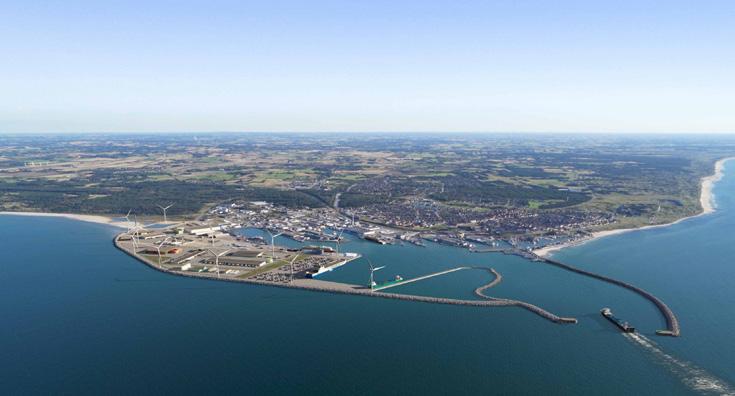

REPORT 68 | Baltic Transport Journal | 1/2024
Photo: Wärtsilä
Photo: Greenport Scandinavia
year, with a potential to become the largest of all similar projects in Sweden.” The Swedish port authority added in a press brief, “The work will also inspire others to establish similar regional collaborations with regard to carbon dioxide infrastructure.” The feasibility study will be conducted in collaboration with Stockholm Exergi, Mälarenergi, Söderenergi , Vattenfall , Heidelberg Materials, Nordkalk, and Plagazi
In mid-November 2023, the CNetSS project, led by Växjö Energi, selected the main alternative for interim storage of CO2 before transport to final depot: Copenhagen Malmö Port ’s (CMP) Norra Hamnen “Malmö is the most efficient and flexible alternative, both for receiving large amounts of carbon dioxide from various locations in southern Sweden and for loading and transporting it to the geological final storage,” said Ghazale Nilsson, Project Manager for CNetSS at Växjö Energi. She added, “We are now continuing our dialogue with various actors in the transport chain. Interim storage requires a great deal of work in terms of permits, risk analysis, coordination of logistics and infrastructure expansion, such as new roads and train tracks. There are many factors to consider.” Sune Norup Christensen, CCO, CMP, also commented, “CMP sees the establishment of an intermediate storage facility for CO2 at the port area in Malmö as a natural extension of CMP’s sustainability strategy and as an essential track towards a green transition. With Malmö’s location, the opportunity to allocate land, and the close local collaboration among emitters, infrastructure partners, CMP, and the City of Malmö, we also see CCS as a potential positive commercial
More and more electric heavy-duty trucks are being deployed in the Baltic, chiefly across the Nordic region. To facilitate this trend, several of the regional seaports invested in bays where truckers can charge their drives.
At the beginning of 2023, Hirtshals announced it’ll be one of the first two places in the country where heavy-duty lorries running on batteries could be recharged (Høje Taastrup is the second). To that end, E.ON Drive Infrastructure picked the Hirtshals Transport Center, located next to the Port of Hirtshals , for establishing a facility with three 400kW fast chargers into which six trucks can plug (with the possibility to upgrade the loading bays to 1.0MW). The facility went online by 2023-end.
Not long after, in February 2023, Göteborgs Lastbilcentral (GLC) commissioned with
opportunity. We are dedicated to realising the ambition in an ‘open access’ hub for CO2 .” The CNetSS project, which the Swedish Energy Agency awarded SEK2.5m (around €220k), gathers ten actors who work on establishing a transport, liquefaction and storage infrastructure in Southern Sweden, with the potential to capture two million tonnes of CO2 per year. Works in 2023 centred around a feasibility study in which various alternatives for CO2 storage were analysed. Apart from CMP and Växjö Energi, E.ON, Höganäs , Kemira , Kraftringen, Nordion Energi, Stora Enso, Sysav, and Öresundskraft take part in the initiative. Since mid-2022, Växjö Energi has been testing new CCS technology developed by the University of Lund ’s Faculty of Engineering, which is said to require noticeably less energy than previous solutions. The new method will capture biogenic carbon, resulting in negative emissions. Växjö Energi intends to capture some 200kt in the near future.
The last carbon capture news to capture Baltic news headlines came in mid-December from Denmark. It was revealed that the EU Just Transition Fund supported the establishment of a CO2 storage and shipment hub in the Port of Hirtshals with DKK109m (€14.6m). The facility can be up and running in 2025/2026, with an initial capacity for handling 0.5mt/year for permanent storage in empty oil & gas fields in the Greensand area of the Danish part of the North Sea. If provided with a pipeline for transporting CO2 to the Port of Hirtshals, the CCUS project of Greenport Scandinavia would be able to take care of 3.0mt/year of CO2 in 2029, up to beyond
E-trucks & charging stations
the help of the Finnish Kempower and Soltechs E-Mobility a fast-charging facility in Gothenburg. The SEK8.0m investment (about €710k) offers 1.0MW of capacity across 15 points. GLC, which operates a fleet of 350 vehicles, will use the charging station to reduce its CO2 emissions by 70% by 2026 (vs 2010 levels; the Swedish transport company intends to become climate-neutral by 2035).
“It is terrific that these charging stations are operational as they will reduce CO2 emissions and make it easier for companies to switch to an electric fleet. I want to thank Kempower and E-Mobility for a smooth cooperation and welcome our co-owners, drivers and partners to our new charging hub,” Martin Salenius, GLC’s CEO, commented. Tomi Ristimäki, CEO of Kempower, added, “We are delighted to see this project go live. Commissioning
15mt/year in the early 2030s should the Danish and European infrastructure be integrated. “We are naturally pleased that the Just Transition Fund prioritises supporting the ambitious project, which aims to make the Port of Hirtshals one of the most important focal points for the storage and shipment of CO2 in Europe. The support means that we can, among other things, start establishing the facilities needed. We see the support as evidence that we are working on a unique project that can contribute to solving the enormous climate challenges facing the world,” Per Holm Nørgaard , the Port of Hirtshals’ CEO, commented. Søren Smalbro, Mayor of the Hjørring Municipality and ViceChairman of the Port of Hirtshals’ Board, also underlined, “There is no doubt that the establishment of a CO2 hub at the port is of great importance – not only for Hirtshals but also for the Hjørring Municipality and the rest of Northern Jutland. The CO2 hub plays a central role in the economic development of the Hjørring Municipality and will undoubtedly create new jobs in our area in connection with the construction and operation of facilities at the port. In addition, the Port of Hirtshals will attract new companies working on the green transition in the coming years, creating even more jobs.” Greenport Scandinavia – whose partners apart from the Port of Hirtshals include INEOS Energy, Wintershall Dea , Evida , Biocarb Solution , Aalborg Portland , Greenport North , EUC Nord , Hydrogen Valley, and Energy Cluster Denmark – now proceeds with planning the physical facilities to be established at the Danish seaport.
one of Sweden’s largest private e-truck charging stations highlights the power of bringing ambitious Nordic companies together. We see the electrification of buses and trucks developing fast in the coming years and projects such as this are meaningful ways to electrify transport.” Martin Götesson, E-Mobility’s CEO also said, “It feels great that we have completed this project for GLC, which is investing heavily in charging infrastructure. Working together with Kempower was outstanding, as it provides a technical solution that is both powerful and intelligent, which this type of large-scale charging station requires.”
Staying in Gothenburg, APM Terminals Gothenburg joined Gothenburg RoRo Terminal and Stena Line in prioritising the flow of heavy-duty electric trucks (the

REPORT 1/2024 | Baltic Transport Journal | 69



trio accounts for about 90% of the Swedish seaport’s truck traffic). As of 1 March 2023, such vehicles are being granted priority passage and handling by the container terminal at the Port of Gothenburg to award haulage companies that have already invested in electrification as well as to encourage those considering it. Specifically, the new solution means that e-trucks are fast-tracked through APM Terminals’ gate 4 via a reserved lane (also enjoying prioritised handling within the terminal area). “This creates efficiency gains and planning ability that is particularly important for electric trucks, as there are strict demands on optimisation given the limited range of electric vehicles,” explained the Port of Gothenburg in a press release. Brian Bitsch , Commercial Manager at APM Terminals Gothenburg, added, “We are seeing more and more haulage firms starting to electrify parts of their vehicle fleets, and we know that more are considering investing in a green transition of heavy goods traffic. We hope that supporting these initiatives by offering the fastest possible passage and handling will serve as an incentive and be one small step along the way.” Johan Söderström, Chief Commercial Officer at Skaraslättens Transport, noted, “Electric trucks are a major investment, so the fact that we now have priority in the container terminal is really important to us. It means that we can perform more assignments every day, which benefits both us and our customers. It also means that we can recoup the investment more quickly.” As such, Söderström’s company decided to up its e-truck fleet from three to five following the favourable treatment of e-trucks. “It is a really important initiative by the terminal operators, which literally paves the way for the transition. With a priority system in place for the terminals that handle the most trucks, and the growing infrastructure for charging in the area around the port, the conditions for electric trucks are better here than at any other port. This is a development we’re incredibly proud of, but there’s still work to be done,” said Martin Adeteg , the Port of Gothenburg’s Vice President Decarbonisation, Health and Safety.
Still in southwestern Sweden, the Danish shipping & logistics company DFDS added 20 Volvo FM Electric lorries to its Arendal depot in Gothenburg at the start of March 2023. The e-trucks can carry a combined total load of 44t, having a range of up to 300380 km when fully charged. The commission formed part of DFDS’ plan to have 125 e-trucks in its fleet by the end of last year. Overall, the company intends to have 25% of its trucks battery electric by 2030, a step

REPORT 70 | Baltic Transport Journal | 1/2024
Photos: Port of Gothenburg


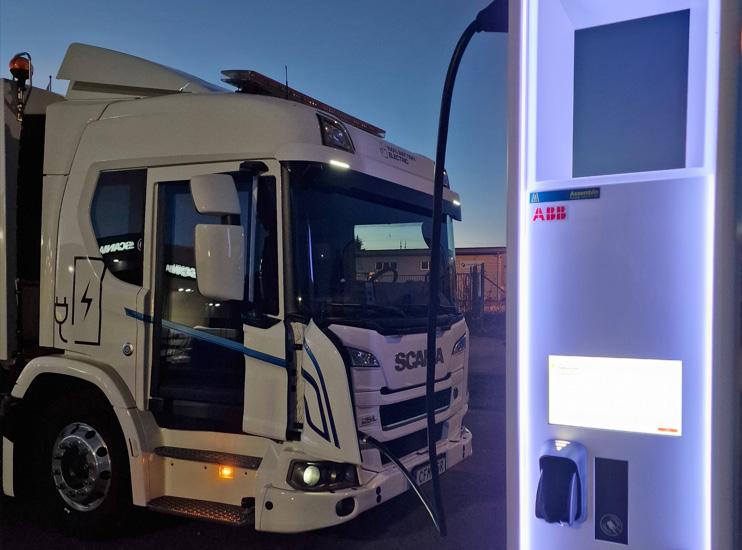
towards achieving carbon neutrality by mid-century. “Replacing our conventional, diesel trucks with alternatives like the Volvo Electric truck will have a significant impact on our carbon emissions. But it requires much more than financial investment. It is important to collaborate with energy experts and industry leaders, like Volvo Trucks, to make our climate ambitions a reality. The transition requires the right infrastructure and cooperation across various areas of society. It cannot be achieved working alone,” Niklas Andersson, EVP and Head of the Logistics Division at DFDS, commented. Edvard Molitor, the Gothenburg Port Authority’s Head of Sustainability, also underlined, “These vehicles represent a massive step in the electrification of land-based transport in the port and the surrounding area. From having been a rare occurrence, this will mean that electric trucks will be a common sight in the port area; this is bound to cause ripples and inspire others.” Roger Alm, Volvo Trucks’ President, also underscored, “The need to accelerate the transition to fossil-free transport is becoming increasingly clear. Therefore, I am very proud of the partnership we have with DFDS and this important step that they take […] in Gothenburg. Together, we are showing the world that electrified heavy truck transport is already a viable solution today.”
Moving north, the Port of Gävle and Gävle Energi first announced (summer 2023) and then finalised (autumn) the project of setting up a new six-charging-bayfacility for e-trucks. The 350kW maximum loading effect infrastructure, located next to the Swedish seaport’s main gate, is said to spare the environment around 4.0kt of CO2equivalent emissions over five years. The parties received support from the Swedish Energy Agency (SEK12m/€1.0m).
In mid-November 2023, Öresundslinjen (formerly known as ForSea) shared that the company’s battery-driven Aurora and Tycho Brahe ferries are now equipped with four 150kW chargers, which can provide eight vehicles with green electricity. According to Molslinjen, the parent company of Öresundslinjen, it’s the first time in the world that e-vehicles on board a ferry can be charged with renewable electricity. The energy is drawn from Aurora and Tycho Brahe ’s battery packs, which are only charged with certified green power coming from sun, wind, or hydro. Öresundslinjen says that up to 260k e-vehicles per year can now be charged when going over the Helsingborg-Helsingør sea bridge (however, hybrid cars cannot use the new equipment due to its high charging capacity).

REPORT 1/2024 | Baltic Transport Journal | 71
Photo: Öresundslinjen
Photo: GLC
Photo: Port of Gävle
Also in the middle of that month, the Port of Gothenburg ’s second e-vehicle charging station started serving clients. The Swedish seaport and Göteborg Energi , with the support of the Swedish Energy Agency, set up four charging spots with up to 350kW capacity. “On the land side, a faster sustainable transition of truck traffic is a crucial factor. From the port’s perspective, we need to ensure that the infrastructure meets the needs and ideally stays ahead. The charging station at Port Entry fits very well into that puzzle,”
Viktor Allgurén , Head of Innovations at the Gothenburg Port Authority, said. He furthered, “The fact that we now have two separate public charging stations in the port is significant in itself [the other being Circle K ’s at Vädermotet]. It provides redundancy in the infrastructure while, in the long run, it can keep prices down for those who charge.” Allgurén also underlined, “We have seen a rapid increase in the number of electric trucks in the port, which is incredibly exciting to see. Concrete incentives and a rapidly
Solar energy
With electricity prices having their ups and even more ups lately, it’s no surprise that Baltic seaports began to turn long unused assets such as roofs into installation spaces for photovoltaic systems.
In June 2023, HHLA TK Estonia’s solar park got up and running. HHLA’s subsidiary operating in the Port of Tallinn’s Muuga Harbour had back then two installations atop two warehouses, with a total capacity of around 240kWp that generates an average of 720kWh/day. On sunny days, HHLA TK Estonia shared, the energy production fully covers the electricity consumption of the warehouses’ cooling and ventilation equipment, plus the needs of a nearby workshop and an office. Additionally, surplus green energy is delivered to the port’s power grid. At the same time, HHLA TK Estonia started preparations to install two additional power parks on the roofs of other warehouses. The 100kWp power park would supply the main office building and container maintenance & repair workshop. Another 400kWp plant would support the Container Yard Electrification project with green energy. The future combined annual electricity production of the
completed solar plant would be an estimated 640MWh. “With the completed solar installation, we aim to generate up to more than half of our total electricity consumption ourselves in a sustainable way. Combining the daytime loading operations of our dual power hybrid crane [Mantsinen 120 DER] with the solar power, we are operating already CO2 neutral in peak hours,” highlighted Riia Sillave, HHLA TK Estonia’s CEO. She further underlined, “With this project, HHLA TK Estonia is contributing to the HHLA Group’s goal of being climate neutral by 2040.”
Before the month’s end, the Ports of Stockholm announced they’ll increase its solar-electricity production by 55%. To that end, the Swedish port authority will invest in six new rooftop photovoltaic systems, increasing its yearly capacity from 995MWh to 1,545MWh by the summer of 2024. The new installations are planned for Stockholm (Frihamnen – one, Värtahamnen – four) and Kapellskär (one). Once commissioned, the port will dispose of 11 sun energy-harvesting farms. “The Ports of Stockholm’s investment in solar electricity is fully aligned with our environmental goals. This

introduced charging infrastructure in the port have definitely contributed to this development.” Malin Flysjö , Business Manager for electricity and gas trading at Göteborg Energi, also commented, “The use of fossil fuels must decrease if Gothenburg is to meet its environmental goals [cutting port-related GHG emissions by 70% by 2030], especially in truck traffic. Therefore, it feels really good to now offer much better opportunities for trucks to charge at charging stations specially designed for large and long vehicles.”
decision means that in future almost onetenth of the electricity we use will be generated by our own solar cell systems,” said Jens Holm, Chairman of the Ports of Stockholm’s Board. The port authority also underlined in a press brief, “The company previously set a goal to increase the proportion of solar electricity by 50% by 2026. According to the time plan for the new solar cell installations, this goal will be achieved already in 2024.”
Also in June 2023, the Port of Södertälje was granted money from the EU’s Connecting Europe Facility : SEK11m (about €940k) will help to scrutinise what it will take to improve and green their transport & logistics. On that note, the Swedish port also said it’s investing to increase its annual solar energy harvesting capacity –from 255,000kWh to 410,000kWh by the end of 2023 (an amount that will cover 30-35% of the seaport’s electricity consumption).
Next month and news came from Poland that OT Port Gdynia put in place its first PV installation. The Polish stevedore active in the Port of Gdynia launched a 50kW system for harvesting solar energy. The company also revealed that it plans to add four more installations by end-2023,


REPORT 72 | Baltic Transport Journal | 1/2024
Photo: HHLA/Mihkel Notta
Photo: Ports of Stockholm
increasing the system’s capacity to 225kW. The stevedore would use the electricity for its own needs, including powering the electric cargo handling equipment it intends to
purchase (forklifts, gantries, and reachstackers). “The PV installations are a response to client expectations, whose planning actions incorporate the carbon footprint
of the entire logistics chain. OT Port Gdynia gains a competitive edge while improving the state of the environment,” underlined Jerzy Majewski, the company’s CEO.
Honourable mentions – digitalisation, electrification, HVO, and hydrogen
When it comes to making the transport & logistics industry more digital, the Finnish tech company Seaber won a few major customers in 2023. First, it was entrusted by Neste, the also from Finland fuel producer, to eco-optimise their logistics. Neste uses Seaber’s software to plan maritime logistics activities such as shipping schedules and port calls. “Seaber’s intelligent technology provides data-led decision support that optimises fleet TCE (time charter equivalent) and reduces costs per tonne-mile, bringing down shipping’s environmental impact. In addition to single cargo voyages, it supports multi-parcel and multi-port voyages, where unnecessary ballast voyages and low utilisation rates are common,” the tech company explained in a press release. Paavo Kojonen, Shipping Asset and Sustainability Manager at Neste, added, “Neste’s goal is to become a global leader in renewable and circular solutions. In order to achieve this, we need to find new ways to reduce the amount of carbon released into the atmosphere. New solutions and partnerships like Seaber are needed to help us optimise maritime logistics, which is one step towards reducing emissions.” Sebastian Sjöberg, Co-founder & CEO of Seaber, also highlighted, “We are thrilled to see that Neste has taken this important step to optimise their shipping scheduling through further
digitalisation. This collaboration enables Neste to optimise their processes, increase vessel utilisation and reduce emissions and cost per tonne-mile. Our partnership allows Seaber to further develop our solution for the benefit of the industry.”
Next, the Norwegian shipping line Wilson, disposing of a 130-big fleet, commissioned the Finnish tech company to digitalise its vessel scheduling to drive efficiency, likewise, reduce costs and emissions. “Our aim is to move cargo safely, on time, and maximise efficiency and sustainability of European sea transport. We were looking for software solutions that could support our mission and believe that Seaber is the best tool to help us further digitalise our operations. It is important for us to improve collaboration and the service we provide to our customers. This is a pioneer project and we expect to set a new standard for how the entire industry manages scheduling in the future,” Jostein Bjørgo, Commercial Director at Wilson, underlined. Seaber’s Sjöberg commented on the co-op, “Seaber integrates with existing technologies used by Wilson and makes the planners’ work easier and more efficient. Replacing spreadsheets means less planning mistakes with improved data ergonomics, data integration and automation. This ultimately leads to reduced costs and emissions

via better utilisation of the fleet. It is great to see Wilson taking this step, so they are better positioned when industry changes happen and new regulations emerge.”
Next-next, the Danish Nørresundbyheadquartered Alba Tankers shared they’ll would use the Finnish maritime tech company’s solutions to optimise the chartering process. This, in turn, would help the company maximise fleet utilisation, hence lower its environmental footprint. Additionally, Alba Tankers would use Seaber’s tools to estimate the impact of including the shipping sector in the EU Emissions Trading System. Alba Tankers’ fleet comprises 20 vessels, trading petroleum products, chemicals, and vegetable oils across Northern Europe and the Western Mediterranean. “As any tanker company, we aim to make sure we operate as environmentally friendly as possible. With current and emerging emission regulations, the whole planning process becomes more complex. With Seaber’s software, our team can quickly make decisions by following KPIs [key performance indicators] and compare multiple scenarios in no time,” Håkan Kalmerlind, Head of Commercial Operations at Alba Tankers, underlined.
Speaking of tankers, in late February 2023, the Port of Gävle said that through its new digital queuing system Time Slot Gävle, it was abandoning the ‘first come-first served’ scheme for vessels calling to one of its energy harbour’s seven terminals. From that month, vessels can apply for queue slots in the Port Activity App, which verifies the scheduled times with automatic ship positioning data. “With the app, we optimised the vessels’ turn-around in the port area. The cool thing about Time Slot Gävle is that we can influence the entire journey to the port from, for example Netherlands, Poland, or the Swedish west coast. We make it possible for all vessels on their way here to choose eco-driving,” Niklas Hermansson, Head of Traffic and Safety at the Port of Gävle, highlighted. Claes Möller, CEO at Tärntank Ship Management (one of the companies initiating Time Slot Gävle), also underscored, “We already use slow-steaming between Preem’s own terminals. Through the Time Slot project, we can also reduce emissions when traveling to ports with quays shared between several terminals. It enables great environmental benefits!”

REPORT 1/2024 | Baltic Transport Journal | 73
Photo: CMP


It is worth remembering that since 2017, the Port of Gävle and its partners have been working on making vessel calls more efficient and sustainable. This work has led to one of the first mobile apps for real-time data exchange between organisations that collaborate around vessel calls. The Port Activity App was developed with the Swedish Maritime Administration, the Port of Rauma , Satakunta University of Applied Sciences , and the Finnish Transport Agency. The app has now been used for almost two years by the actors in the Port of Gävle. Time Slot Gävle is a continuation of that work, with the Swedish seaport developing the vessel queuing system for over three years in close cooperation with the port’s seven energy terminals, with the support of the Swedish Energy Agency, and in partnership with Tärntank Ship Management, Preem and the Swedish National Road and Transport Research Institute. “We hope
to inspire more ports to introduce similar systems. Shipping is a good example of how important it is that we work with interfaces between organisations and system connections. Everyone wants to change, but we need to work together to remove the obstacles. We have learned a lot through the cooperation within Time Slot Gävle. Together, we have also come a small step closer to our shared climate goals,” Linda Astner, the Port of Gävle’s Head of Sustainability, encouraged others to take action.
In August 2023, the Port of Helsinki ’s new smart check-in gate system got rolling. With the help of Visy, the Finnish seaport put in place a solution that weighs, measures, and photographs passenger cars and trucks at the West and Katajanokka harbours. The system – consisting of scanner-based preliminary vehicle identification points, automatic barriers, and display panels guiding drivers to the right lane – identifies the
vehicles using a camera and automatically checks their permits when they approach the check-in area. All vehicles are measured, while lorries are also weighed and have their condition recorded. The Port of Helsinki has received EU financial support for implementing the project, with the funds used for planning, placing the infrastructure, developing the system, and procuring & installing the required hardware. “Particularly with heavy vehicles, it is also important to verify dimensions and weights. Accurate and up-to-date information improves the efficiency of both the port and shipping companies,” Arto Satuli, Traffic Manager at the Port of Helsinki, underscored. Jenni Anttila , responsible for heavy vehicle booking and operations at Eckerö Line, also commented, “[…] I already see great potential in these types of new gate arrangements. The measurement data and smooth information exchange make it possible to streamline check-in tasks. More accurate measurement data also supports the balanced loading of ships, which in turn translates into more efficient fuel consumption, for example. In the end, it’s all about cost efficiency.”
At the beginning of fall 2023, two seaports from Sweden’s north, Luleå and Piteå, together signed a contract with Grieg Connect to digitalise their operations. Digitalisation would help them improve data exchange for better quay and resource planning. The transition would also see the ports’ operational areas visualised with different map views and GPS points to monitor how the port infrastructure is used over time. Additionally, work orders would be conveyed digitally likewise back reporting. Anders Dahl, CEO of the Port of Luleå, commented, “Our port grows in step with the region of Norrbotten’s unique opportunity to be a world leader in the green transition. A condition for that is the close partnership with the Port of Piteå, and the joint digital ecosystem is an important piece of the future’s puzzle.”
In October last year, the FIN-EST Green Corridor initiative kicked off. The ports of Helsinki and Tallinn, Rederi AB Eckerö, Tallink Grupp, Viking Line and Estonia’s Ministry of Climate, with support from the Finnish Ministry of Transport and Communications , teamed to reduce GHG emissions from transport & logistics. The memorandum of understanding aims at making the Tallinn-Helsinki and Vuosaari-Muuga crossings climate-neutral for passenger and cargo traffic, on- and offshore. “It is important that the connection between Helsinki and Tallinn is environmentally even more sustainable in the

REPORT 74 | Baltic Transport Journal | 1/2024
Photo: Port of Luleå
Photo: Gardar Johannsson/Wilson
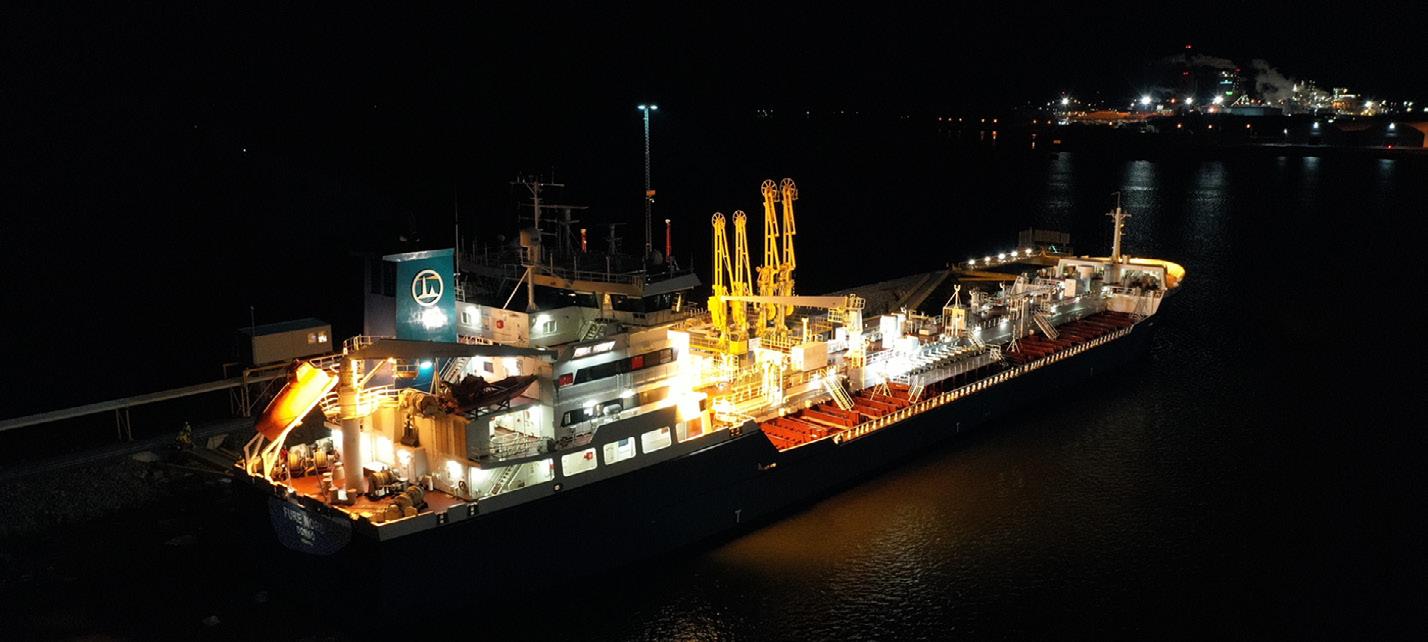
future. More than the mandatory steps need to be taken to ensure that. It is vital that all major players participate in this activity, so this is a day of great importance and a turning point for working together with all partners in favour of climate and nature,” said Valdo Kalm, CEO of the Port of Tallinn. Ville Haapasaari, the Port of Helsinki’s CEO, also commented, “We look forward to the co-operation this project offers between all parties. I’m convinced that we can find smart and better solutions to tackling the climate change in this area of ours and to ensure the future growth and welfare of the two countries.” Around nine million passengers and two million vehicles are carried between Helsinki and Tallinn yearly.
In November 2023, the Port of Kalundborg shared it would electrify all cranes in its deep-water container terminal, operated by APM Terminals, within several months (the facility’s gantry fleet consists of three Konecranes Gottwald mobile harbour cranes, two capable of lifting 100t and the third – 150t). In the interim, APM Terminals Kalundborg committed to using hydrotreated vegetable oil (HVO) as fuel, which is said to reduce CO2 emissions by up to 90%. The announcement was made on the occasion of Laura Mærsk, Maersk’s first methanol feeder, calling to Kalundborg. “With the measures we are taking, we can offer a green gateway to the Zealand market,” underlined Mikael Gutman, CEO of APM Terminals Nordics. The 50k TEUs/year capacity Kalundborg thus joined Gothenburg and Los Angeles, the two other sites in the APM Terminals family that use biofuel.
Also in November, Copenhagen Malmö Port (CMP) began switching its
Copenhagen container terminal’s fossil fuel machinery to run on HVO. The facility’s newer terminal tractors, rear loaders, and industrial trucks would be the first to phase in the green fuel. The move would avoid consuming 60k litres of diesel per year, reducing CMP’s footprint in Denmark by some 130t of CO2e/year. The new battery-hybrid straddle carriers CMP ordered in April 2023 would also tank HVO (the terminal’s shipto-shore gantries and other work vehicles run on green electricity). In 2025, the container terminal in Copenhagen will move to Ydre Nordhavn, and CMP expects that all fossil fuels will be phased out at all facilities by that time. In Malmö, CMP’s other seaport, phasing in HVO reduced emissions by approximately 840t CO2e/year. CMP intends to make its operations CO2-neutral and climate-positive by 2025 and 2040, respectively (in accordance with the Science Based Targets initiative). The Danish-Swedish port authority cut its scope 1 and 2 GHG emissions by 57% in 2020-22, thus avoiding the release of 1,231t of CO2e. “The green transition of CMP’s operations is not something we are only planning for in the future – it is already happening now, and the phasing in of HVO100 at the container terminal in Copenhagen is a very important and natural step in our efforts to be one of the world’s most sustainable ports,” underscored Povl Dolleris Røjkjær Ungar, CMP’s COO. He also underlined, “The phase-in of HVO100 follows the replacement of CMP’s machinery and means that CMP can also support our customers’ demand for fossil-free and CO2-neutral transport chains.”
Still in November last year, and news surfaced that the Port of Ventpils and
PurpleGreen Energy C hydrogen struck a co-op. Specifically, the Latvian seaport and the Riga-based company will conduct research into setting up a green hydrogen factory in Ventspils. The agreement also included granting PurpleGreen Energy C the building rights on a ten-hectare plot for erecting the facility. “Ventspils has all the advantages to develop into a future energy production and export hub, which in turn would be a great competitive advantage for establishments to start and expand their operations here. Currently, the Freeport of Ventspils is purposefully developing the renewable energy cluster in Ventspils, and the production of green hydrogen is one of the most important cornerstones in this complex of diverse activities. We are satisfied that PurpleGreen Energy C chose the Freeport of Ventspils as a place for the development of its project, and we are ready for active and effective cooperation,” Igors Udodovs , Deputy CEO of the Freeport of Ventspils Authority, commented. Māris Daniševskis , Lead P2X Project Manager, PurpleGreen Energy C, added, “We see great potential for Latvia to become a renewable energy export country. One of the most suitable ways to export renewable energy is to convert it into the form of renewable electricity molecules and further export this energy using the existing infrastructure of the Freeport of Ventspils, as well as by collaborating with businesses operating in Ventspils – for instance, in the form of e-methanol or green ammonia. We thank the Freeport of Ventspils for the successfully initiated cooperation, and we are working on the realization of this project with great optimism.”

REPORT 1/2024 | Baltic Transport Journal | 75
Photo: Port of Gävle
Wind turbines at sea – the BPO Offshore Wind Conference on the horizon
by Monika Rogo, Communication Manager, BPO
The first edition of the BPO Offshore Wind Conference will provide participants with an insight into the role of ports in offshore wind development projects. Discussion panels, case studies, and presentations will take a broad look at this issue and encourage everyone to partake in the debate. The event will take place on 13 March 2024 in Gdynia during the 2 nd day of Transport Week .

Offshore wind energy (OWE) is one of the leading topics in the industry. For this reason, the Baltic Ports Organization (BPO) decided to take a closer look at this issue. The 2 nd day of Transport Week will be devoted entirely to various offshore wind development projects.
Session 1 will tackle the opportunities and challenges for the Baltic ports interested in a piece of the OWE pie, as well as present some of the current projects in the Baltic Sea region (BSR) and the possibilities of achieving EU and Baltic 2030 OWE capacity targets.
The following session will update the participants on the EU’s renewable
energy policies and regulations. It will also spotlight the peculiarities of the logistic chain for the construction of OWE farms and attempt to capture the dynamics between a project’s master plan and its successful execution.
The last session will be devoted to what’s needed to make a potential OWE farm project a reality: from port capacity, quay infrastructure, and handling equipment to rapid technological progress and the likelihood of there not being enough ships to cater to the rising demand. There will be at the end an inaugural meeting of the BPO Offshore Wind Energy Working Group for BPO Members.
Transport Week 2024
For over a decade, the Transport Week conferences have brought experts and enthusiasts from across the BSR and Central Europe to dig into pivotal issues surrounding the present & future of the transport & logistics sector, including the port & shipping industries. This year’s edition will see its 1st day revolving around trends determining further development of the transport industry in Europe, the role the European transport sector can play in shaping EU policies in the years ahead, port investments in the BSR, and the impact of environmental-social-corporate governance trends & regulations on transport & logistics.

76 | Baltic Transport Journal | 1/2024
Photo: Canva
Destination: climate issues
by Monika Rogo, Communication Manager, BPO
The Baltic Ports Organization (BPO) acknowledges the increasing and negative impact of climate change on the Earth’s ecosystem and human society. Its Members strongly believe that combating climate change is the responsibility of all, including the businesses forming the transport, shipping, and port sectors. For these reasons, the Organization has been focusing more on climate topics since last year, having launched several initiatives in this area.
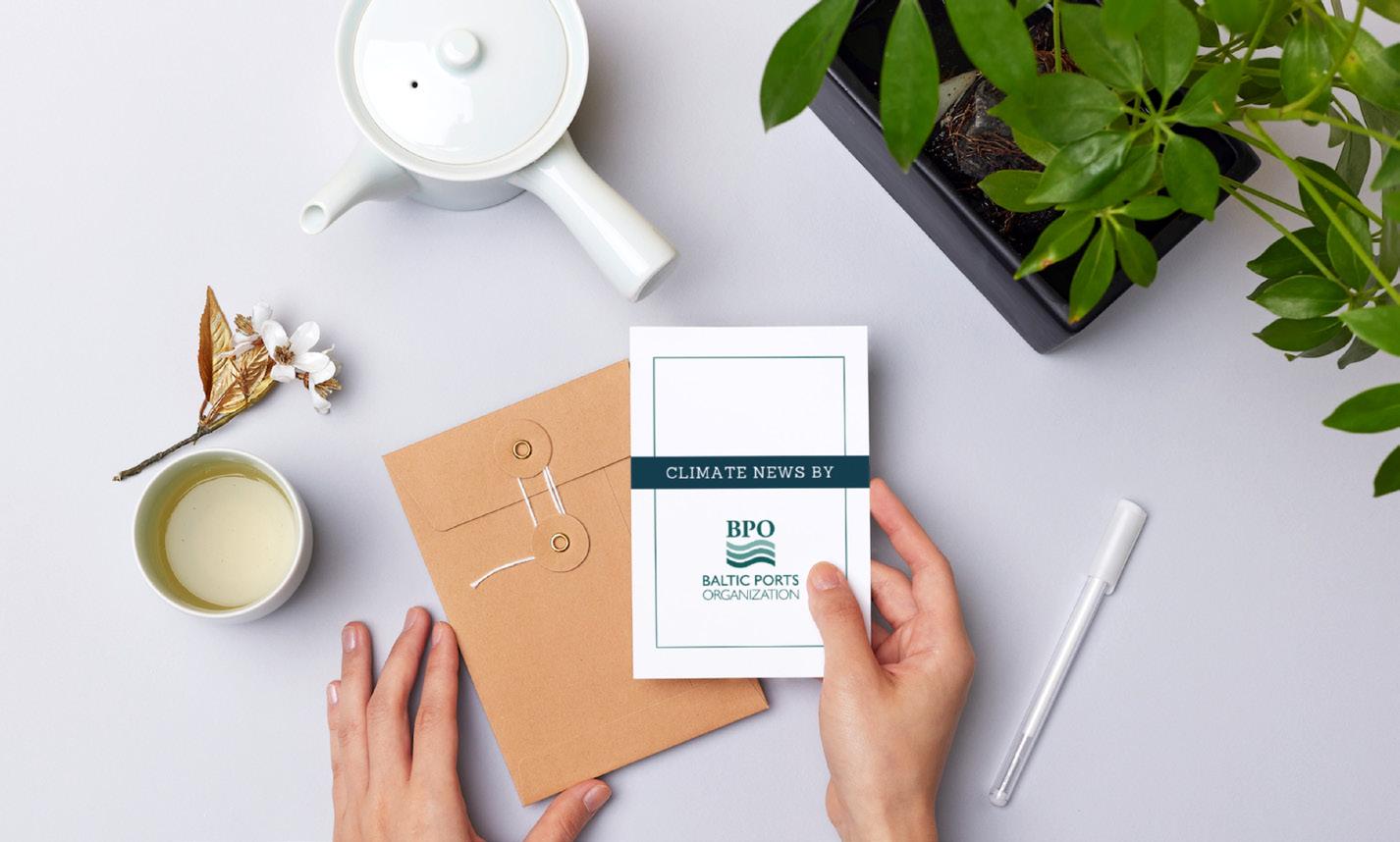
Last September, the Baltic Ports Organization signed the BPO Ystad Climate Declaration , expressing the willingness of the regional seaports to combat climate change and also communicating the need for solid cooperation with a broader range of stakeholders to reach progress in this matter.
Another initiative, Baltic Ports for Climate, is connected with onshore power supply (OPS) development, the aim of which is to intensify collaboration between ports and other stakeholders to reduce greenhouse gas emissions in the Baltic Sea. The main idea behind the project is to promote the development and construction of OPS facilities in the
Baltic Sea Region (BSR) ports, expanding the already existing cold ironing network for different vessel types (ferries, cruisers, and container ships).
The BPO recently submitted a call under the transport envelope to the EU Connecting Europe Facility (CEF). The project foremost concerns OPS pre-investment studies in seven TEN-T Core Ports (Gdynia, Gdańsk, Hamburg, Klaipėda, Riga, Stockholm, and Tallinn), but it’ll also set up a stakeholder platform, among others, for sharing the findings. The pre-investment studies, performed by each project partner, will focus on installations dedicated to ferries, cruise ships and container carriers and
will provide the necessary background for investments in OPS infrastructure and other zero-emission solutions.
Next, there is the BPO Work Plan 2024, consisting of several climate-related events, including the BPO Offshore Wind Conference at Transport Week 2024, the Ports 4.0 Conference in Riga, the annual Baltic Ports Conference in Klaipėda, and the BPO Climate Conference in Tallinn.
The Organization has also introduced Climate News by BPO into its communication, a round-up that addresses current environmental issues and pro-ecological activities in the BSR. Selected news bits are shared on the Organization’s website, in its newsletter, and via BPO’s LinkedIn profile.

BALTIC PORTS ORGANIZATION • Secretariat Office – Actia Forum Ltd. ul. Pułaskiego 8, 81-368 Gdynia, POLAND, ph.: +48 58 627 24 67, fax: +48 58 627 24 27, e-mail: bpo.office@actiaforum.pl, bpo.sg@actiaforum.pl, www.bpoports.com 1/2024 | Baltic Transport Journal | 77
Photo: Canva
Can a single maritime artificial intelligence (AI) research project cut 1% of total global emissions?
Well, duh!
by Alexa Ivy
Be ready to pick your jaw up off the floor as NAVTOR’s Chief Sustainability Officer Bjørn Åge Hjøllo explains how the Green AI for Sustainable Shipping (GASS) initiative promises to transform the ability of shipowners and operators to slash fuel consumption, emissions, and operational expenses (OPEX), ushering in a smarter, greener, and more connected maritime future. Sorry, what did you just say? Hjøllo smiles in recognition of the apparent disbelief. He tries again: “I said that this project has the potential to cut 1% of all global emissions.” Do you mean 1% of all shipping emissions? “No, 1% of total global emissions… For everything!” Sorry. What?!
This may be the first, but it won’t be the last time Hjøllo is met by someone who needs to reboot their brain while struggling to come to terms with the ambition of the Norwegian government-backed GASS research project.
Led by NAVTOR, the initiative is a partnership with Grieg Star, Maritime CleanTech, Scandinavian Reach Technologies (ScanReach), Simula Research Laboratory, SinOceanic Shipping, and Sustainable Energy/SIVA, with support from the Norwegian Research Council, Innovation Norway, and SIVA.
Over the next three years, it aims to champion what Hjøllo calls a “datadriven approach to decarbonization,” enabling shipping companies to identify, analyze, and address inefficient energy use on any vessel, in any location, in any weather conditions, in real-time.
Powered by machine learning algorithms, digital twin technology, and a constant stream of high-quality data, the result will be, says Hjøllo, “a simple, powerful decision-making tool that allows users to maintain competitiveness, achieve regulatory compliance and, in short, unlock more sustainable shipping.”
Although he makes it sound ‘easy,’ there’s much hard work that needs to be done first. And this is where the partnership model comes in.
Teamwork makes the dream work
As in any ambitious team, each GASS player has clearly defined roles. NAVTOR is the world’s leading supplier of maritime
technology for e-navigation and performance solutions, with products and daily services on over 18,000 vessels in the world’s fleet. With expertise derived from building and continually developing an integrated digital ‘ecosystem’ connecting ships, fleets, and entire organizations, it is well placed to design, integrate, and eventually bring this type of innovation to market.
Grieg Star, SinOceanic Shipping, and Sustainable Energy/SIVA provide both invaluable domain expertise and the crucial test vessels required to build, run, and constantly refine the solution for real-world operations.
Meanwhile, ScanReach offers a unique wireless Internet of Things platform that connects sensors, equipment, and systems across complex steel vessel environments to harvest the data needed for GASS’ highpower processing engines.
Simula’s role sees the team leveraging their renowned developer experience to create the machine learning and digital twin back-end to empower the front-end benefits.
Finally, Maritime CleanTech is on hand to disseminate information and encourage interaction with another potential 150 partners through its futurefocused industry cluster.
So, that’s the Big picture, but we have to zoom in to see how this will work in reality. Hjøllo is happy to ‘go granular.’
Richer data = cheaper operations
“At present, there are no systematic data‐driven solutions for improving energy efficiency onboard, and GASS aims to address
that,” he says. “We want to capture granular information from a very wide range of high-frequency data that basically allows us to predict what a vessel’s fuel consumption should be, regardless of ship type, location, weather, and so on. That means integrating precision data from vessel operations and exact operating environments – combining metocean condition and forecast data, automatic identification system data, and a whole range of reporting & performance data gathered in real-time, all the time, from sensors. That can span anything ranging from propeller information to engine revolutions per minute, navigational data, speed, and the like.”
Once they have this building material, Hjøllo explains, it can be used to craft a digital twin of any vessel that, regardless of operational parameters, can be used to demonstrate optimal fuel consumption. If the ‘real world’ ship is failing to live up to its virtual sibling’s performance, then the data can be instantly analyzed to find out why. “Maybe there’s an issue with the trim of the vessel, or a problem with fouling, or perhaps the auxiliary engine has been used in a congested area, so it’s still running when there’s no need,” he says.
“With much richer, real-time data than ever before,” Hjøllo furthers, “we can unlock up-to-the-minute awareness and performance analytics that enable dynamic voyage optimization – as opposed to today’s ‘static’ standard – and allow onshore teams and onboard crews to address issues/deviations from plans as they actually happen. That’s an incredibly powerful advantage to have,

78 | Baltic Transport Journal | 1/2024

especially in the new regulatory reality of Carbon Intensity Indicator ratings and the EU Emissions Trading System, for example, and the associated costs and investments associated with compliance.” In other words, he says, “This could be huge!”
Once extensive testing and validation have been completed, the AI module will be integrated into NAVTOR’s existing joined-op portfolio. Although it’s early days, Hjøllo suggests that this would be on both NavStation (the company’s onboard digital chart table/planning system) and NavFleet (a shore-based management, monitoring, and optimization solution), allowing both vessel and office teams to make the most of up-to-the-minute insights and enhance decision making.
“We’ve always been focused on developing innovations that simplify life at sea for our customers,” Hjøllo states. “This is the epitome of that: gathering and utilizing vast amounts of complex data to deliver straightforward, actionable, and powerful recommendations. It’s an advisory functionality that we’re constantly building, helping deliver added value for anyone that’s looking to gain advantage.”
As his job title suggests, the key advantages Hjøllo is setting his sights on revolve

around sustainability, which, as he rightly points out, goes hand in hand with commercial benefits. “If we can dynamically optimize voyages and energy consumption, we can also, by extension, dynamically optimize costs,” he says, “helping owners around the world cut down on their greatest OPEX outgoing.”
“But, as you might expect, it’s the impact on emissions that should create the greatest excitement,” Hjøllo notes. That brings us back to the 1% figure. How is that even possible?
No roadblocks
Hjøllo admits that the number is both a best- and worst-case forecasted scenario. Here’s how the GASS partners arrived at it: today, worldwide shipping accounts for nearly 3% of greenhouse gas (GHG) emissions. However, widely reported research suggests that it could reach as much as 17% (you read that right!) by mid-century as global trade expands while other industries cut their emissions faster than maritime. GASS expects that a machine learning application that dynamically optimizes vessel energy use should be able to reduce consumption, and therefore GHG emissions, by 20%.
So, when the 30%+ of vessels in the world fleet that use NAVTOR products have their breakthrough AI technology powered up, that translates to over a 5% cut in all of the shipping emissions and, assuming the 17% figure, a 1% cut in total global footprint.
Hjøllo can’t suppress a smile but is cautious enough not to get carried away. “I think the important thing is there’s nothing to suggest we can’t do this – we, and our partners, have the track record, technology, and domain expertise to succeed here. The 1% figure obviously depends on a lot of variables that are beyond our control, but the 20% reduction per vessel doesn’t. That is a very realistic target.”
He concludes: “If we can play a part in reducing energy use and emissions by one-fifth on every vessel we serve –regardless of type, age, location, weather, whatever! – imagine how powerful that could be. Imagine the difference environmentally, from a regulatory perspective and commercially. In an industry and a world where every marginal gain is a major win, this is… Well…”
He shrugs his shoulders, temporarily lost for words. Even Hjøllo, it appears, needs to reboot sometimes.
Our e-Navigation and Performance experts don’t follow development, they steer it. NAVTOR is dedicated to being at the vanguard of the industry – working with partners throughout the globe to pinpoint the areas where e-Navigation can deliver the greatest benefits, then finding the solutions to unlock them. Sail to navtor.com to discover more.

TECHNOLOGY 1/2024 | Baltic Transport Journal | 79
Photo: NAVTOR
SPEARheading the right approach
by Niraj Bhatt, Senior Vice President of Technology & Innovation, Advent eModal
In the intricate world of supply chain management, data stands as the backbone of operational efficiency and strategic planning. It serves as the lifeblood that flows through every logistical node, ensuring that goods are moved efficiently, resources are allocated effectively, and customer demands are met promptly. The reliance on accurate and timely data is paramount, as it enables businesses to anticipate market trends, optimize inventory levels, and streamline logistics processes.
However, the increasing competitiveness in the supply chain industry has led some entities to resort to illegal data scraping to gain insights and a competitive edge. Whereas the allure of easily accessible data through scraping may seem tempting, it is a short-sighted approach that ultimately creates silos, introduces friction, and hampers the effectiveness of the overall supply chain.
At Advent eModal, we are committed to addressing this critical challenge by fostering a culture of innovation through official data exchange – a framework we refer to as SPEAR. This approach encourages legal, ethical, and collaborative means that supply chains can use to harness the power of data. The endeavor is undeniably monumental, bringing diverse stakeholders together and investing time & resources to build solutions for the entire ecosystem.
That said, we are confident that the SPEAR approach will lead to transparency, ensure compliance with governmental regulations, eliminate friction, and increase the effectiveness of the supply chain at large.
A low-cost and quick fix?
Before we get into the details of the SPEAR framework, let’s understand the numerous fallacies of data scraping. In the intermodal sector, it often entails the unauthorized extraction of vital information
(such as schedules, capacity, and pricing) from websites and online platforms.
Companies continue to choose data scraping because it’s a low-cost, quickfix option for addressing their problems. However, this approach fails to provide a stable, long-term solution that is aligned with overarching business objectives. It significantly undermines the integrity of data and poses considerable risks that erode the reliability and efficiency that the industry relies on.
Stakeholders that rely on data scraping face several potential issues. First, legal and ethical complications: engaging in unauthorized data scraping can lead to serious legal complications. It often breaches terms of service and can violate data privacy regulations, placing companies at risk of legal repercussions.
Second, data quality and reliability: the accuracy and timeliness of scraped data are often questionable. Reliance on such data can lead to unreliable business insights and erroneous strategic decisions.
Third, technical challenges: websites and online platforms frequently update, making scraping tools unreliable. This forces companies to continuously maintain and adjust their strategy, adding hidden costs.
Fourth, scalability and maintenance: as the demand for data increases, scaling scraping operations become more expensive and complex.
Lastly, security risks: data scraping tools can expose both the data extractor and the data source to significant cybersecurity threats.
What makes for a good SPEAR
Preventing illegal scrapers or bad bots from accessing data is a major challenge for today’s enterprises. The bot industry is vast and continues to grow exponentially (with bots accounting for over 40% of total Internet traffic). While newer technological solutions are critical in mitigating the risks of data scraping, they are not foolproof. Solutions like reCAPTCHA, rate limiting, honeypots, browser fingerprinting, and sophisticated bot detection algorithms help screen out bots and control data access. Then again, these solutions aren’t always consistently reliable since scraping technologies, too, are constantly evolving to bypass these barriers.
Hence, while these preventive measures are necessary, they are not entirely watertight and, on the other hand, can hinder access or deteriorate experience for valid users. In addition, they also don’t address the root problem – the business driver for unauthorized extraction and use of data. This is where SPEAR comes in. Let’s unpack what stands behind it.
Strategize: this phase of the SPEAR framework represents a crucial starting point where deep analysis of a business

80 | Baltic Transport Journal | 1/2024
Five steps to tackle the data scraping menace

problem is conducted, specifically focusing on how data interplays with these issues. The problems could be end-to-end visibility, scheduling, empty returns, street turns, settling fee dues, or anything else. The goal is to understand the broader context of data gaps within the current processes. At Advent, we seek participation across various intermodal stakeholders to scrutinize existing operational models and data workflows, pinpoint inefficiencies, and identify areas ripe for innovation. By maintaining a dual focus on both data and business processes, this stage ensures that the strategy developed is robust, holistic, and aligned with the business goals.
Partner: after the foundation is laid in the strategizing phase, the focus shifts to forging partnerships and alliances with a broader intermodal ecosystem to bridge the data gaps. The aim is to establish symbiotic partnerships where data sharing and collaborative efforts lead to mutual growth and success. During this phase, it’s important to get each stakeholder to negotiate and set up agreements that clearly define the terms of data sharing, usage, and confidentiality.
Evaluate: this step is deeply aligned with agile principles, focusing on the continuous assessment of outcomes, especially
those derived from minimum lovable products brought to life through collaborative efforts. The evaluation phase is crucial for learning and growth; in this agile environment, it is not just about measuring success but also about being prepared to pivot if necessary. This phase is characterized by its flexibility and adaptability.
Achieve: this is where strategic planning, robust partnerships, and iterative evaluations converge to yield tangible success. At this stage, the data flow established through strategic partnerships and alliances comes to fruition. This rigorous data integrity standard drives confident decision-making and operational efficiency. The Achieve phase ensures that every stakeholder derives value from the collaboration by aligning the data-sharing objectives with the business goals.
Refine: the focus is on continuous improvement and adaptation at this stage. In an ever-evolving business landscape,
staying on top of data flows, consistently assessing data quality, and continually improving strategy are beneficial and essential for long-term success. Another critical aspect of this phase is the stakeholder feedback loop that helps fine-tune data collection methods, analysis techniques, and even overarching data strategies.
Freely yet securely
In conclusion, by prioritizing ethical data practices, fostering robust partnerships, and embracing continuous innovation, we are not just combating the risks associated with data scraping but also paving the way for a more transparent, efficient, and collaborative future.
With the SPEAR framework as our guide, let’s remain focused on creating a supply chain ecosystem where data flows freely yet securely, collaboration is the norm, and every stakeholder can achieve the desired enhanced operational efficiency.
Advent eModal is a multinational solutions company that provides cloud-based software-as-a-service for intermodal equipment interchange, connecting multi-modal stakeholders through applications that remove friction at every point of cargo movement. Established in 1995 in Somerset, New Jersey, the company has grown to become the world’s largest port community provider. Head to adventemodal.com to learn more.

TECHNOLOGY 1/2024 | Baltic Transport Journal | 81
Photo: Canva
From news buzz to buzzing with activity
by Grant Ingram, CEO for UK and EMEA, Innovez One
The maritime industry’s future hinges on our ability to effectively integrate cutting-edge technologies like artificial intelligence (AI) and digitalisation, likewise putting weight behind multi-stakeholder projects such as green corridors, translating them from novel ideas into core operational strategies. Globally, ports are voicing their commitment to sustainability and actively exploring transformative technologies to help them move the green needle. Yet, in this landscape teeming with promise and potential, a critical need exists for a discerning eye.
Distinguishing real, impactful advancements from fleeting trends is not just a matter of choice but a necessity for those steering the future of maritime operations. While ambitious plans and sweeping declarations are easy to make, the true test is their translation into effective, lasting changes. In other words, the crux of this transformation lies in its execution.
This demands more than a cursory look at new technologies; it requires a deep dive into their capabilities, limitations, and real-world applications. The maritime industry, as such, finds itself not just at a point of adopting new technologies but at a moment where understanding their depth and scope becomes paramount.
Maritime industry leaders must, therefore, do what they can to sift through the noise and identify solutions that are both pragmatically viable and sustainable in the long run. We are standing ready not just to witness but to shape a future where technology meets practicality, with technological innovations actively adopted and adapted to redefine maritime operations.
Wanted: a cohesive digital strategy
Port digitalisation is vital in the maritime industry’s on- and offshore journey towards decarbonisation. This process involves more than merely adopting digital tools; it requires a fundamental
transformation in how ports operate and interact with their wider ecosystems. Digitalisation paves the way for enhanced operational efficiency, reduced emissions, and a more sustainable maritime environment. However, the path to successful digitalisation is fraught with challenges.
A common pitfall in this journey is a siloed approach to digital efforts. Ports often implement modern tech solutions in isolated segments, leading to a fragmented technological landscape. This fragmentation hinders the seamless flow of information, which is crucial for optimising operations and reducing environmental impact. Instead of isolated upgrades, what is needed is a cohesive digital strategy that integrates various aspects of port operations. This integration enables ports to leverage data comprehensively, fostering informed decisionmaking and efficient resource utilisation.
Furthermore, an integrated digital strategy is essential to foster collaboration between different stakeholders in the maritime chain. By enabling real-time data sharing and communication, ports can synchronise their activities with shipping companies, logistics providers, and regulatory bodies, creating a more responsive and agile maritime ecosystem.
However, implementing such a digital strategy has its complexities. It demands technological investment and a change in mindset and culture within port authorities
and their partners. Embracing digitalisation requires a willingness to innovate and adapt to new ways of working.
While the road to effective port digitalisation is challenging, its importance cannot be overstated. As the maritime industry strives towards a greener and more efficient future, a well-planned, integrated digital strategy will be critical in achieving genuine progress rather than superficial change.
No room for mistakes
The integration of AI in operations can quickly bring about tangible benefits to port authorities worldwide, with Tanjung Priok being a shining example. Following the adoption of the AI-driven system MarineM, the Indonesian port has achieved a 20% reduction in operational distances for tug and pilot movements, translating not only into emission reductions but also into substantial economic benefits, such as an annual saving of $155k in fuel costs. This success story is a testament to the transformative potential of AI in enhancing port efficiency and sustainability.
The role of AI in ports extends beyond operational efficiency, including predictive maintenance, traffic management, and cargo handling optimisation. These applications significantly reduce delays and increase throughput, making ports more responsive to the dynamic demands of maritime logistics.

82 | Baltic Transport Journal | 1/2024
How AI, green shipping corridors, and digitalisation are redefining maritime operations

Realising these benefits necessitates a nuanced approach to developing and training AI algorithms. These systems must be developed with an understanding of the distinct challenges and complexities of maritime environments. In practice, training AI algorithms on tailored datasets and with clear parameters ensures they can adapt to the variable and unpredictable scenarios encountered in real-world port operations and will consistently offer reliable solutions.
Additionally, the safety-critical nature of port operations demands that AI systems are not only efficient but also reliable and transparent. There is no room for mistakes! The high stakes necessitate prioritising accuracy and accountability in AI development, ensuring these systems are robust and will not come up with offtrack or unrealistic solutions.
Through careful implementation, AI in ports is poised to revolutionise maritime operations. This technology is both a tool for automation and a conduit for safer, more intelligent, and far more sustainable operations (as evidenced by Tanjung Priok’s experience).
More than a concept
Green shipping corridors are also quickly gaining traction. These specially designated routes focus on reducing maritime emissions by adopting green technologies and practices. They function as
test beds for innovations like alternative fuels, energy-efficient ships, and emissionreducing operational strategies.
Establishing these corridors is a step towards tangible environmental improvements, but their success relies heavily on action – not just intent. Implementing green corridors requires a robust digital infrastructure to monitor and manage emissions and fuel usage effectively. Digital tools enable the precise tracking of environmental impacts, helping to optimise operations for greater sustainability. This digital foundation is essential for providing the data and insights needed to make informed decisions and measure the effectiveness of green initiatives.
Green shipping corridors are, therefore, more than a concept; they are a call to action. To ensure their success, they require an amalgamation of innovative technologies, collaborative efforts among industry stakeholders, and a robust digital backbone. Through these corridors, the maritime industry can pave the way for a more sustainable future, demonstrating that commitment to environmental

goals goes hand-in-hand with practical and measurable actions.
Thoughtful approach
The industry’s push into AI, digitalisation, and green shipping corridors isn’t just about embracing spanking-new technologies for the sake of it; it’s about integrating them to ensure lasting, meaningful change. This path requires rigorous scrutiny and a commitment to ensuring these advancements genuinely enhance maritime operations’ efficiency, safety, and sustainability.
The maritime sector stands at a threshold of genuinely transformative change. The decisions made today about implementing and integrating new technologies will shape the tomorrow of maritime operations. As the industry navigates these changes, the focus must remain on ensuring that these technological advancements are adapted to meet the unique and complex challenges of the maritime world.
This thoughtful approach will ultimately determine the success and impact of these technological endeavours.

TECHNOLOGY 1/2024 | Baltic Transport Journal | 83
The Singapore-headquartered Innovez One has been delivering expert maritime software solutions for the world’s busiest ports and towage operators since 2004. With a vision to automate complex maritime operations for ports, towage and workboat operators worldwide, the Innovez One team has engineered and developed the MarineM platform that helps to optimise critical maritime resource allocations for operations carried out by ports of all sizes. Go to www.innovez-one.com to find out more.
Photo: Canva
Identify as smart
by Kadri Haufe, Head of
Smart Port Advisory, Nortal
Even if most ports aren’t yet ‘smart,’ smart port technology is well known. But digital identity verification, which can elevate that smartness to new heights, is a solution that fewer port professionals are aware of.
Asmart port is one where nothing is expected of a driver or passenger beyond following foolproof directions. Nowhere will someone wonder which way to turn. Nowhere will a passenger be asked to fill in a form. And they never have to present their identification.
In port operations, the benefits of smart are also fairly well recognised. Manual work is eliminated in terminal traffic management, vehicle classification is done effortlessly, and paper disappears from the system just as port congestion (and CO 2) is massively reduced, not to mention precisely measured.
But it’s possible to make this seamless experience even better – for passengers, cars, cargo, and those who manage the entire process.
Much more than just an add-on Digital biometric identity verification solutions can be used to identify
passengers and drivers in free flow during check-in and customs procedures. They can pre-enrol online by uploading a photo of their passport or driver’s license or do so in the port (at smart registration/enrollment kiosks, aka totems) before entering check-in. It gives commercial drivers the added benefit of linking digital identity verification with vehicle registration for a swift entry process.
The technology can also be used to give (and restrict) staff and contractor access to the terminal (restricted zones or operational centres) – and even equipment (beyond zone access, biometric identity verification ensures only certified employees operate specific machinery, ensuring compliance with safety regulations). Port security is improved, and humans are no longer needed to lock and unlock doors.
The solution can boost revenues, enable the upselling of personalised services for passengers, and offer discounts on food and drink to frequent customers
(rewarding them with exclusive offers or expedited processing for enhanced loyalty). Travellers opting for personalised services receive a warm welcome by name and tailored recommendations for onboard amenities or retail deals.
On board, the technology can also regulate passenger access to cabins or spas, eliminating key cards (thus freeing up personnel that otherwise would have to issue them). Integration with onboard service systems allows passengers to use biometric data for personalised entertainment, cashless purchases, or booking wellness treatments and restaurant reservations.
As we grapple with the complexities of managing identity verification – a task demanding considerable resources – the maturity of digital identity technologies presents a timely solution. The urgency is further amplified by external factors, such as the new Entry/Exit System requirements at European borders and the need for robust border controls amidst a complicated

84 | Baltic Transport Journal | 1/2024
identity verification in
Digital
port operations
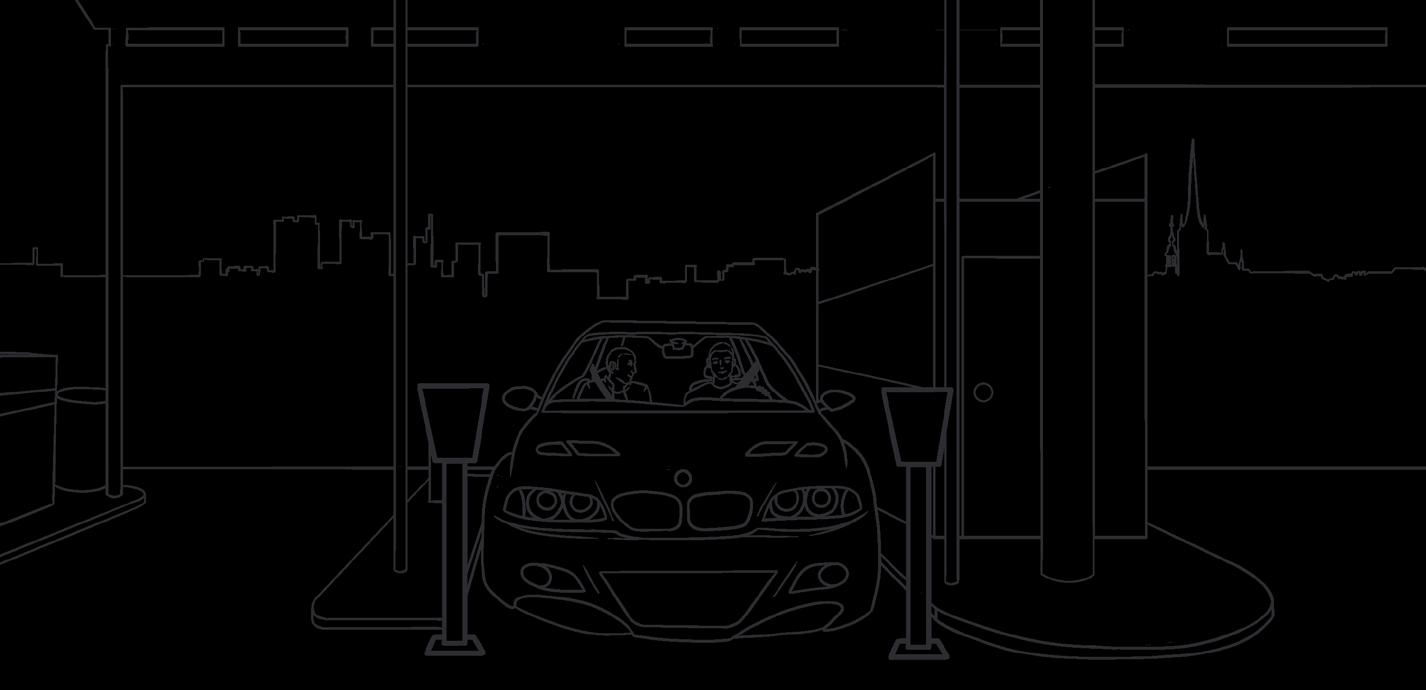

geopolitical landscape (the technology allows for connecting biometric data with international security databases to swiftly identify potential security risks).
These scenarios illustrate just a fraction of the potential that digital identity verification holds for transforming the operations and experiences in smart ports and ferries (only creativity sets limits for new use cases!). Digital identity verification isn’t just an add-on; it is a fundamental shift towards secure, efficient, and personalised maritime travel and trade. Furthermore, in a world still reeling from a global pandemic, the role of digital identity verification in
disease prevention – be it through mask detection or health passport validation –cannot be overstated.
Yet, transitioning to digital transformation doesn’t come without its challenges. Intelligent biometric systems are just one piece of a larger puzzle. Successful transitions require seamless integration

with existing applications, robust business rules, stringent cybersecurity measures, and leveraging data for continuous improvement. It may sound laborious –demanding, above all, a holistic approach for successful implementation – but it is by far and large doable and has what it takes to make a port truly smart.
Nortal is a fast-growing, impact-driven global company and a strategic partner for governments, healthcare institutions, the maritime industry, leading businesses, and Fortune 500 companies. With a solid physical presence in North America, Europe and the Middle East, plus an international talent pool, the company can shape tailored ecosystems and future solutions that are human, data-driven, and safe. Go to nortal.com/smart-port-solution to learn more.

TECHNOLOGY 1/2024 | Baltic Transport Journal | 85
Photos: Nortal
Dual benefits of digitalisation steer shipping towards environmental and economic sustainability
The power of partnership
by Casper Jensen, CEO, Danelec
As a primary stakeholder in global logistics, the maritime industry is facing an unprecedented transformation. It is an industry responsible for the majority of the world’s trade, so the urgency to innovate and adapt vessel & fleet operations to reduce carbon and other greenhouse gas (GHG) emissions and bring forth more streamlined and cost-effective operations has never been more pronounced.
While modern ships are technology-led, and vessel data informs many operational and business decisions, the adoption of true digitalisation must accelerate if together we are to create solutions to the most pressing challenges we face today, the most important that humans have ever had to face. Fortunately, the demand for maritime digital solutions is already snowballing. High-quality, highfrequency data collection from ships is needed, and industry partnerships and extended collaboration are key to making it happen quickly and effectively.
But the path to a sustainable maritime future cannot be navigated by any single entity alone; it demands a united front, a convergence of the best minds and technologies across the industry. Partnerships between leading innovators that encourage a platform-agnostic, more open approach will make it possible to break down barriers and silos, actively building bridges towards greener shipping at a pace and scale that no organisation can achieve singlehandedly.
There is no other way
With an increasing pull for transparency from consumers, cargo owners across the globe are amplifying the push toward sustainability. They are doing this by setting science-based targets that cascade down the value chain, significantly impacting
the maritime industry. Cargo owners are increasingly transparent about their carbon footprint, demanding reduced emissions in shipping their products. In this competitive landscape, digitalisation emerges as a crucial factor for staying ahead.
The maritime industry, traditionally a conservative sector, now recognises that harnessing the power of digital technology is the only way to remain competitive. In fact, in a study conducted by Informa Engage, 69% of shipping companies were shown to be actively seeking to expand their digital focus.
Digitalisation goes beyond compliance with environmental standards: it unlocks the potential of vessel data to drive both economic and environmental sustainability. By efficiently analysing and utilising vessel and fleet data, ship operators can optimise fuel consumption, reduce emissions, and enhance operational efficiency. This not only leads to cost savings but also positions companies at the forefront of the industry’s green transition (which also increasingly helps to win business). Embracing digital solutions thus becomes a dual benefit for maritime operators, aligning economic goals with environmental responsibilities and setting new sustainability standards for the businesses and organisations that underpin global trade. End customers gain, too, by having their goods delivered safely, on time, and in an environmentally friendly way.
Further positivity comes from the financial sector, which has also started to take more interest in what the maritime industry is doing to reduce its climate impact. The Poseidon Principles, for instance, provide guidelines for responsible lending, aligning ship finance portfolios with the International Maritime Organization’s (IMO) GHG reduction objectives. This trend underscores the importance of standardising environmental reporting, challenging the traditionally secretive culture of the maritime sector and necessitating transparency in sustainability efforts. This is, of course, another tick for integrating more digitalisation into the very foundations of the shipping business.
Catalysing challenges
Digital adoption in maritime is accelerating. Yet, the full potential of vessel data remains largely untapped. Currently, empirical ship models process only a fraction of the available information, compared to artificial intelligence (AI) models, which can go through a much larger dataset to generate accurate performance insights.
In this context, the integration of comprehensive digital solutions becomes necessary. Using its already significant data handling and transfer experience, Danelec is making strides in this direction, leveraging onboard data capturing capabilities and advanced analytics to offer turn-key solutions. These

86 | Baltic Transport Journal | 1/2024
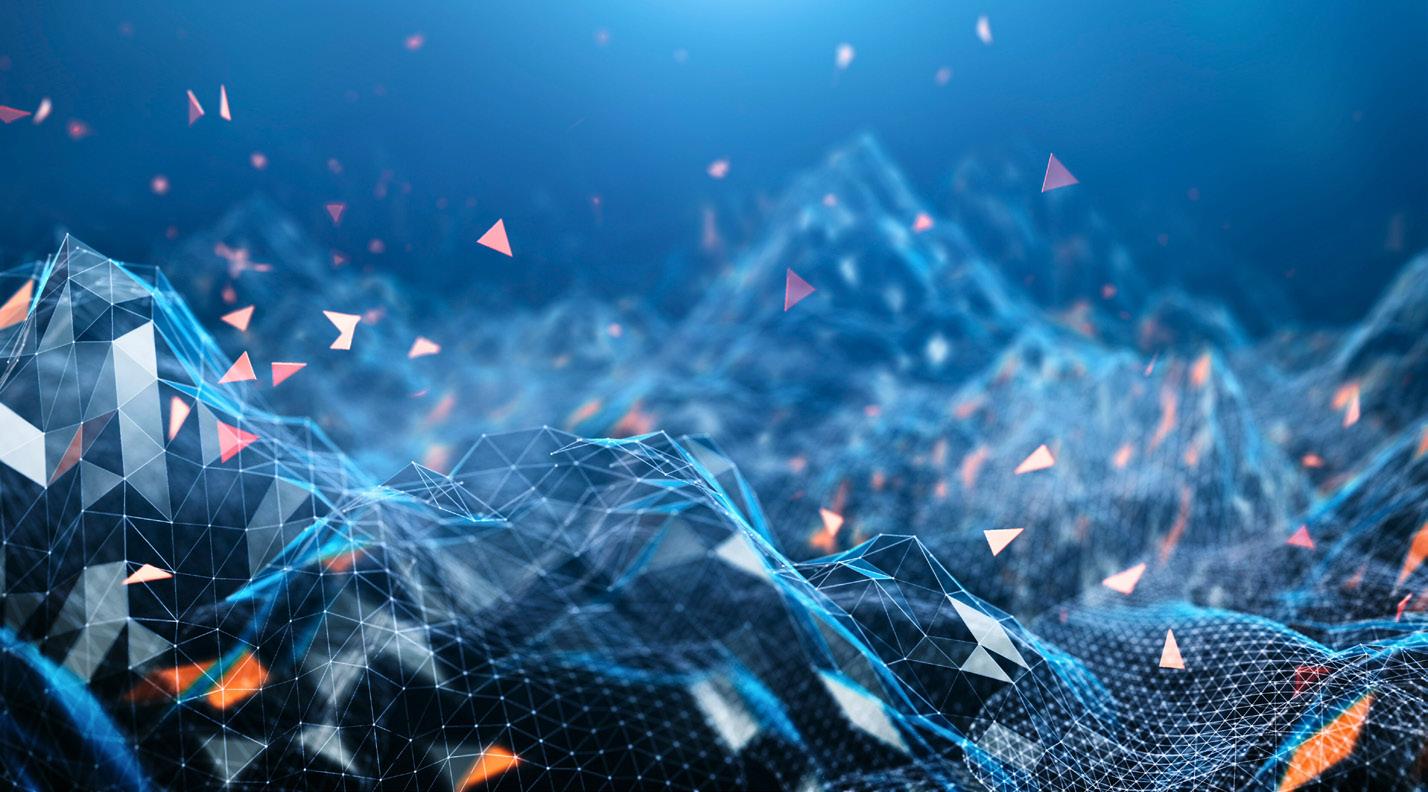

not only support but also accelerate the green agenda in maritime operations. Our company’s acquisition of the AI technology platform from Nautilus Labs further enhances the ability to deliver end-to-end solutions, from data capturing to in-depth AI-powered analytics and insights, which – when applied across vessel and fleets – can pave the way for more efficient and sustainable global trade.
Looking ahead, the path to a more sustainable and efficient maritime industry involves not only technological advancements but strategic decision-making. In the case of Danelec’s work to develop and
implement digital solutions, the focus remains on creating a framework that supports the industry’s evolving needs while driving towards operational excellence and environmental stewardship. Inviting our peers to embrace the power
of partnership as the most effective tool to achieve a cleaner, more sustainable maritime industry is essential to this strategy.
Such a collaborative mindset is vital in propelling us toward sustainability at a speed and scale that no single organisation can achieve independently. It is about harnessing collective strengths to address the colossal challenge of decarbonising shipping, a task that is as daunting as it is critical. Another key enabler will be a more agnostic and open approach to technology interoperability. Many of today’s digital systems continue to operate in their own silos, but unlocking the true potential of vessel data will require interfacing and integration with any sensor or platform, regardless of the manufacturer or solution provider.
With progress on future fuels and other efficiency-enhancing technologies barely keeping up with the IMO targets, it’s clear that the maritime industry is at a crossroads, facing both challenges and opportunities. As we (e-)navigate these waters, the role of digitalisation becomes increasingly vital. With the right technical and digital approach, it’s still possible to transform these challenges into catalysts for innovation and progress, ultimately steering the maritime industry towards a more sustainable and efficient future.
Danelec is a Danish scale-up operating at the forefront of maritime digitalization. With focus on innovative solutions and technology, the company is transforming maritime operations, and driving efficiency and safety for ship owners and operators worldwide. Onboard data collection incl. VDR and Shaft Power Meters as well as Ship Performance Monitoring and AI-based Analytics for Vessel and Voyage Optimization are Danelec ’s key areas of expertise. Visit danelec.com to learn more.

1/2024 | Baltic Transport Journal | 87
Photo: Canva
Casper Jensen; photo: Danelec
Investigating
The first step before a quantum leap
by Dr.-Ing. Anisa Rizvanolli, Team Leader Maritime Scientific Computing and Optimization, Fraunhofer CML
Quantum computing can significantly reduce processing times. With the Quantum Computing for Shipping and Maritime Logistics project, funded by the City of Hamburg, the Fraunhofer Center for Maritime Logistics and Services CML is investigating the potential of this future technology.
Most of the real-world problems in maritime logistics –such as network optimization, load planning, weather routing, staff scheduling for medium and large fleets, as well as crane optimization, berth allocation, and how yards run – are inherently difficult to solve but highly relevant for daily port & shipping operations. In most cases, these challenges are tackled manually, which entangles the workforce in long processes that cannot deliver a solution on the fly. In addition, the final answer, though workable, doesn’t necessarily have to be the best one.
Decision support systems can boost operational efficiency by providing fast – and sound, if not optimal – solutions. One of the main steps towards smooth troubleshooting is the formalization and analysis of the to-be-solved optimization
problems. The next challenge lies in the development of methods that can deliver a sound solution for such complex issues – and do it naturally within a reasonable time frame.
Quantum computing promises to accelerate optimization problem-solving. To assess the possible advantages of this technology, Fraunhofer CML is formalizing relevant problems from operational practice to evaluate whether quantum computers can offer an advantage over not only pen & paper methods but also standard computers.
The travelling bulker problem
To that end, we’ve developed a demonstrator that presents practical use cases in the maritime sector and enables the comparison of classical and quantum solutions with one mouse click. Real-world issues are modelled as mathematical optimization
problems and tailored to suit specific computing systems and algorithms. The application is user-friendly, and the solutions are clearly visualized.
Benchmarking, in which the solution performance of a quantum vs a standard computer is compared, will be more than informative in respect of the proposed goal. Fraunhofer CML is making such a comparison for the so-called maritime inventory routing problem (MIRP). Specifically, it involves efficient route planning for bulk carriers to supply different locations with limited storage capacities.

88 | Baltic Transport Journal | 1/2024
The solution to a given MIRP is a plan that includes which ship is at what port and when, whether loading slots are available, and how much cargo it loads or unloads at a port in any given unit of time – all of these parameters can be optimized. Various constraints for ports (e.g., handling the benefits of quantum computing in maritime logistics
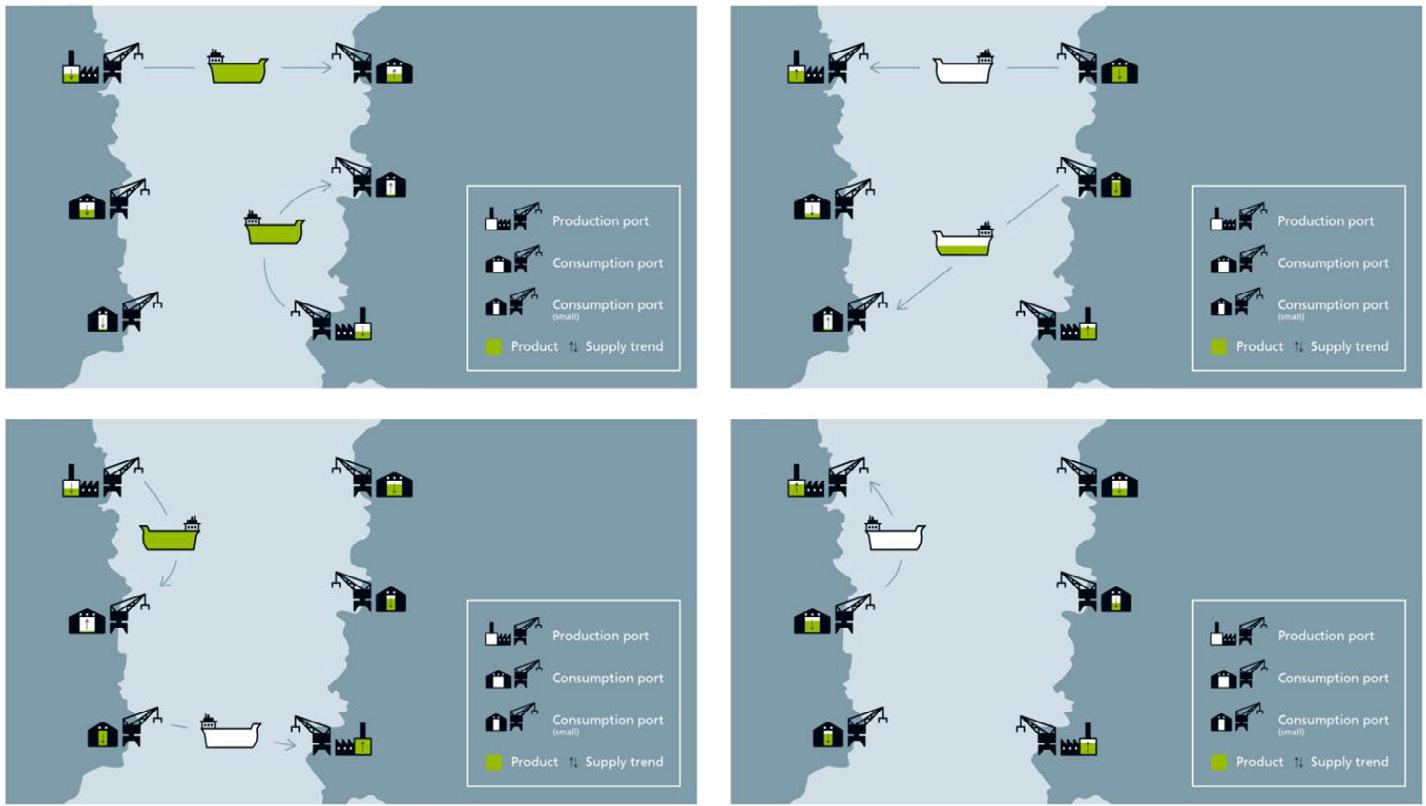

capacity) and compatibility requirements between ships and ports are considered. Additionally, restrictions regarding the loading can also be taken into account, e.g., when some shipments cannot be transported together on the same carrier or without a cleaning in between. The problem is characterized by a very large number of possible solutions that grows exponentially with the number of inputs (ships, time frame, ports, etc.).
Quantum annealing is used to run the calculations. This intermediate technology is currently more technologically mature than universal quantum computers. Quantum annealers are special-purpose machines that can only solve a specific class of combinatorial optimization problems. In comparison to gate-based universal quantum computers that are characterized by a small number of useful qubits, quantum annealers are more powerful, but only for
particular purposes (not all kinds of problems can be mapped to fit into the requested structure of the quantum annealers).
The MIRP demonstrator is a starting point for the development of customerspecific solutions for any routing and network optimization. The Fraunhofer CML thus offers low-threshold access to quantum computers and facilitates the assessment of the potential of this technology for the maritime & shipping industries.

TECHNOLOGY 1/2024 | Baltic Transport Journal | 89
Photo: Fraunhofer CML
The Fraunhofer Center for Maritime Logistics and Services CML develops innovative solutions for the maritime sector and the maritime supply chain. We support companies and institutions from shipping, port management and logistics in initiating and implementing future-oriented technologies and processes. Visit www.cml.fraunhofer.de/en.html for more details.
Fig. 1. Illustration of the maritime inventory routing problem
Ships come & go, danger always lurks
The latest war on transport waged by the Houthis in the Bab-elMandeb Strait (the Gate of Grief/Tears – how telling!) reminds the 1967 Six-Day War, which closed the world’s main shipping artery for eight years. An online search for an image to depict that event led us eventually to a... desk drawer! The presented print comes from the collection of the late Jerzy Miciński, editor of the monthly magazine Morze ( The Sea). It is a letter sent by the chief engineer Jerzy Ciesielczyk from the Great Bitter Lake in 1972. Wait, from where exactly? The 1967-1975-clossed Suez Canal that got over a dozen of ships trapped. The image came as an illustration of a letter carrying a story about a buoy that’s visible in the foreground. As a top-mark, it bears the logo of the Great Bitter Lake Association that united the crews of the stuck ships, with ‘14’ pointing to the number of the vessels (the moored-together as ‘islands’ Yellow Fleet as it became known – because of the dust covering them). Morze did not provide a caption, nor did it name the background ‘island.’ So, starting from the right, we have the German Münsterland (Hamburg-America Line – HAPAG) and Nordwind (Hansa Line), the Swedish Nippon (Svenska Ostasiatiska Kompaniet) and Killara (Rederi AB Transatlantic), and the French Sindh (as trapped; later Essayons of Messageries Maritimes). These formed the largest ‘island’ of Müwinikes : about 54,300 dwt
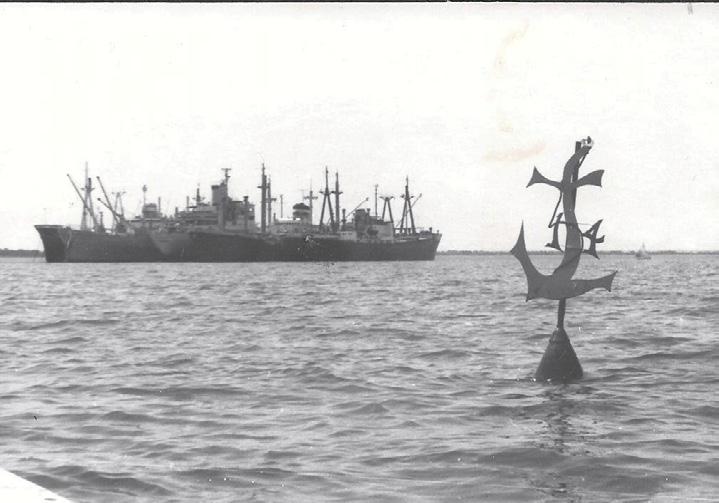
(so roughly today’s container carrier of some 4,000 TEUs). These classical general ships, with a forest of masts and derricks, passed away together with all the great company names mentioned in the brackets (although some disappeared because of mergers!).
Ships have their fate, too
“Habent sua fata navibus,” a Latin phrase (originally about books, so “libelli” instead of “navibus”) springs to mind when looking into the history of 12 small passenger ships built by the Wisła Shipyard in Gdańsk in 1963-1969. They were of the PP-120 class (so ferries for 120 persons), mainly bearing female names. They served intra-harbour traffic in Gdańsk, Szczecin, and Świnoujście till the late 1980s. The early 1990s privatisation of state-owned operators saw them scattered in search of a new life. Two got scrapped, some cruised in other ports, and four were sold abroad. We already recalled the fate of Norwind (ex- Irmina), who took up a cultural gig by playing its stage prop role in The Flying Dutchman opera performed in the Klaipėda’s shipyard. Only (or as much as – it depends) four PP-120s have survived to this day. Three stayed in Poland, serving as cruising restaurants. The fourth, Balbina, never stopped performing her original job. Up until 2017, she had been carrying workers to the islandlocated Gryfia Shipyard. Two years later, Balbina could be found in… Stockholm! Renamed Emelie II av Hammarby Sjöstad, she plies in the livery of Ressel Rederi between the city centre (Nybroplan) and Hammarby Sjöstad. Emelie II (there’s also Emelie [without I] in Ressel Rederi’s fleet) received a new bow with a ramp, a stronger engine, and, as we expect, also a coffee bar. Polish ship-lovers have one more reason to visit the capital of Sweden. And as one can read on one of the posters inside Emelie II : “seascape or concrete, what do you want to see when you commute to work?” Now, that’s a rhetorical question if we ever saw one!

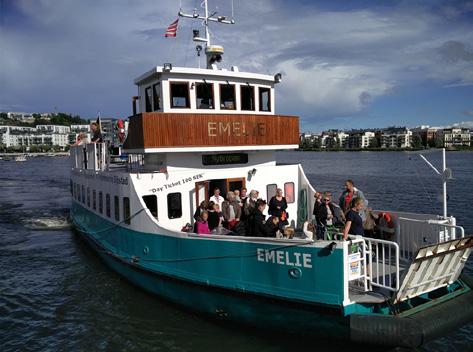
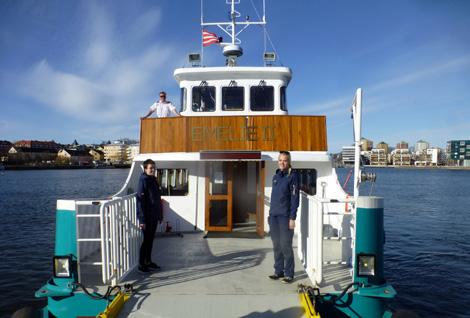

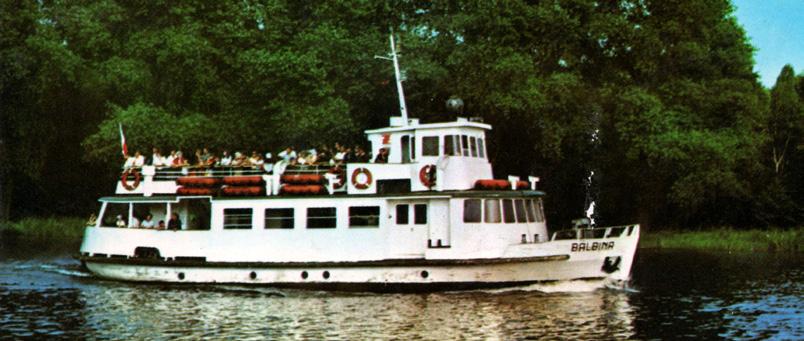

TRANSPORT MISCELLANY 90 | Baltic Transport Journal | 1/2024
Photo: Jerzy Miciński’s collection
Photos: Jochum Ressel/Ressel Rederi
Photo: Adam Daszewski’s collection
Flood-borne railway
A century had passed since a certain V. Kaskinen unlocked the camera shutter standing (or should we rather say sailing or paddling?) somewhere between the town of Hyvinkää and the village of Kytäjä north of Helsinki, capturing a flooded narrow-gauge (750 mm) railway that was 14 years old at the time (1924, so another 43 years of work to go). Like most European investments of this kind, it was a private, privately-operated railroad. This particular one linked the largest landed estate in the Nordics (16,000

hectares!) with a state-owned rail network. Empty cars with seat posts suggest that the train is coming west to the village for a shipment of logs or sawn timber (as most of the Kytäjä estate was covered by backwood). The passengers seem undeterred by the flooding (oh, the Finnish sisu!), which must have occurred frequently; yet, flood-no flood, the railway operated as if nothing had happened. Water seldom comes across as neutral: if it does no harm, it gives joy!
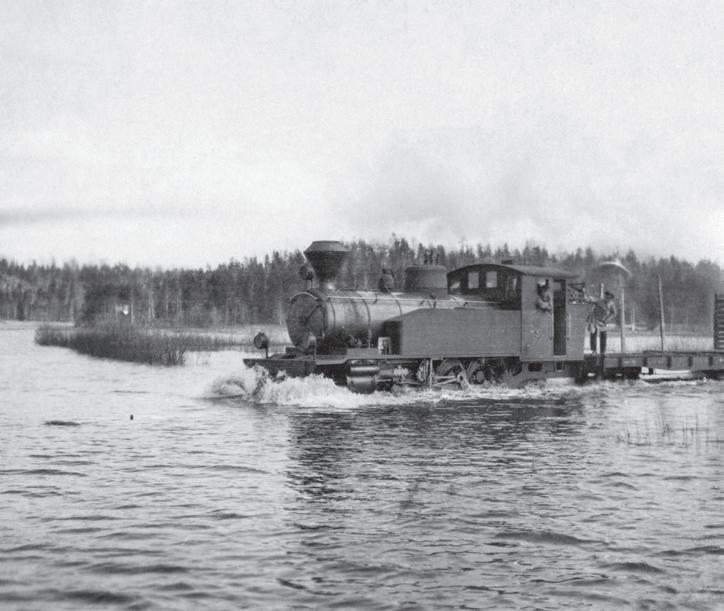
The first step towards world domination
A neat picture of the Douglas DC-6 Torkil Viking recalls not only the 70 th anniversary of the first ever scheduled flight over the Arctic – from Scandinavia (Copenhagen) to North America (Los Angeles) – but also a whole period after WWII when transcontinental passenger traffic exploded thanks to the availability of four-engine planes, delivered mainly by Douglas, Lockheed, and Boeing. Their huge production capacities, developed during wartime, found their outlet in the civilian market. The first regular service using landplanes – namely the Douglas DC-4, very similar to the depicted DC-6 – started in October 1945 and was operated by the short-lived American Overseas Airlines (AOA). TWA and PanAm were quick to follow, while their European counterparts, including the newly founded SAS, did not lag. SAS’s first flight from Stockholm to New York took place in September 1946, with the following month seeing a trip to South America. SAS started like AOA with the
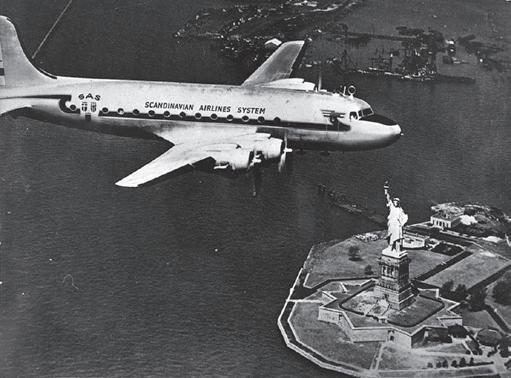
DC-4, which had an unpressurised cabin, replacing them with the brand-new DC-6 before long. Similar to its predecessor, it was intended as a military transport, but by the time the prototype flew, the war was over.
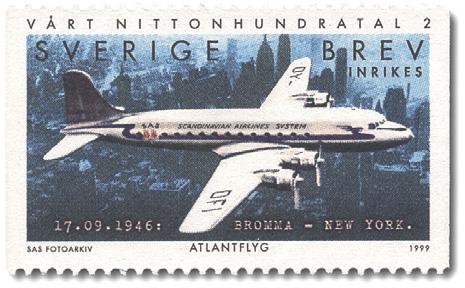
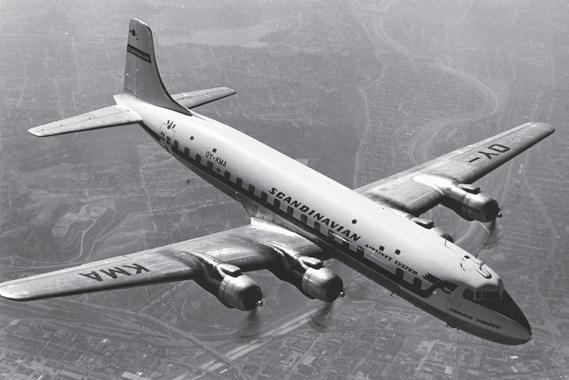
Douglas deftly redesigned it for civil purposes, equipping the craft with a pressurised cabin and with more powerful radial piston engines (which earlier powered famous fighters such as Black Widow, Corsair, Hellcat, Thunderbolt, and other fast military planes). But don’t be mistaken; the innovation of reliable transoceanic flights, made possible by the war, wasn’t enough to solve the demand puzzle created by the conflict that forced millions to cross the oceans. The supply side for returning soldiers, war brides, prisoners of war, refugees, migrants, etc., was still provided by shipping. We had to wait for the jet era to eject ship bunks in favour of recliners.

TRANSPORT MISCELLANY 1/2024 | Baltic Transport Journal | 91
Photos: Finnish Heritage Agency/V. Kaskinen
Photos: SAS

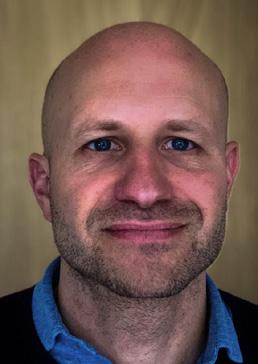
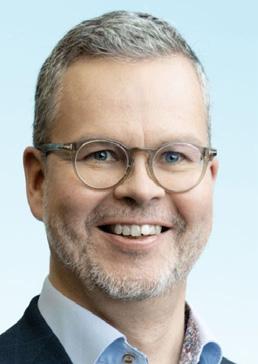

MARKUS ANDERSSON
Head of Operations, Port of Luleå
Andersson, a Chalmers University of Technology graduate, moved from its recent employment with the Swedish Maritime Administration, where he was responsible for operations in the Bothnian Bay, to one of Sweden’s northernmost ports. Specifically, he will oversee the operations of the Energy Harbour as Luleå’s tugboat. Andersson also worked for Infranord as a Project Manager and served as a Naval Officer in the Swedish Armed Forces.
WILLEM DIJKHUIS
Special Advisor, Seaber
The Advisory Board of the Finnish maritime tech company welcomed Willem Dijkhuis as its new Special Advisor. He has almost two decades of experience in the maritime industry, including nearly 14 years in chartering and trading at Cargill, where his responsibilities covered, among others, risk management, commercial time charter fleet optimisation, and decarbonisation projects. Earlier, Dijkhuis spent five years with MOL Europe handling Asia-Europe trade.
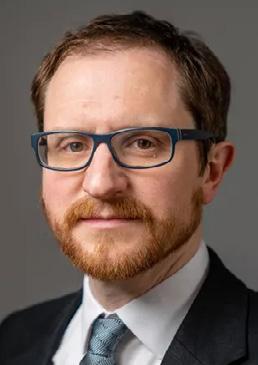
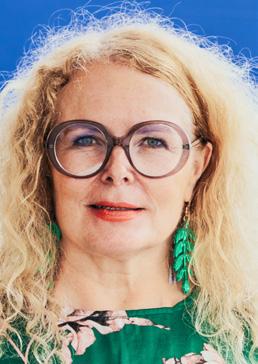
MIKKI KOSKINEN Vice-President, ECSA
ESL Shipping’s Managing Director (since 2013)
Koskinen joins the leadership of the European Community Shipowners’ Association (ECSA) as the first Finn for a two-year term (after which, according to the Association’s established practice, the Vice-President is elected as President). Koskinen chaired the Board of the Finnish Shipowners’ Association in 2021-2023, the organisation he has also represented on the Board of the International Chamber of Shipping for eight years.
KARIN ORSEL President, ECSA
The Vice-President of the European Community Shipowners’ Association (ECSA) was selected to lead the organisation for the next two years. Orsel became a shipowner and maritime entrepreneur at 23 and has been CEO of her ship management company, MF Shipping Group, since 2001. She was appointed President of the Royal Association of Netherlands Shipowners in 2017. Orsel holds an Honorary Doctor of Public Administration Degree from the Massachusetts Maritime Academy in recognition of her significant contributions to the industry.
NICK BLACKMORE
Director of Business Development, IAPH
Blackmore’s role will focus on the strategic and commercial development and marketing of the International Association of Ports and Harbors’ (IAPH) portfolio of products and services, including the Environmental Ship Index (ESI), the World Ports Conference, and initiatives relating to the World Ports Sustainability Program. Blackmore is already familiar with IPAH, having worked for the organisation on a consulting basis, a.o., creating the recent ESI white paper.
MERJA KALLIO-MANNILA
Head of Group Sales, Customer Service and Marketing, Finnlines
Kallio-Mannila, an alumna of the University of Jyväskylä, has been part of Finnlines’ Executive Committee since January 2022. She joined the company in 2001 and has since held several key management positions, most recently as Deputy Head of Group Sales, Customer Service and Marketing. Kallio-Mannila succeeds Staffan Herlin, who served Finnlines for 40 years and retired at the end of 2023.
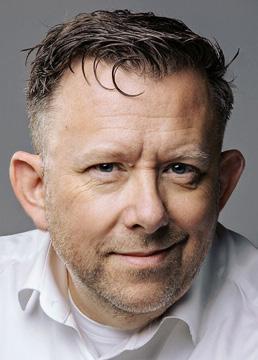
PETER LESCHLY Freight Manager, Scandlines
Leschly takes over from Gerald Lefold, who has been with Scandlines for three decades. Holding a master’s in business administration (strategy, organization, and management) from Copenhagen Business School, Leschly was recently employed by DSV as Business Development Director. Before that, he spent almost 15 years with Maersk (finishing there as Senior Director Maersk Operations) and over a decade at IBM (going from Project Manager to Senior Operations Manager).
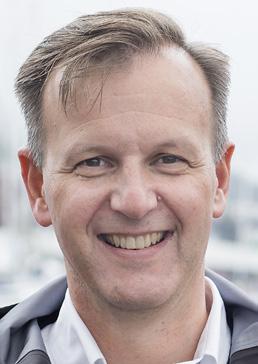
FREDRIK WITTE CEO, Corvus Energy
Witte, who holds a degree in finance from the Wharton School of Finance & Commerce (University of Pennsylvania), comes from the position of Managing Director of Cargill Aqua Nutrition’s operations in Norway, Scotland, and Canada. Earlier, he served as Chief Financial Officer for Rieber & Søn, was responsible for investor relations at Tomra Systems, acted as Financial Manager at Tomra North America, and worked as Key Account Manager at DNB.

WHO IS WHO 92 | Baltic Transport Journal | 1/2024

